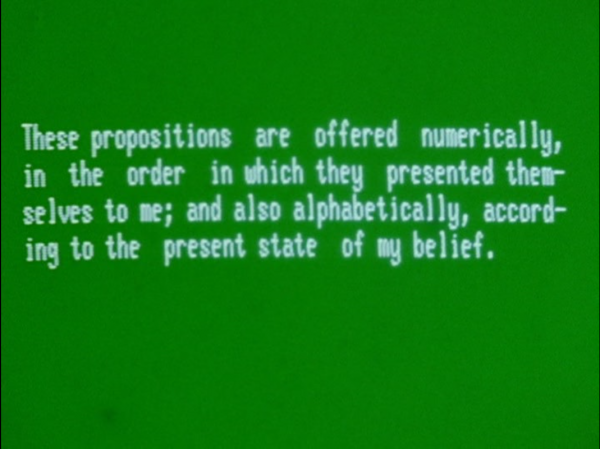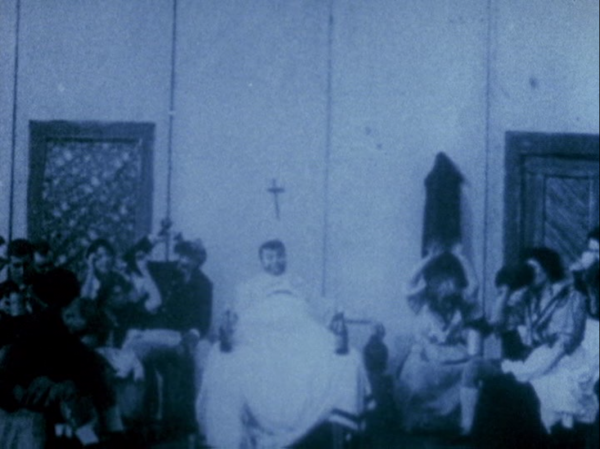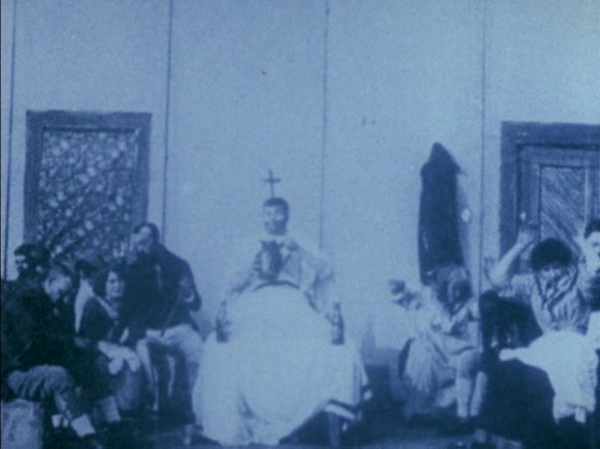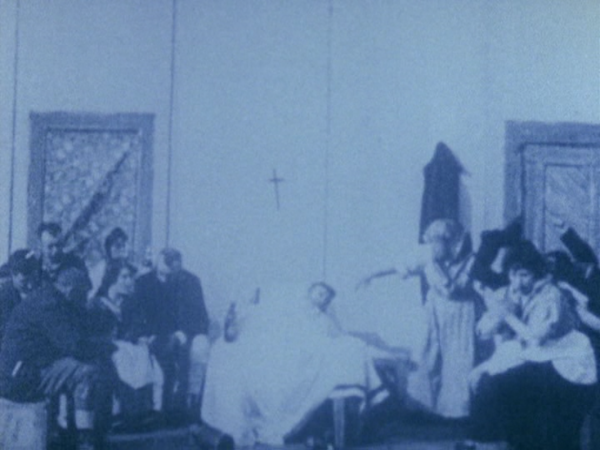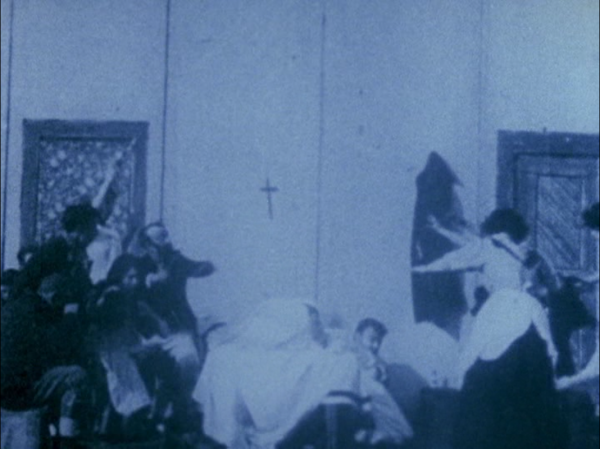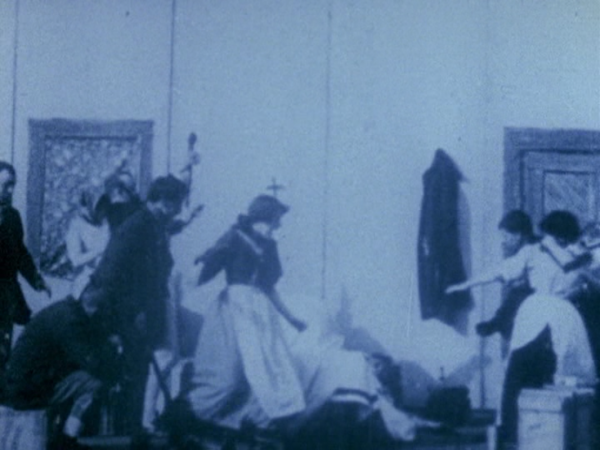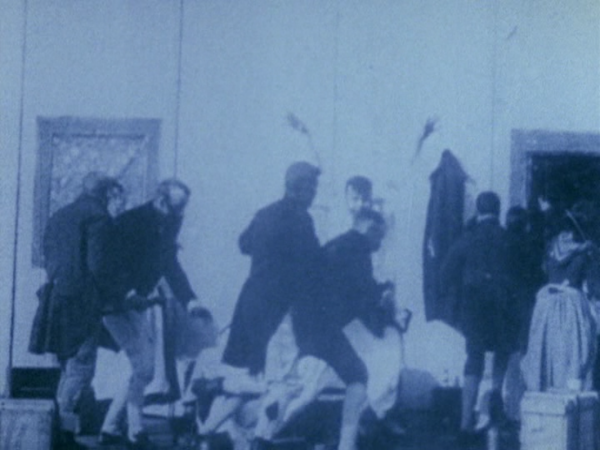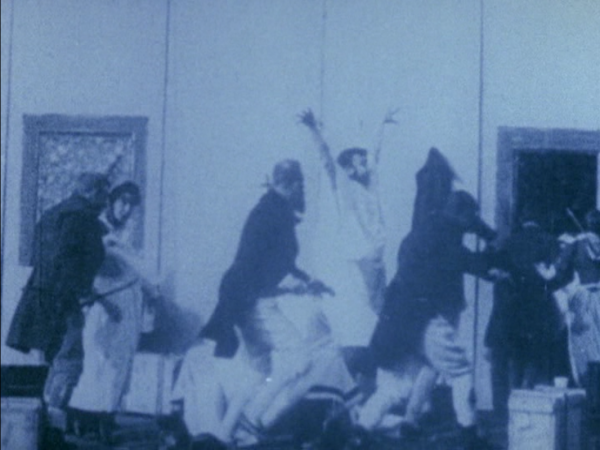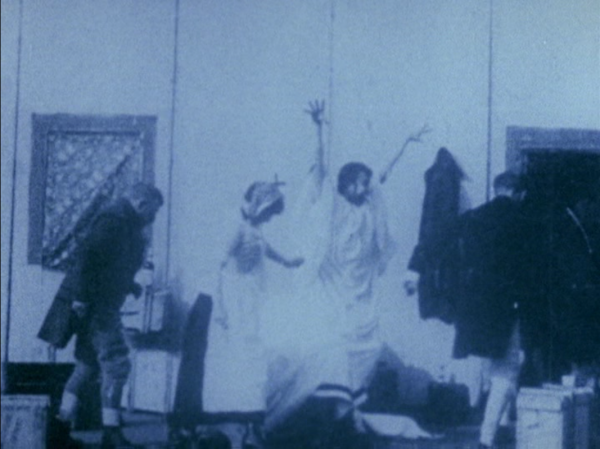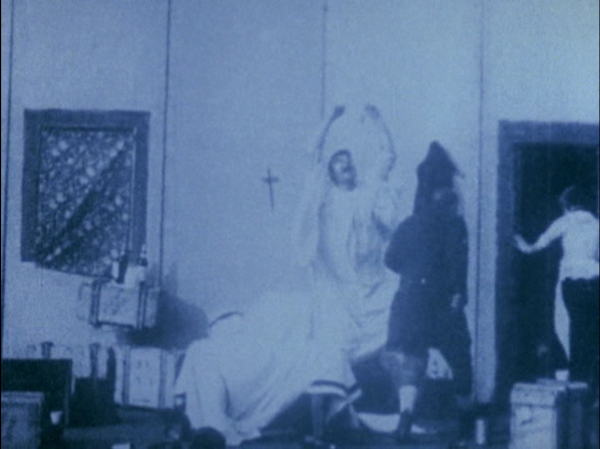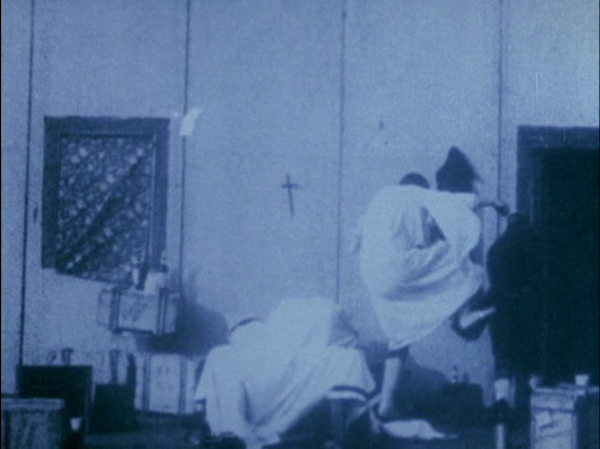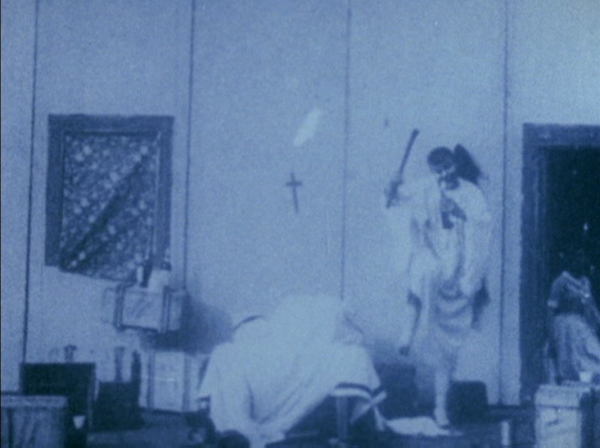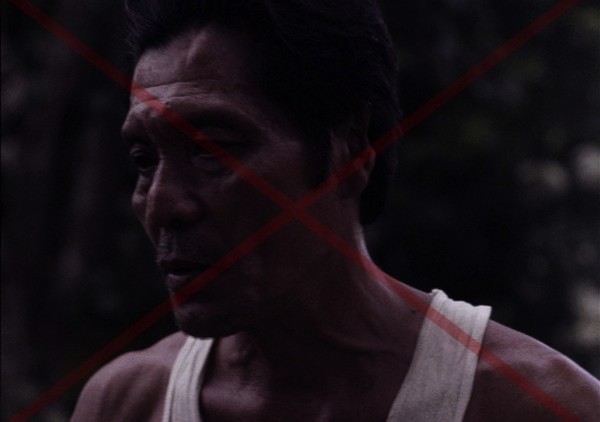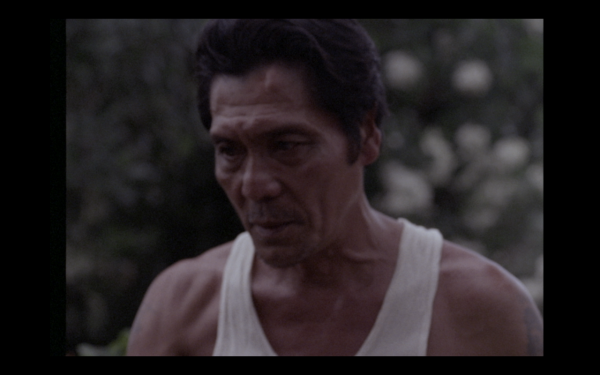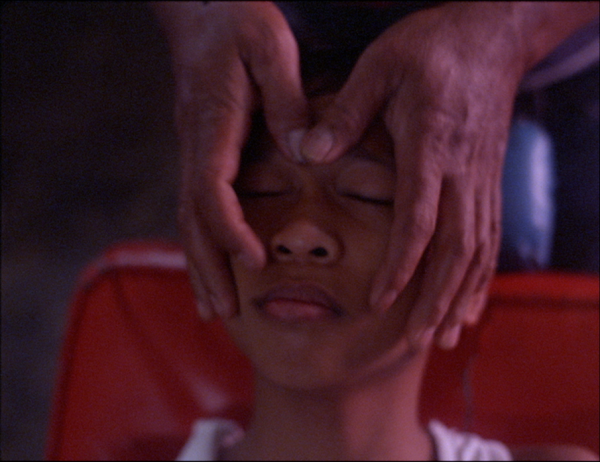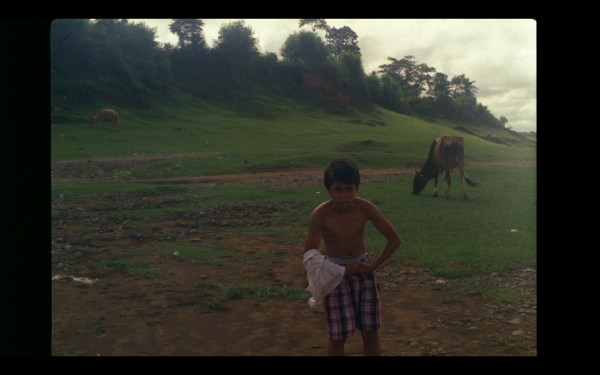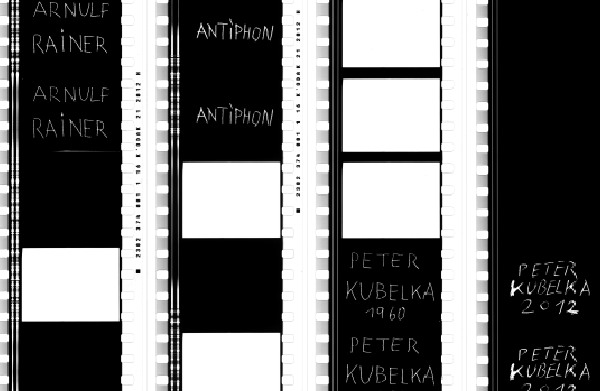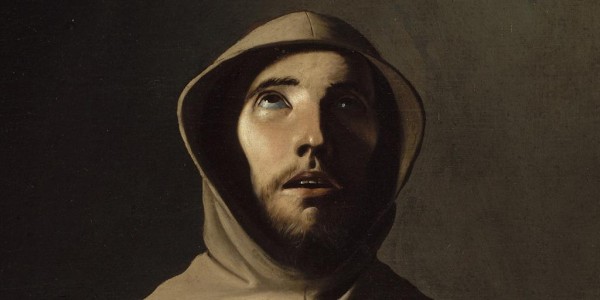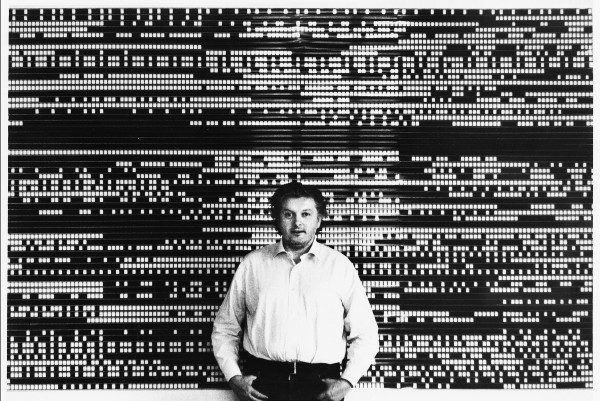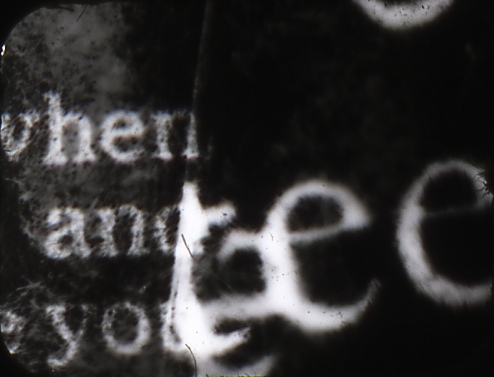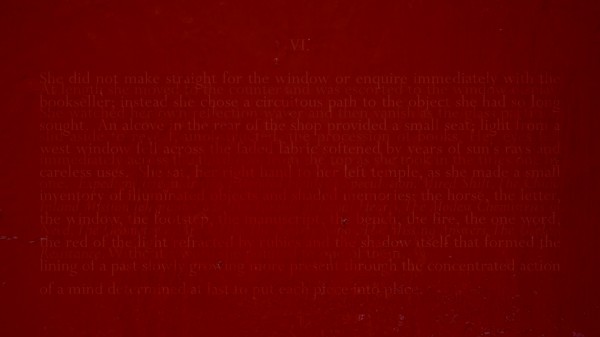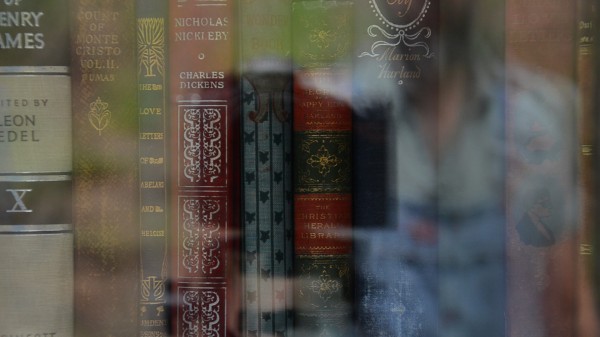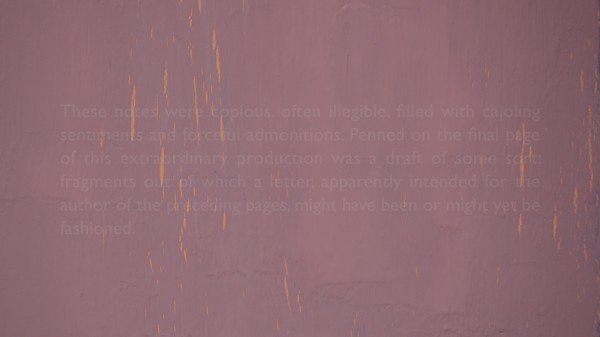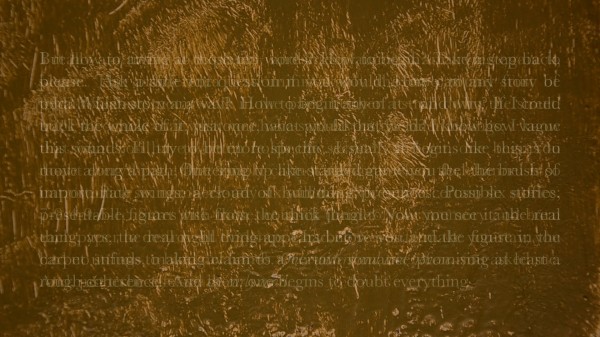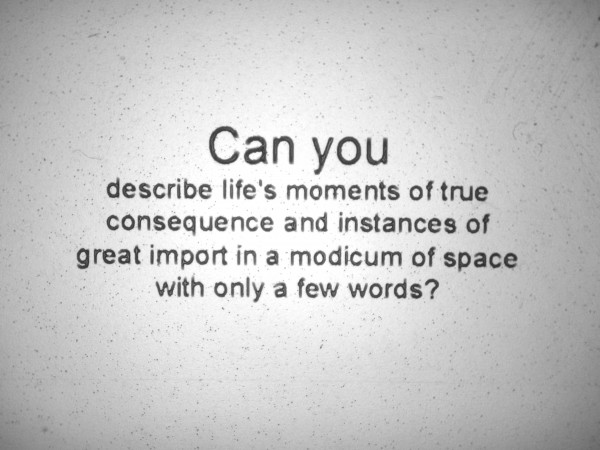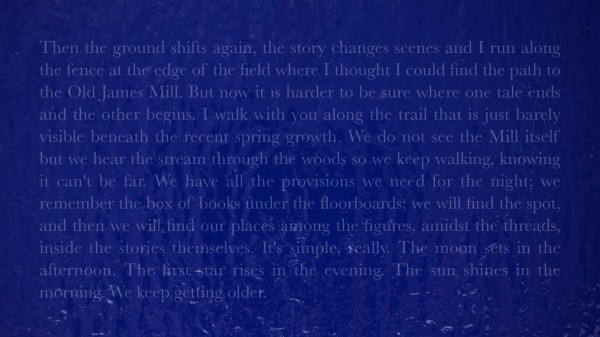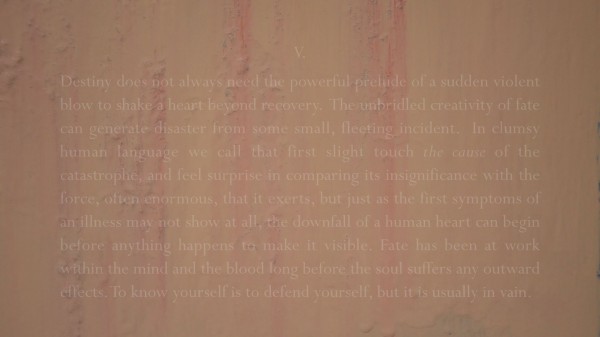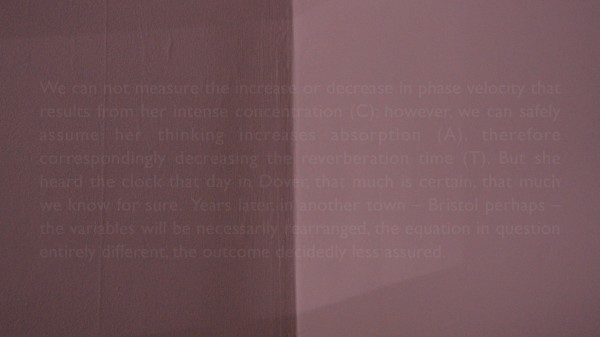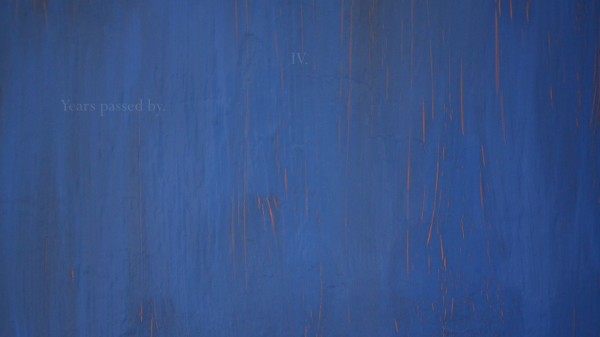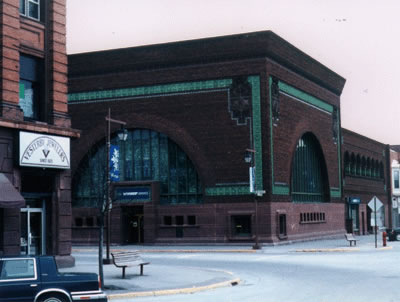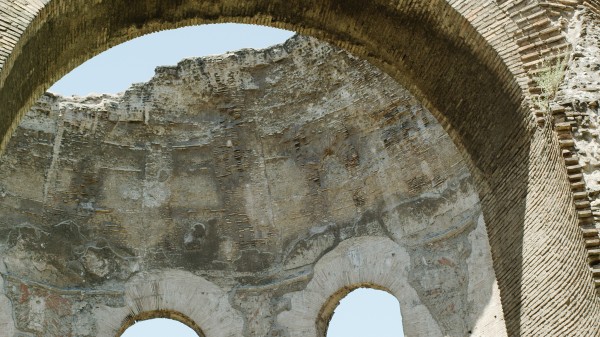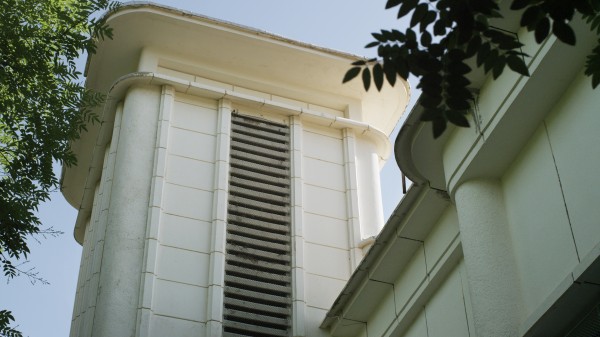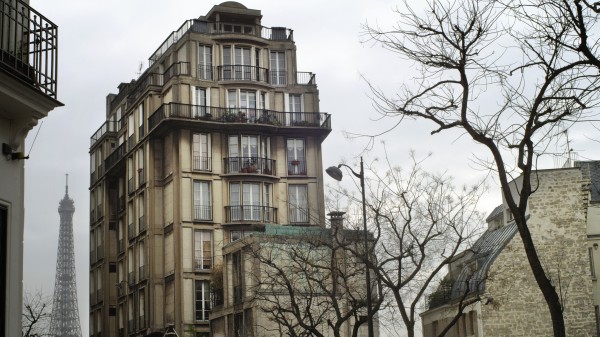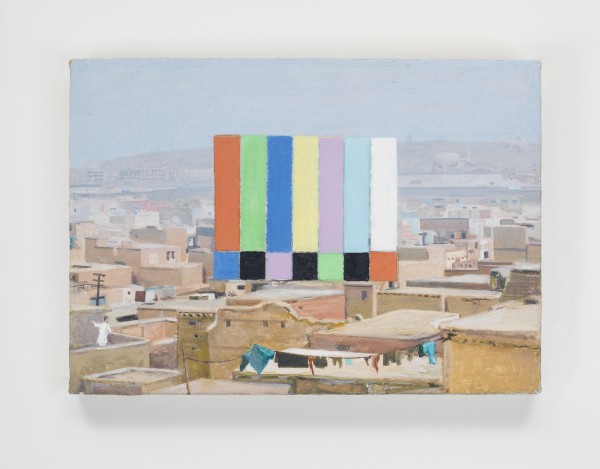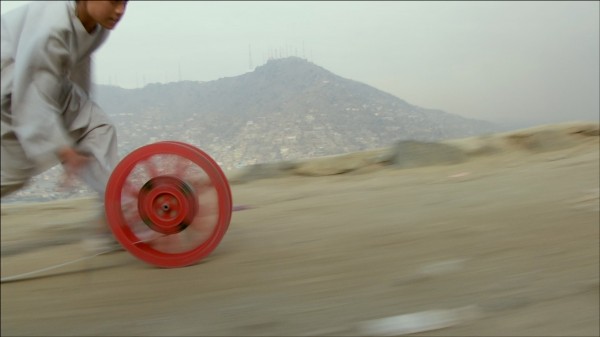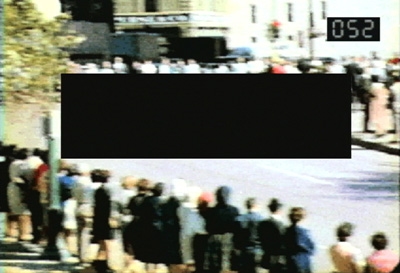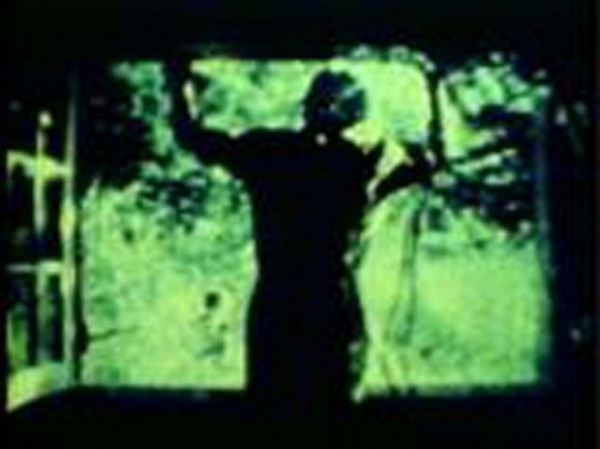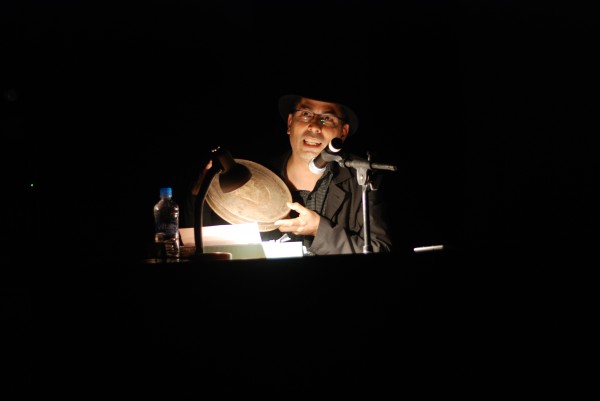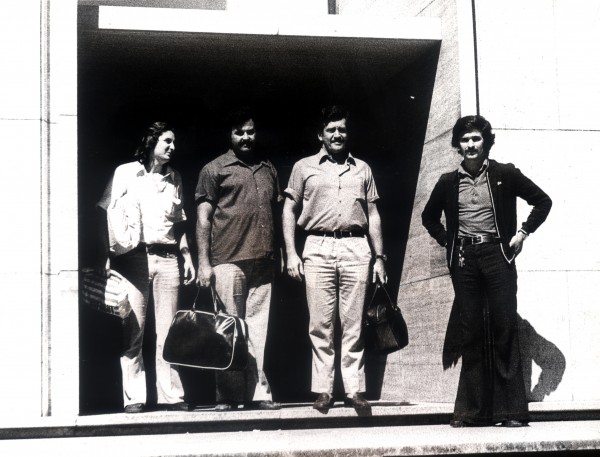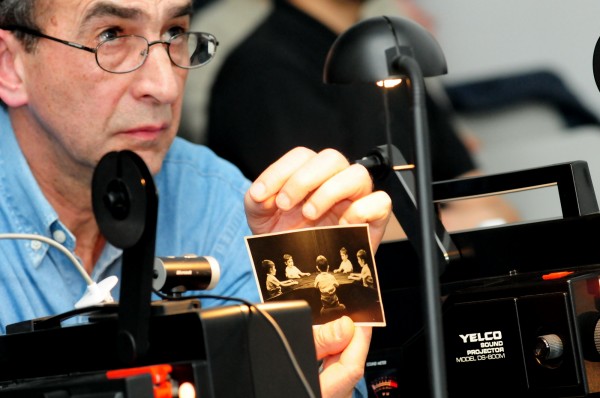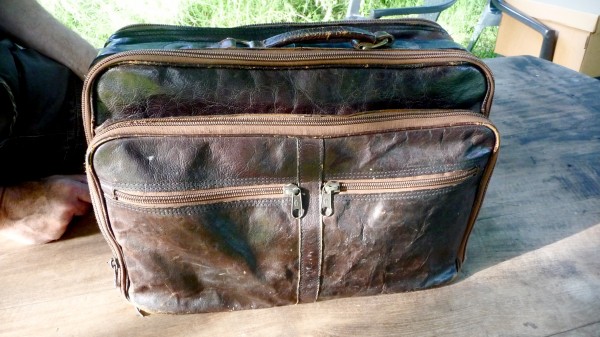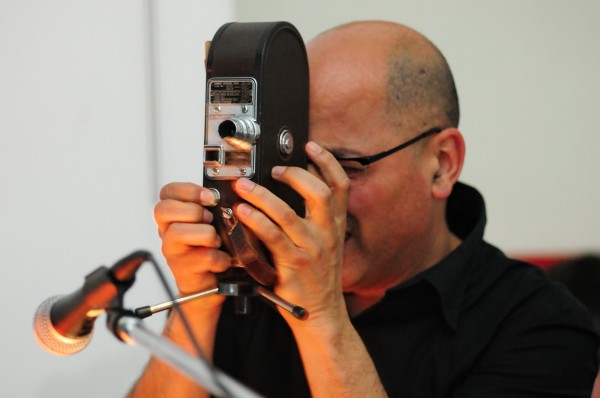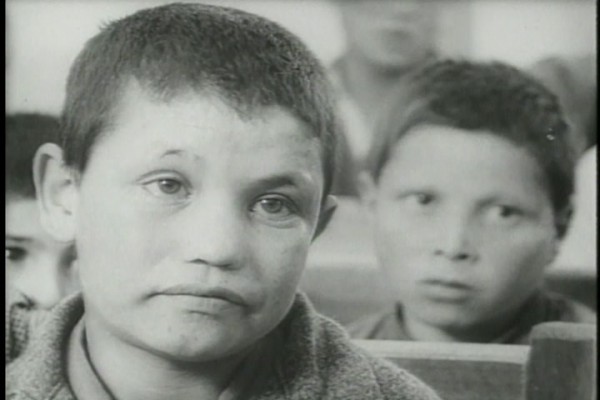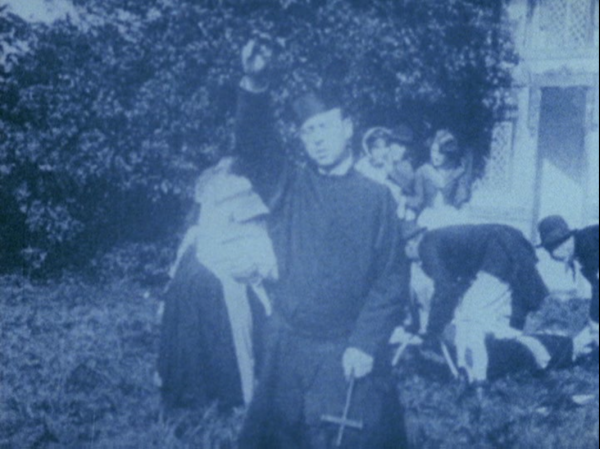
…graves at my command
Have waked their sleepers, oped, and let ‘em forth
By my so potent art.
— Prospero; The Tempest Act V Scene 1
An Irish ballad written in the mid-nineteenth century tells the story of a drunk named Tim Finnegan, who was taken for dead after falling from a ladder in an alcoholic daze:
[They] laid him out upon the bed
With a bottle of whiskey at his feet
And a barrel of porter at his head.
When his mourners get to drinking, the wake devolves into a town-wide brawl: “woman to woman and man to man.” Eventually a flying whiskey bottle shatters just above Tim’s corpse and, drenching him, revives him from death:
Timothy rising from the bed,
Sayin’: “Whittle your whiskey around like blazes!
Thanam o’n Dhoul! D’ye think I’m dead?”
In the silent-film re-enactments of “Finnegan’s Wake” that bookend Hollis Frampton’s 1979 short Gloria!, the ballad’s story plays out in broad, puppet-like gestures: dancing, weeping, fighting, limb-flailing. When Tim wakes near the end of the final clip, he waves his arms around like a boogeyman and sends his well-wishers scattering away. Left nearly alone in the frame, he kicks the last mourner out the door, raises his fists to the ceiling and leaps around triumphantly, clutching a bottle in one hand and a club in the other. These clips bookend two longer episodes. On a solid green screen, scrolling digital text spells out a series of sixteen “propositions” about Frampton’s maternal grandmother—including that “she remembered, to the last, a tune played at her wedding party by two young Irish coalminers who had brought guitar and pipes.” We then hear, against a now-empty green screen, that same tune played from start to finish.
Gloria! was the last completed component of an intended thirty-six-hour-long film cycle inspired by the travels of Magellan, whose literal attempt to “encompass all human experience,” as Frampton once put it, corresponded to the director’s own compulsion to leave no subject unfilmed, no technique untried, no medium unexplored. The film found Frampton looking forward in multiple senses: eagerly adopting new technology (digital interfaces; computer-generated text) and frankly anticipating his own death. At the same time, Frampton’s circumnavigation of human experience ended up taking him back to his earliest childhood memories, his family history, and the origins of cinema itself. Gloria! begins and ends with a resurrection: a moment when, there being no more future to anticipate, life rewinds itself and begins again.
How is it possible, Frampton seems to be asking, to organize something as elusive and circuitous as memory into sequential thoughts? Frampton’s attitude toward remembrance in Gloria! is almost mathematical, as if the past were a series of facts to be manipulated and derived. At the same time, he’s careful to distinguish between the mushy, vague language with which we often talk about memory and the ambiguities built into memory itself: “these propositions are offered numerically,” reads the first line of onscreen text, typed out in start-stop keyboard rhythms, “in the order in which they presented themselves to me; and also alphabetically, according to the present state of my belief.” The structure(s) of Gloria! are meant to account in equal measure for time as it exists in the abstract—a linear, unbroken, one-way progression of minutes, seconds, and hours—and for time as it’s actually experienced by those subject to it: jumbled, overlapping, doubling back. The tension between these two competing structures is, Frampton suggests, essential to the logic of memory, where every moment exists in theory as a single, unrepeatable entry in a linear sequence, and in practice as something stickier, more resonant, available to be savored and returned to at length.
It’s also, by extension, the logic of the movies, which remind us of the temporal distance separating us from their subjects even as they make the past seem like something tangible and close. It’s possible for us to be so swept away by this second illusion that we forget the fact that precedes it; so taken with a film as it plays itself out in the present, our present, that we overlook its essential point of origin in the past. Occasionally, a cut will cue us into the illusion, remind us that the footage we’re watching isn’t so much a natural emanation of the present as a re-animated, re-assembled product of the past, stitched together from moments of dead time. I’m thinking, for instance, of the abrupt leap in Ford’s Young Mr. Lincoln from a springtime courtship to a graveside vigil, or the cut late in Ozu’s Late Spring that displaces a moment of father-daughter tenderness in favor of the daughter’s marriage to an unseen and unloved groom. There is something cruel, final, and decisive about these cuts; they are about the impossibility of clinging to the present and the equal impossibility of returning to the past. Just as Lincoln can never revive his beloved, we can never return to that moment when a young Henry Fonda stooped by a studio-built grave at the behest of a pre-Searchers, pre-war John Ford.
The computer-generated text that occupies much of Gloria! deals in concrete, vivid details: we learn that Frampton’s grandmother kept pigs in the house, though never more than one at a time; that she hailed from Tyson County, West Virginia; that she was obese; that she taught her grandson to read; that she “gave him her teeth, when she had them pulled, to play with”; that she gave birth to nine children, four of whom survived (all daughters); that she was married on Christmas Day at age 13; that, when the filmmaker-to-be was three years old, she read him The Tempest. And yet these bursts of digitized text, even as they point toward a specific point in time, keep that point at a threefold remove: by the time we encounter that woman reading Shakespeare to her toddler grandson, the scene has been filtered through Frampton’s imperfect memory, abstracted into a series of words and phrases, and digitally rendered by a process that further abstracts those words and phrases into streams of numerical data. With Gloria!, Frampton was anticipating a time when information about the physical, time-bound world would be stored outside that world, in an immaterial digital space made up not of ink, matter, or sound waves but digits and pixels. But he was also, I think, encouraging us to consider that scene between grandmother and child as if it existed independently of any one set of digits, pixels, letters, words, or grains, in a space outside of time. The paradox, he suggests, is that such a space—if it did exist—would only ever be accessible to us through a material, time-bound medium.
Shakespeare critics have often taken Prospero’s abjuration of his magic near the end of The Tempest for the Bard’s own thinly-veiled farewell to the stage. If it is a goodbye, though, it’s also a kind of celebration. On Prospero’s part, it’s a statement of faith in the power of the wizard’s art to provoke storms, dim the sun and raise the dead (sixteen centuries after Lazarus and two before Finnegan). And on Shakespeare’s part, it’s a statement of faith in the power of words—if not to resurrect the dead, then at least to call forth their ghosts. The autobiography in Gloria! is both more explicit than that of The Tempest and subject to more layers of ironic distance. Even Frampton’s coming-to-terms with the idea of autobiography is winkingly impersonal: “she convinced me, gradually, that the first-person singular pronoun was, after all, grammatically feasible.” But no amount of tongue-in-cheek detachment or digitally-imposed distance could conceal the flesh-and-blood woman at the film’s center, who once scolded her three-year-old grandson for liking Caliban best out of all the cast of The Tempest, and who lives on in a space where time-bound images blur into computerized text: a brave new world that may or may not also be a world long gone.
]]>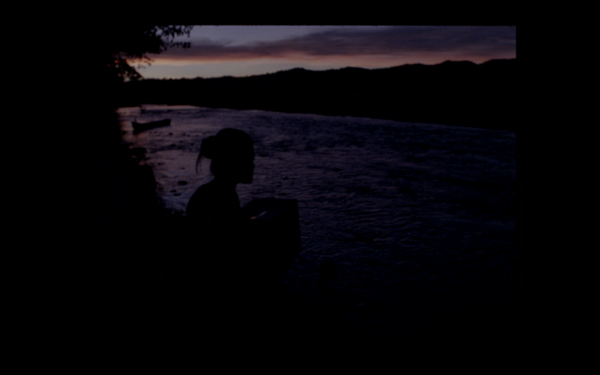
“Lukas, in the middle of the film, the actress will pay a visit. You’ll fall in love with her. And you’ll understand your father. I’ll become your memory. I haven’t shown you the middle yet.”
The words are spoken by a female voice over a black screen at the start of Lukas the Strange (2013). They make a promise while longing for a connection. It’s unclear who both this woman and Lukas are, though she leaves the sense that whatever distance exists between them will be difficult to breach. As the film continues, the voice promises to tell more about what happened—why a man left his family, why a woman grew so sad, and what was in the box that she threw into the “river of forgetting” that encircles the village. “These are things that need telling,” she says out loud, and then wonders, “But how can I tell Lukas without him forgetting?”
In all of the Filipino filmmaker John Torres’ films, stories exist to fill a void that lost memories have left, and throughout them all, the fear lingers that the void will remain. For the rural community in which his fourth feature film unfolds, a void exists in the form of an actress who’s disappeared from the film shoot underway there; for Lukas, a void also exists in the form of his father, who tells the 13 year-old, “Son, I am a tikbalang” before abandoning him. A tikbalang is a creature from Filipino folklore—half-man, half-horse. Lukas goes on to wonder whether he himself will grow up to be one then, as he dons a helmet to play a tikbalang in his town’s film shoot and casts himself in the image of a departed loved one.
Torres (who was born in Manila in 1975) had previously recalled lost loved ones in his second feature, Years When I Was a Child Outside (2008), which recreated his experience of having been separated from his father when he was young. Actors present a version of his family history, with Torres himself narrating from offscreen to “You,” creating the impression of a man reaching out to his younger self. This differed from how Torres had told his own story in the first-person in three early shorts that the critic Alexis Tioseco collectively labeled the “Love Films,” which circled around a longtime love relationship’s end. Yet even though their modes of address differed, the films shared the same impulse: to ease pain through storytelling.
Lukas the Strange, which received its world premiere at this year’s International Film Festival Rotterdam, also does this. Lukas is not just the first film work by an artist who has previously shot exclusively in video, but an overtly retrograde film in its recollection of earlier tales. Early on, brief deteriorated images appear of a young woman walking past villagers, including a young boy. These images, taken from the director Ishmael Bernal’s 1974 film My Husband, Your Lover, offer a prelude to a new work made with the grainy, occasionally flaring visuals and dubbed sound of Filipino films from the 1970s and 1980s. In drawing on this period, Lukas the Strange also invokes the years of the Philippines’ military dictatorship, during which a number of political dissidents were murdered before the military gave way in 1986 to corrupt, neocolonial democracy. As Lukas reenacts the role of his father, the present calls upon memory to help it fight absence and silence; at the same time, the film suggests the pain of remembering to be so great that some forgetting is needed. Like Torres’s other films, Lukas the Strange looks for the middle.
Tell me about Lukas the Strange, or Lukas Nino, as the film is titled in Tagalog. Is the English-language title a direct translation?
The title was supposed to be Lukas Niño [“Lukas Child”]. I was so lazy not to type in the “ñ,” so it became “Lukas Nino.” And “nino” in Tagalog means “whose.” So whose Lukas is this? Does he belong to creatures or to men?
Tell me about how you came up with it.
Man, that’s a hard question. Why do you ask me this?
Well, where did the film come from?
OK. Prepare. I’m going to try to make it really short. I have this film hero, the Filipino director Ishmael Bernal, who’s a contemporary of the better-known Lino Brocka. When festivals think Filipino cinema in the 1980s and 1990s, it’s Lino Brocka, but there’s this equally wonderful filmmaker, Ishmael Bernal, who made his most famous works around the same time. Bernal’s films have a subdued quality to them, a little dream-like, with many things that are unsaid but that you can feel nonetheless, things that are there if you look for them. He has a filmography of 40 films. Around the 15th or 16th title, there’s a lost film. It’s called Scotch on the Rocks to Remember, Black Coffee to Forget (1974). No one saw it, and I thought, “Fuck. The man’s dead, and no one’s even really looking for it.” I didn’t really care what it was. I was just concerned with a space that was left.
I initially wanted—Oh my God, this is going to be a long story. I initially wanted to write a story based on Bernal’s film titles. The sequence of film titles as you read through the filmography chronologically, such that every scene would correspond to a film title, either as a spoken line of dialogue or just looking to the poster of a film for the blocking of a scene. Eventually, though, as time went by, the finances that I had (this film was only supported by the Hubert Bals Fund) weren’t enough to have something very ambitious. I limited myself for the film before the lost film, which is called My Husband, Your Lover (1974). I took inspiration from its milieu and from its major characters and wrote a story. I took out one of the film’s major characters, an aspiring actress. A bit player, a boy seated in one of the scenes as this girl passes him, is Lukas. He is called that because Lukas is my favorite name.
So OK. This is where the milieu and the characters come from. Where another part of the film comes from is one night when I was drinking with a buddy of mine, who’s a poet. He was story-telling the whole night, beginning with, “John, my father, when I was young, told me he was a tikbalang.” A tikbalang is a figure from our folklore. He’s a half-horse, half-man, sort of like a centaur, and a prankster who makes other people lose their way so that they disappear. That’s key—they disappear. I was in a certain mood, and as my buddy was telling me all these stories from his childhood, I began thinking that he was like his father. And how could this possibly be?
At the end of the night we were tipsy. I asked him, “How can you think you are a tikbalang? How did your father tell you this?” And he corrected me: I had misheard one word, which changed everything. He wasn’t a tikbalang—he got tricked by a tikbalang. But by that point I didn’t care. Even in my previous works, I wasn’t fascinated with accuracy or with what really happened. I shot the film before Lukas Nino, Refrains Happen Like Revolutions in a Song (2010), in a land whose language I didn’t bother learning. I didn’t translate the peoples’ dialogue, I just imagined what they were saying and fictionalized everything. I even bastardized all the proper names that referred to their history on the island. I didn’t care. It was my story.
So OK. Cool. There is a third, very important place where Lukas Nino comes from, which is my own experience of watching Filipino films in the 1980s. I was consumed by all these cheesy genre cowboy Western Filipino romantic comedy action films. So consumed, but I also felt a deep self-hatred for liking them. It was an embarrassment. We weren’t supposed to feel proud that we liked this local product, and we are not even supposed to today, especially considering that you have this choice between this crappily-made Filipino film—no color grading, badly dubbed sound, music completely over the top—and slick Hollywood. But the uneven color and unsynched sound were important for me. I wanted to retain them, because they freed me. I’m not so concerned with plot or with story, what I want is feeling. There’s not much of a narrative in my film, I think. But I didn’t care. I just wanted to retain the feeling as a filmmaker wondering, “What if I shot like they did on film?” It’s this older aesthetic that I wanted to capture, even down to little things. For instance, in my film there are no fade-outs, just as there are no fade-outs in old Filipino films—shots start to fade, and then abruptly cut.
All this has to do with my experience of being a moviegoer in the 1980s, though other memories related to cinema have impacted the film as well. Aside from going to the movies when I was young, I got to experience waking up one day and seeing a famous film star on the first floor of our house. People were shooting a film, and she was crying, but only because there was a camera in front of her. Once she crossed the camera, there was a switch, and she wasn’t crying, she was smiling. She played to the crowd. I went out of the house, into the garage, and kicked at just one piece of paper, so that it fell out of position. A crew member told me not to do that again and put the paper back wherever it should have been. It was continuity, and I didn’t know, and I didn’t care, but everything in the house had been transformed. We had been transformed. All the bit players became different creatures and forgot their histories.
What interested you about the people in your film?
The place where we shot the film was my mother’s hometown. I spent summers there during my childhood, but I had not been back between then and making the film. When I returned I just knew that I wanted to talk to my relatives again and see how they had aged. I wanted to catch up on old stories. But I also wanted to be there and try to recreate in my mind how it was to be back in the province, which is around 12 hours north of Manila by bus. While I was curious about the place, I also felt so at home staying there.
Almost all the extras in the film are family members. Before shots, I would tell them the context for the scene—this is supposed to be a film shoot, and we’re shooting this film shoot, so just act normal. It was meant to be like we were casting. And we Filipinos are very, very close to this experience because with our soap operas and our films it’s normal to just have people being asked to play bit roles. They’re at home with this, so the asking is almost never a problem, and in this case there was no difficulty, either. We didn’t have formal discussions about what the film would be, nor about whether they would be paid for their work. They were just glad to be part of it, and wanted to have DVDs to watch when it was done.
The boy who plays Lukas is a nephew of mine who I never really got to know until making the film. Part of the reason for making it was that I was very interested in shooting him, and the film served as a good excuse. I discovered the actor who plays his father through a sort of chance encounter. After shooting for a few days, we realized that we had left something in Manila, so we had to go to the bus terminal to return. It was around 4 A.M., we hadn’t relaxed, we hadn’t slept, and then we suddenly saw this Elvis creature of a man who so rock-and-roll in his movements as he charmed all the women in a small eatery. I knew he was it—I had been looking for someone who resembled a tikbalang. And as it turned out, he was a distant relative of mine.
Tell me about the river of forgetting.
OK. OK OK. I have always vowed to make something simple and easily followable, but always, always, always the films are situated in my history, in our country, and in our past, and these things are not so easy to follow. The river, I think, for me, is a reference to the Marcos dictatorship that ended in the late 1980s. Because I grew up in a household that was largely Marcos loyalist, my picture of Manila was much cleaner than the city actually was. News of bodies disappearing, enemies of the administration salvaged and later found on the wayside, under thick bushes, or thrown in water, were rampant, but I still grew up believing that we needed one strong man, a dictator, to keep society in order. I then thought that we needed discipline as this “new society” moved forward along the road to progress. I was too young to experience needing to be home early because of curfews or having to join rallies. I never had anyone close in my family who was an activist, so I never really knew how it was to see loved ones disappear. But today I always hear of Marcos’s cronies and the military conspiring to take away civilians who were too outspoken against the administration, and when I was making this film, I was fascinated by how the ex-military men are living their lives now.
There’s a big representation in the film of what color people wear, red or yellow. In Filipino history, yellow stands for democracy, and red for dictatorship. (In the film the film crew wears red, and Lukas’s helmet is red and yellow.) I would always think that maybe those people who would want to forget are people like Marcos’s soldiers, who made other people disappear. I think it’s easier for them to forget. They’re wired for crossing the river. Not anyone can do it. It takes great strength and fortitude. I think that they’re the ones who really need to forget.
I was wondering about disappearing bodies. How can one person really think he is a tikbalang? Maybe there’s this cycle of disappearance in his life, and in the 1980s, salvaging people—meaning dumping them into fields so that they never get to be seen again—was done by Marcos’s police and soldiers. These military men are so much like the tikbalangs in my film. By throwing bodies into empty lots and fields, they have also made people disappear. I even imagine them looking like tikbalangs, their appearance mutating, similar to those changes in a soldier’s face coming home after his first experience of battle. Sorrow and guilt housed in a chest for years can mutate someone into a hybrid of man and beast.
So I was thinking maybe if we had the father as well as ex-military men, what if they were thrown into this island together? How would they be able to cope? They would need to invent a river so that they could forget, I thought. (Initially I didn’t know it, but I was making a reference to the River Lethe, which in Greek mythology can supposedly be its own river of forgetting—you forget things if you drink its water.)
And I also need the river. I think that part of the film is my saying that I don’t care about the wounds pain leaves behind. I think it’s much simpler to have this river instead. My past is contained there. Growing up, my father was my idol. He wrote storybooks for children and how-to books for adults, and he earned enough money for us to afford a better life than we would have had without him. I always put him on a pedestal. He was the reason I got started with video-making—he always spent so much on camera and other gear that I was able to start early and use cameras for school projects and practice editing well before college. But my father broke our hearts when I was a young man, when we learned that he had a secret life with another family that lived near us. This is explicitly the subject of my second feature, Years When I Was a Child Outside, but with Lukas the Strange, there is also much of my father in Lukas’s father.
So the river contains many things that have been lost. Lost people. Lost film. Lost instances. Lost moments. But we also find things in the river, like the tapes of this woman guiding Lukas and narrating his story.
How did you come up with the writing that appears onscreen?
First off, it’s very much ingrained with the process that I’ve set for myself, even with my short films. Inter-titles and subtitles are always onscreen. But with this project we decided that I would use inter-titles when the narrator had difficulty in admitting something to Lukas—something really serious that could change her relationship with him. There are also some things that cannot be said. She tells him, “There are some things that I can tell you, but there are some things that I can’t say.” And these things are presented as titles flashed onscreen while Lukas remains silent.
In my previous works, I have always had different starting points, although process-wise, I think that Lukas the Strange continues my desire to strip down what I have done so far and what I can do and see what else is there, so that I know what remains in my work and what changes in it. One particular difference from my previous work to this film is the use of my own voice for voiceover. Previously, I would always narrate, even in my short films. But I was really tired of hearing my voice all the time, and on this film I wanted to see how it initially was to tell a story without a narrator. Eventually, though, that didn’t seem right, either, and I felt the wrongness in my gut. I thought I was missing someone. I was missing my friend who was telling me about his father and about his true-to-life childhood. I missed this possibility of mishearing this narrator/friend, this chance to hear someone who might be making up or mixing up the story after all. I missed the confused voice of a troubled soul. And so I made a big, big creative decision to have this witness—or this friend/muse—narrate everything. This person who is everywhere, who is somehow remembering all these things—not exactly creating from scratch, or representing what really happened. She’s telling a story.
Do you believe there is love in Lukas the Strange?
There’s love. Love is my first instinct, my first impulse to do this. It’s always about this, in this film as well as in my others. And I can’t tell you in words how love is vital to them, so maybe the films are enough.
All images accompanying this interview were provided by John Torres. The interview was conducted at the 2013 edition of the International Film Festival Rotterdam, which also screened a film produced by Torres. Shireen Seno’s Big Boy tells the story of a postcolonial Filipino family stretching their first-born son’s limbs as far as possible in the name of progress.
]]>
Austrian avant-garde filmmaker and theorist Peter Kubelka likes to speak of the “now moment.”1 If you’re lucky enough to sit in on one of his legendary, inimitable lectures, you’re liable to see him illustrate these “now moments” with the ring of a Buddhist bell, or with a rhythm tapped out on a pair of Japanese woodblocks, as he chants contentedly his presentist mantra: “Now…now…now….” For Kubelka, it is the precise nature of the film medium to deliver twenty-four such “now moments” every second.
Of course, each of these “now moments” conceals eons of protracted labor: Kubelka’s work is some of the most exactingly wrought in all of cinema. In a 1967 interview with Jonas Mekas, Kubelka mused that his output to that date amounted to fewer than eight frames per day.2 (Later, he would only get less prolific.) This methodical precision inarguably lends his “now moments” an intense charge: one characterizes the films of Peter Kubelka in terms of impact, in terms of density and an explosive force which persists unabated upon the second, third, and fourth viewing. Mekas celebrated “the incredible artistry of this man, his incredible patience,” describing 1966’s bracing, incomparable Unsere Afrikareise as “about the richest, most articulate, and most compressed film I have ever seen. I have seen it four times and I am going to see it many, many times more, and the more I see it, the more I see in it.”3 Stan Brakhage recognized that “Kubelka takes a very long time making each film a lasting experience of the moment of enjoyment—so that each can be seen again and again for increasing fulfillment of the initial experience.”4 Both Brakhage and Mekas thus encounter the pressure of accumulated time in Kubelka’s constructions, a potential energy that, like a clock wound to infinite tension, proleptically sustains an unlimited number of viewings.
Indeed, though Mekas found something crystalline and organic in their compressed imagery, Kubelka’s classic works from the fifties and sixties strike me as elegantly, delicately artificial; clockwork-like, reflecting Kubelka’s enthusiasm for the lost art of the handmade timepiece. It is perhaps the grotesque song of the cuckoo clock which resonates in Unsere Afrikareise. In a comprehensive new documentary, Martina Kudláček’s Fragments of Kubelka, the now 79-year-old filmmaker recounts an experience in Africa in which a group of drummers began to strike a rhythm precisely at the moment the setting sun hit the horizon, a prototypical instance of the audiovisual “sync event” so abundant in cinema. It is the production of such orchestrated “sync events” which makes Unsere Afrikareise tick. Hired to document this African hunting safari by a group of bourgeois Austrians, Kubelka radically subverted the footage and audio, condensing the material into hundreds of multi-layered sound-image correlations. Early in the film, the sound of a gunshot accompanies the image of a hat blown off in the wind, jolting the viewer like a wake-up call into active perception. This and other “sync events” betray the fact that animals aren’t the only targets in Kubelka’s lens. Despite the leering glimpses of “natives” and wild beasts, nothing in Unsere Afrikareise is more savage than its bleak irony. A cartoonish soundtrack, somewhere between concrète and Carl Stalling, scores images of felled beasts and fetishized black bodies; throughout, the alarming, brutish off-screen guffaws of the Austrian hunters serve as laugh track, implicating filmmaker and audience alike in a cruel, racist Looney Tune. It is this cuckoo laughter that serves as the film’s rhythmic element alerting the viewer to the complicity of hunter, filmmaker and spectator in the “now moment” of colonial oppression.
If a European cuckoo-clock rhythm of laughter inflects Unsere Afrikareise, the rhythms of his earlier “metric films” bring to mind the metronome and the stopwatch. Though the metric films lack the political and ethical complexity of Unsere Afrikareise, they also share an interest in testing the viewer’s perceptual limits. Kubelka conceives of 1956’s Adebar and 1958’s Schwechater as precise systems imposed on time’s endless continuum, rational schemes emerging from an immeasurable flux. Exactly a minute in length, these films function on principles of regularity, division, and repetition, a reminder of the debt the cinema projector owes to the chronometer, to the moment of industrialization when the clock started watching the worker as much as the worker watched the clock. These films are cinematic stopwatches, by which the viewer is submitted to a kind of “time trial:” as rapid, inscrutable clusters of high-contrast single frames flicker from between stretches of black leader, watching Schwechater feels like a perceptual-synaptic responsiveness test.
In the history of experimental cinema, then, Kubelka stands as the first to make films that experiment on you. And no film better manifests this strand of the avant-garde than the first “flicker film,” 1960’s seminal Arnulf Rainer: to many acolytes of experimental cinema, it stands as a timeless revelation of the film medium’s “hard core;” to others, it represents nothing more than an endurance test. While it’s hard to imagine that a film as abrasive as Arnulf Rainer was not conceived as an assault (which, if it were true, would have made it an enormous success: it cleared the room at its premiere screening and cost the artist most of his friends),5 but I believe Kubelka when he claims, “my intention when making films is not a wish to entertain, but rather that of a scientist who does his research.”6 To apply the cliché of “clinical precision” here seems more than justified, since it so purely eliminates film’s stochastic variables, reducing cinema to its most fundamental components. At one key moment in Fragments, Kubelka describes the making of Arnulf Rainer with the characteristic concision we find in his films:
“The structure of my film is metric. It’s sixteen even parts. The elements are only the four basic elements of cinema: sound, silence, light, darkness. All the elements have the same length, namely a twenty-fourth of a second. And out of that simplest film language, I built then my ecstasy.”
It is worth pausing on each of these last three words. Among them, “ecstasy” appears at first the most suggestive. Arnulf Rainer remains a psychedelic experience both in spite of and because of its aspirations to science, reminding us of the moment when LSD was at once an object of serious medical study and a promising gateway to spiritual revelation. While formally ahead of its time, it is in this sense much of its moment, a moment before psychedelia left the clinic once and for all. The phantasmic geometries and spectral hues we encounter between Arnulf Rainer’s stroboscopic frames emerge not from the film itself but from mysterious subjective processes of ocular and psychological response. Like the ecstasy we read in the upturned eyes of Zurbaran’s Saint Francis (1640-1645), Kubelka’s ecstatic vision takes place not before the eye but rather behind it. Indeed, much like LSD, Rainer proved far more influential for its experiential impact than for its scientific rigor. Filmmakers like Tony Conrad and Paul Sharits built upon its flickering template not so much to define the basic parameters of cinematic form as to refine its phenomenological, psychedelic potential.7 Partly because of its underground popularity, critic Parker Tyler saw a “new experience of psychedelic time” in Rainer’s “chemical aesthetics,” fretting that the “hypnotic” qualities of Rainer’s “purely formal rhythms of sight and sound” had a cultish appeal: “Just as under certain drugs or perhaps actual hypnosis (we think of a snake fascinating a small animal), a human subject may find the greatest “aesthetic” reward in the simplest repetitive movement of some object or objects, provided the movement is rhythmic, so, exactly, may a viewer of Kubelka’s films decide, if sufficiently indoctrinated with the Brakhage-Mekas creed, that ‘Kubelka is the worlds greatest filmmaker’ (Brakhage).”8
Despite the reactionary attitude, there’s a kernel of truth in Tyler’s remarks: the sustained importance of and interest in Kubelka’s films and thought, so amply manifested by Fragments of Kubelka, can be attributed both to his brilliance, and to the crucial support he found in Brakhage and Mekas. In 1966, after a string of professional catastrophes, Kubelka received an invitation from the two to bring his work to America. While a guest of Stan Brakhage in Colorado, he put the finishing touches on Unsere Afrikareise; the film debuted in October of that year at the Film-Maker’s Cinematheque in New York on a program, organized and promoted by Mekas, which also included the earlier trio of “metric films.” As Kubelka recalls, the American trip was the first professional success of his cinematic career—we might say, his first “sync event” after spending fifteen years ahead of his time. Playing to an audience that included Robert Rauschenberg, Andy Warhol, Ken Jacobs, and others, Kubelka’s films found a willing (and paying) audience of interested equals, while the filmmaker himself was given the opportunity to share his idiosyncratic theories of cinema in a series of lectures which changed both Kubelka’s life and the course of American avant-garde cinema in the following decade.9
As a sudden surge in filmmakers and theorists interested in medium specificity and abstraction took up the challenge of this work, Kubelka could no longer call Rainer “my ecstasy:” it was no longer his alone. Witnessing his project carried forward by a new structuralist-materialist avant-garde, it was at precisely this moment that Kubelka himself backed away from cinema. Increasingly in demand as a lecturer, Kubelka began in 1967 what he calls a period of “despecialization,” seeking a larger vocabulary with which he could express his ideas. Whereas until then, Kubelka had focused intensely on the film frame as a compositional unit, he now sought a new way to “frame” film culturally, turning to the study of cooking, anthropology, and music to situate cinema within the larger field of human endeavor. Fragment of Kubelka admirably charts the course of this capacious erudition, a horizonless field of curiosity for which cinema steadfastly provides both an anchor and a rudder. In excerpts from lectures and spontaneous dialogues, Kubelka utilizes this expanded cultural vocabulary to eloquently illuminate the natural and organic inspirations behind works which to me always seemed so mechanical: the diurnal, night-and-day rhythms of Arnulf Rainer, the “structural image of fire and of a running brook” in Schwechater.10 Because the intervening decades have revealed how vastly the scope of his interest has extended beyond the film frame, and because he has steadfastly refused digital transfer of his film works, Fragments of Kubelka ultimately succeeds most in paying tribute to the post-’67 period of its subject’s life and thought. While his films surely exhibit a remarkable longevity, they appear in Kudláček’s narrative as moments, stations in a path. Kubelka’s cinema—that is, the cinema as he understands and reveals it, as an expression of the human will to comprehend and transform space and time—is timeless.
Which brings us, then, to “then.” Kubelka uses film as a way to understand time—as space, as Heraclitean flux—but not to understand the past. In their emphasis of the filmic over the profilmic, Kubelka’s films can only come alive in the moment of attentive spectatorship. But what does it mean when, as celluloid becomes another stone-age relic, the “filmic” becomes a metaphor rather than a material reality? What does it mean to recapitulate the past of a filmmaker who has always privileged nothing more than the “now moment?” It might be fair to attribute Kubelka’s inability to complete Denkmal für die Alte Welt (Monument to the Old World), a film he first planned to exhibit in 1977, to this adherence to the “now moment,” were it not for the fact that his most recent (and, by all accounts, final) cinematic effort bears the similarly memorializing title, Monument Film. Recapitulating and expanding the radical formalism of Arnulf Rainer after fifty years, Monument Film suggests both an act of personal recollection and an elegy for film itself. If Monument Film is the elegy, then Fragments of Kubelka (which, at four hours, is itself a kind of monument) stands as a more conventionally discursive eulogy.
So, is Kubelka winding back the clock, or is he winding it down altogether? In Monument Film’s last sequence, two projectors show Arnulf Rainer superimposed upon a new film, Antiphon, which inverts the original’s schematic arrangement of black frames, white frames, white noise and silence. The sequence appears as six and a half minutes of pure white light and white noise—thus containing all possible filmic images and sounds within—mitigated only by the inconsistencies of dual projector synchronization. Another “sync event,” to which we could add the simultaneous appearance of Fragments: both seem to sound the funeral drum as the sun sets on the age of cinema. This would be a cause for grave concern, were it not for the optimistic words of Kubelka himself:
“There is a new global avant-garde working exclusively with photographic film, there is a growing international lab movement backed by thousands of young film artists. The phoenix will rise from the ashes. I do not doubt that in the least.”11
So a bright light may be flickering somewhere in the future, after all. Which, in a way, puts Kubelka right back where he was in 1960 making Arnulf Rainer: still ahead of his time, looking at his watch, waiting for the world to catch up with him.
- If you haven’t been lucky enough to catch one (me neither), and you don’t live close enough to New York to catch the run of Martina Kudláček’s Fragments of Kubelka starting Friday at the Anthology Film Archives, there are a few online, such as this one, filmed at London’s Drawing Room gallery on June 16, 2012.
- Jonas Mekas, “Interview with Peter Kubelka,” in Film Culture Reader, ed. P. Adams Sitney (New York: Praeger, 1970), 296.
- Jonas Mekas, “On The Supreme Mastery of Peter Kubelka,” in Movie Journal: The Rise of a New American Cinema 1959-1971 (New York: Collier Books, 1972), 258-259.
- Stan Brakhage, “On Peter Kubelka,” in Film-Makers’ Cooperative Catalogue No. 4, 1967 (New York), 183.
- For an account of this screening, as well as similarly confrontational screenings that followed, see P. Adams Sitney, “Kubelka Concrete (Our Trip to Vienna)”, Film Culture no. 34, Fall 1964, generously scanned and posted at http://making-light-of-it.blogspot.de/2012/07/kubelka-concrete.html.
- Pamela Jahn, “Monument Film: Interview with Peter Kubelka,” Electric Sheep Magazine, April 3, 2013. Accessed April 25, 2103, http://www.electricsheepmagazine.co.uk/features/2013/04/04/monument-film-interview-with-peter-kubelka/
- “The film-makers who followed Kubelka in exploring the possibilities of the flicker film in either color or black-and-white have tended to conceive it differently. For Kubelka, Arnulf Rainer is the absolute film, the alpha and omega, which both defines and brackets the art. For the structural film-makers who use the flicker form, it is the vehicle for the attainment of subtle distinctions of cinematic stasis in the midst of extreme speed which can be presented so as to generate both psychological and apperceptive reactions in its spectators. Although Kubelka is not closing out the possibility of such reactions, he created his film as both a definition of cinema and a generator of rhythmical ecstasy.” Sitney,Visionary Film: The American Avant-Garde, 1943–2000, 3rd ed. (Oxford: Oxford University Press, 2002), 288.
- Parker Tyler, Underground Film: A Critical History, (London: Penguin, 1971), 61-62.
- Kubelka describes the trip and its importance to his career in an interview with Scott Macdonald, “Peter Kubelka: On Unsere Afrikareise (Our Trip to Africa)” A Critical Cinema 4: Interviews with Independent Filmmakers (Berkeley: University of California Press, 2005), 177-178.
- Sitney, Visionary Film, 287.
- Peter Kubelka, quoted in Stefan Grissemann, “Frame By Frame: Peter Kubelka,”Film Comment, Sep/Oct2012, Vol. 48 Issue 5, 75. Accessed online April 25, 2013, http://filmcomment.com/article/peter-kubelka-frame-by-frame-antiphon-adebar-arnulf-rainer
It was an October afternoon last year at the Brooklyn screening space UnionDocs, and our group of five was awaiting David Gatten. He arrived distinctly attired—small-lensed glasses, a scraggly beard, overalls, and a heavy knapsack, from which he removed prints of eight of his eighteen completed 16mm films. Some he hadn’t brought because he’d made them to be shown at an outdated projector speed; one was unavailable because his print remained in California under an old girlfriend’s care. But the films he had on hand he would project himself and discuss with us.
This is a frequent practice for Gatten, who was in New York for the world premiere of his latest work, The Extravagant Shadows, at the New York Film Festival’s Views from the Avant-Garde sidebar. We arranged our private screening because we might never see his remaining works otherwise. His films are unique art objects, rendering chances to view them rare. He explained that no more than three prints of any exist; some, like the What the Water Said series (unprocessed filmstrips exploding with sound and color, the product of Gatten leaving them floating in crab traps off the South Carolina coast), could never be reproduced. Each time a film of his runs through a projector, he said, it dies a little.
These delicate, fragile works need care and attention to survive, much like a key Gatten subject: love. And like much of the output of his self-professed model, Hollis Frampton (whose ode to his own maternal grandmother, Gloria! [1979], is Gatten’s favorite film), they devote themselves to building systematic frames within which love can be articulated. The frames are often made from forms of written language, whether densely coded Western Union messages (Film for Invisible Ink, case no. 323: ONCE UPON A TIME IN THE WEST [2010], prepared for his wedding to fellow filmmaker Erin Espelie) or phrases plucked out of direct, despairing summons written to a beloved from across an ocean (The Great Art of Knowing [2004]). His most celebrated project has been an ongoing nine-part film series, begun in the late 1990s, called The Secret History of the Dividing Line, with each entry named after a book belonging to 18th-century Richmond, Virginia founder William Byrd II, whose library contained over 4,000 volumes. The series’ four completed films, all silent (though Gatten prefers to call them quiet) and three of the four in black-and-white, tremble with close-ups of thick, richly engraved words soon to disappear from sight.
It takes words much longer to vanish in The Extravagant Shadows, Gatten’s first digital work, which will be screening again in New York (in a session curated by Views programmer Mark McElhatten) at Lincoln Center on Monday, April 29 at 7 P.M. with Gatten in person. They fade in, ghostlike, forming cryptic messages over layers of paint with which the artist has covered a bookcase’s glass front, then haunt the screen for several minutes as they fade back out. Though many originally come from other writers, including Stefan Zweig, Maurice Blanchot, and Henry James (from whose short story “The Jolly Corner” Gatten took Shadows’ title), the tale that they obliquely tell—made up of overlapping possible stories that lovers might share, if chance allows—is of Gatten’s invention.
How did you learn to read?
I cannot completely remember learning to read, but I know that books were always a tremendously important part of the household. We did not listen to a lot of music. Music was not on all the time, and was a very special event when it was played. Books formed the architecture of our home. My mother majored in Shakespeare at William & Mary. My father would read to us for an hour every night and my mother would read on the weekends. My earliest memories of literature are of having it read aloud to me. I am certain that Dr. Seuss was an important beginning, and I feel like I learned to read and took pleasure in reading early on. My parents would take us to the library every week, where we were allowed only three books. That wasn’t a library policy, but a family policy, which put into place an idea of scarcity, and a need to then choose carefully. Books were serious and special things. So I spent all of my allowance money on buying them.
My relationship to the written word became problematic when I tried to learn to write cursive, because in the 1970s in North Carolina public schools, if you were left-handed you were still referred to as “the Devil’s child.” As a left-handed person I was too much for the teacher, and was put in the corner with crayons to draw while everyone else learned to write. I have never had an easy relationship with my own handwriting, and in fact, much of the time I cannot read anything that I write. I believe that this problem has become a fundamentally important condition for my thinking about text as image in cinema, and issues of legibility and illegibility. Hardwood Process (1996) is largely a movie about my inability to read my own diary. The film has 14 sections, each beginning with a phrase. It’s all stuff that I couldn’t read, but that I knew was important. So I had to make images to complete the phrases. Even today, at age 41, I am still frequently unable to read something I have written by hand. I am still learning how to read on a daily basis.
How?
I’ve learned to read very differently based on the kind of books I have been reading. David Markson is one of the two “skeleton key” writers that have inspired and informed my cinema—the other being Susan Howe, especially her book The Non-Conformist’s Memorial (1993), and within it the poem “Melville’s Marginalia.” Although my method of writing and condensing writing was pretty well developed by the time I read Markson’s This Is Not a Novel in 2001, I feel I was deeply altered by it—and then also by a subsequent reading of Vanishing Point (2004). I found it both one of the funniest and one of the most emotionally devastating reading experiences of my life. I think there could never have been the Films for Invisible Ink [a series of films specifically made for friends and loved ones]—especially the first one, Film for Invisible Ink, case no. 71: BASE-PLUS-FOG (2006) [made for Gatten’s first wife, Weena Perry]—without it. And I’ve been going to school with Markson ever since. Those last five novels of his speak so strongly and directly to a poetic and narrative strategy that I find moving as a reader and, at this point one happily and nearly inevitability at play in my own work as a filmmaker. Touchstone works by a writer of enormous humanity.
I also learned how to read over the last seven years from reading Henry James.
How did James inform The Extravagant Shadows?
“The Birthplace,” the short tale in which the young couple is caretaking Shakespeare’s cottage, is the first James text that appears. It initiates a narrative about a young couple going to live in a place that is inhabited by a spirit they can’t see, but with whom they want to commune. I used this tale as the launching pad. It immediately seemed related to, but different from, the James tale, “The Jolly Corner,” which is about a man who is going back to a house that he owns but hasn’t been to for years, and who, as he starts to visit it, also starts to recognize the life he might have led. “The Jolly Corner” is, in my reading, very much about a consideration of another self. Those two stories I had read many years before and confused. They had been condensing for years in my brain before I came back to try and capture something of them on paper.
So there were situations and a narrative thematic that James provided immediately. But much more important was the way in which he deploys language to describe a series of events, which might be actions in the external world or the internal clockworks of emotions and of decision-making processes. The way he will circle around something, with the most important things being what he leaves unsaid. He makes beautiful outlines with language. I was interested in the specific instances of language he uses to do that, but also in his greater approach to storytelling. All of the storytelling in The Extravagant Shadows is based in a late Jamesian mode of proceeding through an event, an idea, a character, or an emotion.
James is there in almost every panel of text. I wrote most of the text myself, but I was writing in relation to James almost the entire time. James makes visible the process of thought, which of course happens very fast, but through his use of language, he slows it down so that we are able to understand someone else’s thinking. A character’s, but also his own, with all the hesitations and circling back in slow motion, which allows for analytic examination. With The Extravagant Shadows I’m trying to do that. I don’t think it’s a slow film, but it is a place to reside in for a long time. I hope that there is a lot of time to consider small details, whether those are details of language, of paint, or of light shifting.
How did The Extravagant Shadows form?
I have always worked slowly, but the older I get the slower I am working, and the longer I am willing to work on a project. The Extravagant Shadows began in 1998 with an idea about certain pieces of language, based in Blanchot. I knew I wanted to make a work where language was staging itself very, very slowly, much more slowly than I could accomplish with what I knew about filmmaking at the time. I was in graduate school at the School of the Art Institute of Chicago, and was doing a lot of contact printing and optical printing. On a contact printer the longest fade you can have is 96 frames, or four seconds. On a small JK optical printer it’s very difficult to make something longer than four seconds, and I knew I wanted fades to last minutes, and for things to hover on the edge of legibility for minutes. I knew that I wanted to work with an analogue video image and text generating, so that I could have a different kind of control over time. I assumed that this work was going to be an analogue tape. There was very little text then compared to what there is now. It was going to be a much shorter piece, maybe half an hour long. But I didn’t know how to make it, and it wasn’t urgent to make at that moment, and other projects took over. This was at the same time that I was discovering the Byrd project, and that took hold strong. So The Extravagant Shadows, which wasn’t even called that then (I think it was called Area Effect), just sat.
I came back to it a few years later and fiddled with the text some more. A lot of what I do in the studio is sit and write. I’m not always working with strips of film. I’m not always in the darkroom. It is often reading and writing. The studio is a place to consider words, and to structure my own words, as well as to produce images. So I would write. Sometimes if I got stuck on another project I would return, but I mainly kept putting it aside, and putting it aside. I’d shot some stuff on VHS that didn’t have anything to do with the images that we’re looking at now. I was actually shooting a TV monitor of a snowstorm on bad antennae reception. There was the snow of the storm that the weather channel was covering and there was the snow on the screen itself, and that was serving as a background for these words to emerge from. And I thought that that was interesting, but I wasn’t wild about it. I knew at a certain point that I was going to work with a mini-DV camera, but that didn’t end up going anywhere either.
Then I moved to New York in 2006, finished the first Invisible Ink film, BASE-PLUS-FOG, and went back to what, at that point, I knew to be The Extravagant Shadows. I was reading Henry James on a daily basis, and conversing with a friend who was also reading James. We would wake up every morning, call each other, and ask, “What’d you read last night? How was it?” For two years we were reading James almost every day. Mostly not the novels—mostly it was the tales. We systematically made our way through nearly all 112 tales, and talked about them, and that is when the piece started to find the shape that it has now. I knew it was going to have a Jamesian structure, that the characters, the situations, the ambiguities, the events would have something to do with the way James represented the world through language. And that there would be phrases, but that I was going to write through them, around them, and to connect things from a dozen of the different tales to make a new story that doesn’t exist in any James tale, that doesn’t exist in any Blanchot book, but that borrowed from and condensed them.
I use the term “condensation” in relation to texts. I am trying to build cinematic structures that replicate the process of condensation within a glass of water, allowing for things that are in the air to be fixed, find new form, and group together as visible, light-catching substances. What I’m trying to pull out of the air is language. These cultural productions that exist as books, I’m trying to build a cinematic structure to condense them. It’s an active reading process, first of all. It’s recognizing that this phrase connects to this phrase, and that if there’s this idea here, and there’s another idea 18 inches away, I’ve got to then use language to make the connection to draw these two things together. I believe that poetry often operates as a kind of condensation which functions through ellipsis, an economy of means, and a high level of organization. Shape is important in poetry. It’s deeply important in prose as well, but there it’s articulated in a different way, and often at a different length. I am trying to boil down experience and language into a smaller vessel. I am still working out this poetics, and am just starting to understand it as a tool, rather than something that I recognize that I do. I didn’t say, when I started doing this, “Now I will condense this text.” I just found myself doing it, and it was during the last couple of years of writing The Extravagant Shadows that I came to understand it as an approach that I can apply to any existing text to make a set of new meanings. To take, as I do, a Wallace Stevens poem, “Description Without Place,” and condense it into 24 lines by taking certain ideas, leapfrogging over others, and forming a new poem. With Stevens, with James, with Blanchot.
That writing process took up a lot of time. But it was only once I started teaching at Duke University in 2010, and once Erin and I moved to the cottage we live in when we are at Duke, that things really coalesced. I started shooting the cottage walls because I love the colors the walls are painted, which were the existing colors when we moved in. Home is really Salinas, Colorado, all of our things are in the cabin there, and the Durham cottage is quite minimal by comparison. We don’t put things on the cottage walls. The walls are painted, and the paint is beautiful. I felt that the walls were speaking.
In 2011, I started filming—not filming, but shooting with Erin’s Nikon D-7000. I started making images and recording sound in the cottage. I was so inspired by the paint that I wanted to start painting myself, mix paints, and experiment with layering colors and producing effects of color and light rendered digitally. All of the painting that we see in the final form of The Extravagant Shadows was performed in May, June, and July of 2012 in Colorado outside the cabin. It was very important to do the painting outside, where the clouds could move across the sun and change the color temperature and affect that world of paint. I didn’t want it to be a static, studio-lit situation. I wanted low relative humidity to help the paint dry, and I wanted the paint to be alive to the changing of light.
So it was a circuitous path, with a lot of stop-and-start. And then, as there often is, there came a moment when I could think about nothing else. I was intending to finish the new Byrd film, but The Extravagant Shadows said, “No.” I was so surprised. I’ve been making work for a while, and I know what I’m doing as a 16mm filmmaker. I’m deeply surprised about what happened with digital cinema and The Extravagant Shadows.
What is your background in painting?
It stretches all the way back to May of 2012. I had never painted anything before then, except for places where I had lived, where I was just painting the walls. I wasn’t painting pictures, I was applying paint, which I like to do, but I had never painted before. I like to look at paintings a lot, though. Adriaen Coorte’s painting White Asparagus at the Rijksmuseum in Amsterdam—in which the white paint has faded to the point at which the image of the asparagus is really a translucent ghost of itself—is probably my favorite painting. And then I often think most of my filmmaking operates in relation to experiences I’ve had with Agnes Martin’s work.
Part of what I’m interested in in cinema is exploring materials. With the What the Water Said project, I put into play the substances of the ocean, the river, and the filmstrip. I didn’t know what was going to happen—all I did was throw the celluloid into the water. With The Extravagant Shadows I chose different kinds of paints. I chose oil-based enamel paint and acrylic paint, and I layered those on top of each other and let them make the picture. I didn’t control—I just wanted to see what would happen with the relative humidity of the air, the intensity of the sunlight, and the way that those paints reacted to each other. They’re not made to be used in tandem like that. So it was about letting the materials articulate themselves.
As the movie goes on, I start to do things with the brush to provide different conditions for them to articulate themselves into different kinds of images. The paintbrush starts to activate different characteristics of the paint. It starts to layer or smudge things, or work with one layer before the other layer is completely dry. I was learning. I was listening and watching the paint as the shoot went on, and trying to respond to what I was learning. I then started making some paintings, but found that they weren’t interesting to me. What I was interested in was seeing paint dry. As soon as the paint would dry, I would apply more paint, so that it was never dry and always drying. The painting never finishes. It never stabilizes. It’s always changing.
What are the extravagant shadows?
For me, first and foremost, they are language. It’s the words themselves—and the ideas, stories and emotions they describe—that can’t be contained, erased, painted over. They are so extravagant that they cannot be effaced. I was keenly aware when making this that it was a digital work, and that as a digital work, it in some ways flew in the face of the aesthetics of the mostly black-and-white 16mm Byrd work—and most everything else I’ve made. And many of those films—The Great Art of Knowing [second film in the Byrd sequence], The Enjoyment of Reading (Lost and Found) [2001, fourth film in the Byrd sequence], the new, still-unfinished Byrd film in particular—are filled with shadows, with dappled light, with extravagant expressions of light and dark, kinetic (and I believe beautiful) expressions of light modulated through shadow. Those films are filled with extravagant shadows. My guess is that when people see this new title and think of my work, they’re thinking of visual shadows. But I wanted to get at something less literal. The early gesture of painting out the books is, I think, a notice that this isn’t going to be the same space. We’re not going to be considering the book-as-object. We’re going to be considering what the book contains, and what it might evoke, as opposed to represent. There are shadows in this digital work, and there are reflections, but they are considerably more subtle, although perhaps no less extravagant, than in the 16mm work.
Do you feel these shadows coming to life?
That’s the goal, and I hope they do. I ‘m moved that viewers thus far have seemed so committed to giving them life through their attention. That’s the only way they can come to life—through someone’s concentrated and generous imagination.
There are certain kinds of movie experiences—which I love having—where everything is largely determined. If you go to see the Lord of the Rings movies or the Jason Bourne films or a Soderbergh in a certain mode, then you are going to live inside a world that is built almost airtight and perfectly articulated. You will identify with characters, you will lose yourself, the meaning is blazing off the screen, and you are actively subsumed in it. This is one kind of experience, which commercial cinema frequently seeks to produce.
My background of consuming and enjoying that probably helped me conceive work that was different from commercial cinema, and closer to the aesthetic experience of the fine arts. I admire the idea of the oppositional cinema, but what I’m making is just in favor of itself, and not necessarily opposed to something else—I like the other thing too, it just isn’t what I’m doing. I prefer to think of cinema as an ecosystem with different kinds of works existing at various points along a continuum rather than simply being in opposition to each other. For the kind of experience I seek, I don’t want anyone to forget who they are or where they are, and I want my viewers to be active in a different way. I want the chief activity to be that of the viewer approaching the screen, and for the meaning of the work not to be inherent, but rather to be a product of someone’s engagement with it.
Now, that is not to say that anything goes.Rather, it means that my job as a filmmaker is to define a field of play containing multiple paths. This is what Umberto Eco describes in his great book, The Open Work (1962). When I encountered that book in graduate school it articulated many things that I was feeling about experimental and avant-garde cinema and that I admired, but that I couldn’t articulate for myself.
Why don’t you attribute the source texts in The Extravagant Shadows?
I have made some attempt at attribution in the printed material, but not in the work itself. I use other peoples’ texts in almost everything I make. Quite often there are attributions at the end of the films, and quite often there are not. My name appears at the end of some works and not in others. Because that is a shot, it’s not just credits. That’s the last shot of the movie. I am thinking about these things as images. I could not possibly end Secret History of the Dividing Line [2002, first film in the Byrd sequence] after the words “Here ends the Secret History” by then putting “David Gatten 2002.” That would be preposterous. That would be another image. Here would not have ended the secret history: it wouldn’t be over yet. I would never put my name at the end of The Great Art of Knowing. That would be like a desecration of what I was trying to do. Yet at the end of the next two Byrd films, I not only refer to texts, but my name is on the films. In Moxon’s Mechanick Exercises, or the Doctrine of Handy-Works Applied to the Art of Printing [1999, third film in the Byrd sequence] I cite the translations, the translators, sometimes the press itself, because that was a book about translation and the printing press, and so that is an appropriate image with which to end that film. That wasn’t an image that I wanted to end The Extravagant Shadows with. I wasn’t going to go to a black screen after those books. The last image of that film had to be book spines. So there was not an appropriate place within the image sequence to put that attribution information. It’s not secret. It’s not that I don’t want people to know. It’s just that there is not an appropriate place to relate that onscreen. It’s an aesthetic concern. Other filmmakers often use credits as bookends. For me they’re covers.
Did you see a similarity in the relationships between celluloid and digital photography and between the physical book and digital text?
I didn’t think much about digital text—in the form of electronic books or reader devices per se. I’ve seen people on the subway carrying these E-readers, but I’ve never actually held one nor tried to read from one. So I suppose it is amusing at some level that I’ve made a three-hour movie that is all digital text and is essentially an electronic reader. I really wasn’t thinking about it in those terms while making it—I was more concerned with, and interested in, the difference between working with celluloid film titles and computer-generated text. Of course we’re going through a tremendous change in print culture—we can’t even call it print culture anymore—reading culture—in the same way that we are going through a transition with the moving image. I have addressed this before. The transition from celluloid to digital I was trying to get at in 1999, when I made Moxon’s Mechanick Exercises. Joseph Moxon produced the first manual of style to tell printers how to print. I was trying to go back to the moment when we moved from scribal reproduction to mechanical reproduction of texts with Gutenberg’s invention of the printing press and the printing of the Gutenberg Bible. One can then draw the celluloid-digital analogy within The Extravagant Shadows, where at the beginning I put the books away and then bring out the text. The object disappears, but the text persists. I suppose at that level it is some sort of comment on the status of the book in the 21st century.
It is largely a quiet film, but there is some sound. How did you make your soundtrack choices?
The music—five songs from a 1968 Merrilee Rush album called Angel of the Morning—I took as the soundtrack. I was interested in using those songs as texts in the exact same way I was considering works by Henry James, Stefan Zweig, Roger Gard, and Lao Yee-Cheung. They are conveying narrative information, in a voice that has emotion and phrasing. I was thinking of the songs as another set of texts, manifesting language differently. Not just onscreen, visual language, but sung language. And all of those songs have particular emotional dynamics that intersect with some of the narrative thrust or the situations in the other texts.
That’s about the music. One of the big differences between shooting 16mm film on a Bolex and shooting digital images on a Nikon D-7000 is that the digital camera assumes sound. It automatically records synchronous sound, whereas a Bolex does not. It’s actually tortuously difficult to record synchronous sound in film. You’ve really got to make a point of it. And with a Digital SLR (DSLR) you’ve got to turn off the sound. You’ve got to go to a bit of trouble to make it a silent recording. So it felt important to acknowledge that, and to let there be a moment where the image gains dimension through the genuine synchronous sound of a particular place. I make that gesture at the moment in the movie when I want to address sound. Up to that point—one hour and 18 minutes—there has been a lot of mention of sounds and spoken language. In all sections of the narrative thus far, the text speaks about characters hearing things. So I hope that we are primed as viewers to already be thinking about what it means to hear something. I then wanted us to hear something, and then I wanted that to go away. It was important to explore something that I had never explored before, but that is inherent in working with a new digital camera.
A few days before I saw the film, you told me that Hollis Frampton’s film Gloria! would help me make better sense of it. It might have been because of the way that Frampton uses music. How do you see the usage of music in the two films as synchronous, and what other synchronicities do you see?
When I saw Gloria!, I felt Frampton was almost reminding me that music is appropriate, in the same way that I think he reminded a lot of people that language is an appropriate area of exploration. Coming out of an American avant-garde cinema as articulated by Stan Brakhage, which was largely about a perception beyond or before language, Frampton brought us back to language. And I experienced very powerfully his use of music. But it’s not just the use of music in Gloria! that is important in relation to The Extravagant Shadows. That music has been described in language before we ever hear it. It’s an example of a seed that he plants. In one of those statements about his grandmother, he describes the music, so when the music comes on later there is a recognition. We have an epiphany that now we are hearing the wedding music. So it’s not just that the music is there, it’s that we know what this music is based on a prior experience we’ve had. We have learned something. The relationship between language and music in Gloria!—very different than Bruce Conner or Lewis Klahr or Bruce Baillie’s powerful usages of music—helped me understand what was possible. Frampton was setting us up for music to mean something within a context that he had already provided for us.
I was completely knocked out by this way of structuring an emotional experience. So I wanted to explore it myself. Long before “Angel of the Morning” comes on, bits of the lyrics are onscreen. You would have to be a Merrilee Rush fan and know that song pretty well to recognize some of the early phrases, but it is certainly my hope that, after the songs have come on and lyrics continue to appear, you make that connection.
You studied acting when you were younger. How has your actor’s training informed your filmmaking?
I sometimes think of myself not as a filmmaker per se, but a performer, and that I use these films as highly elaborate and painstakingly crafted props. Because I believe that when I’m lucky enough to be present and speaking with a film that what I say beforehand and afterwards is part of my work as an artist. Both the work of speaking and the work that occurs onscreen have to do with activating public space and putting into play a range of ideas. I don’t believe that the work that is on screen must stand alone. Nothing stands alone. Everything operates within a context. Some contexts are more familiar than others, but everything has one, and so I am interested in what happens when I plant seeds in an introduction to a piece of work. That’s part of the composition. It was a strategic decision to begin the premiere of The Extravagant Shadows by speaking about Eric Gill, who is never referred to explicitly within the film itself, although if you know the typeface Gill Sans, you see that a lot of the type is set in Gill Sans and a lot is set in Perpetua, and that there are locations in the film that figured into Eric Gill’s life. I hoped that there would be little moments of recognition. That is where the theater background comes in, because it’s a bit of a performance—it’s thought out—it is part of the composition.
The other way in which being on stage for about a decade has affected my filmmaking is that it made possible, right away, a certain comfort level with, and really, an interest in, the performative aspects of being a teacher. I’m proud of the work that I have done in the classroom and I am grateful that my various academic teaching jobs have provided a structure, both temporally and economically, for me to continue my filmmaking practice. I feel I have been successful as a teacher in large measure because of how I am able to combine what I know and what I believe about cinema with what I am able to do in the classroom as a performer. This has in turn now informed my ideas of how to structure a three-hour block of time with the moving image. At Duke I teach a three-and-a-half-hour class twice a week, and each class is its own composition. I write an essay and I speak each word, I memorize 95 percent of it so that I can mostly deliver it as a monologue, and I try to structure the articulation of meaning in the classroom in the same way that I try to in The Extravagant Shadows. These last three years mark the first time in this 16-year period when I have been making films and teaching that the practices have intersected and are traveling alongside each other.
How so?
Largely through thinking about how meaning accrues in the classroom. I got more interested in thinking about those strategies partly based on some film materials I was working with. In 2001 my grad school friend Ken Eisenstein sent me several 3 x 5 instructional pamphlets from the Little Blue Book series (1919-1978)—How to Write Letters for All Occasions, Home Vegetable Gardening, and The Enjoyment of Reading. This Little Blue Book series is kind of astonishing. Over a thousand of these things on nearly every possible topic that you could ever want to know anything about. What You Need to Know About Phrenology. How to Conduct a Love Affair. I was fascinated by these didactic texts. They then became important in several of my films. These were my first works of condensation as a writing process. The film The Enjoyment of Reading (Lost and Found), which begins with five screens of condensed text from the pamphlet The Enjoyment of Reading, is the very first. Do I need an instructional text about these things, and in what ways do these reduce one’s experience of the world?
My theory of pedagogy at this point, having taught for 16 years and watched things work and fail in the classroom, is that it is most interesting to proceed first by producing a kind of confusion for students. My idea is that, in any given class, the first half should be about the production of a confusion that encourages curiosity while destabilizing a student’s comfort level with the material. Everything I do should raise questions. “Why is he talking about that? How is that relevant to film? He’s talking about music, he’s talking about poetry, he’s talking about opera, he’s talking about gardening. How does this have anything to do with a film class?” And then the second half of class should exist partially in order to relieve some of that confusion, but in a way that is, again, like planting seeds that are going to blossom into a series of recognitions later. I am not telling them something, they have to make the connections themselves. They have to be present, alert. But then when they do make that recognition, it’s far more powerful than if I had just told them the answer to begin with, because they’re discovering it on their own. So by the end of a class, I hope that 90 percent of the confusion is relieved through a series of revelations, and if it’s really going well, epiphanies, that then transmute that last 10 percent of confusion into mystery. And that mystery is what propels you to the next class, where it changes back into confusion. And so on.
That’s what I’m trying to do each week in the classroom, and increasingly in my filmmaking. Film for Invisible Ink, case no. 323: ONCE UPON A TIME IN THE WEST is a prime example. “What is this? How are these phrases related to anything?” But I hope that by the end, some sort of transmutation has taken place, and that these things that were simply Western Union telegraphic code phrases now take on new meanings in the context of a series of wedding vows. The Extravagant Shadows is the fullest exploration of this way of working, and the deepest I’ve gone into planning nested stories, setting things up that pay off later, while being at peace with the risk of confusing viewers for 15 or 20 minutes so that an hour and a half down the line it becomes clear from context why that material was there.
Who are the human figures in the film?
Well, visually, there’s my reflection in the window and in the paint, with my hand blocking light, or my body blocking sunlight. It’s one of the relatively few times that a human body has appeared in my cinema. I didn’t initially decide to present myself. I saw that I was reflected in the glass, and had to consider whether to eliminate my image. And I decided that it was appropriate to see me. Since you were already going to see my hand, it’s not off the table to see the reflection of my whole body.
The other human figures in the film are people that I’ve encountered in books and appear in the movie represented by language. Some are characters—or composites of characters—from stories by James and Blanchot. I recognize one of them as being Henry James himself. And I recognize two of them as being Erin and myself. And I think that at this early stage of getting to know this new work that’s all I’ll say about them.
What is your interest in ghost stories?
They form one manifestation of my interest in desire across distance, whether temporal or geographic. There is something that can’t quite be reached, present but immaterial, that is the haunting. It is the past manifested imperfectly in the present. It’s a cultural form with which we are familiar, and therefore fertile as one way to articulate the difficulty of desire.
Desire, of course, is connected to love, which I first learned about from watching my parents. I have a very good model, and learned by example. They take a lot of care with each other, and they were never afraid to speak to me about the care that they take. I always knew that they loved each other, but that that was not sufficient. You have to take care with that love. Love is a thing that is both robust and fragile, and so you have to care for it. I also learned about love from books. M. M. Kaye’s The Far Pavilions (1978) was a childhood experience of a story about love across time and space that has certainly informed what I do in the cinema. And not just the book, but also that 1983 HBO miniseries adaptation starring Ben Cross, Amy Irving, Omar Sharif, and Christopher Lee. That was a major, major thing for a 12-year-old boy thinking about love, and that’s reverberated throughout my life and my filmmaking, in the same way that Edith Wharton’s novel The Age of Innocence (1920) has.
I have also learned about love from being married to Weena. At that time I wasn’t ready to be a good partner or a good husband. I was struggling so hard to be a filmmaker and a film teacher and a good husband that all three of those things suffered. That was a hard time, and I still have deep sadness from having failed at it. But it taught me what was required of me. I have since learned about love, and how to love, on a daily basis with Erin. I am trying very hard not to make the same mistakes. I make other mistakes. I make new mistakes all the time. But that’s part of learning.
How is Erin in The Extravagant Shadows?
I’m maybe a little hesitant to even answer that. But in a way I already have, I guess. At one level she—well, both of us, really, are characters in it. We appear as figures in the text. She reads aloud to me when I cook, and I read aloud to her when she cooks, and she reads aloud while I do the dishes. We live in an old gold mining cabin when in Colorado and a little cottage when we are at Duke, so for me, the couple in the cottage, with the lamplight, is very much a representation of our engagement with literature and how we share literature through reading aloud to each other. That story is one of the frames for The Extravagant Shadows. And that act is one of the frames for our daily life.
That’s how I’d say she is in it explicitly. But she’s in it in other ways that I don’t yet know how to articulate, because this work is so new to me that I am still learning about it. I’m not sure I can nail down specific things. It’s maybe too soon to do that. But the premiere at Lincoln Center was the first time that Erin had seen it. It was a very interesting experience, with the press screening happening 10 days beforehand, and all these people seeing it and talking about it and some stuff going online, which Erin read before seeing the movie. I then sat next to her and felt some of her reactions. I was watching the movie, but I was also highly aware of her on my left responding… recognizing certain things. That was a powerful experience for me—to have, in a way, made this work for her, and then to have her receive it. It was the giving of a gift. And it’s not the first gift of cinema I’ve given her. I was thinking about our wedding and that film as well.
Happily, she had a very good experience of the work at the screening. Afterwards we went to Café Luxembourg, where we had had our first date, with a big group of people, and then we went just the two of us and sat in a little pizza café and talked for two hours about the movie and the screening. It was tremendously important to get that space for just the two of us and talk about what had happened. It was rewarding for me to have her response. And she is an amazing viewer.
What does contingency mean to you?
That’s where the movie starts, with that text: “The idea is one of contingency.” One has to make choices. One can’t live every life or do everything. I’d like to think that if we make careful choices, then our decisions in the life we do lead might redeem or recognize the lives we did not lead. As the film’s text also says, “What tenderness of attention might mitigate battered experience.”
The Extravagant Shadows feels like a major experience in my life. It’s coming at an important moment, in which I’ve just been honored with a “mid-career” retrospective [“Texts of Light: A Mid-Career Retrospective of Fourteen Films by David Gatten,” curated by Chris Stults and organized by the Wexner Center for the Arts] that traveled around the U.S. in 2011 and 2012. I had a year to think about what I have been able to do so far. What is my cinema at the mid-career? I feel a sense of peace right now with having made a contribution to a conversation that I care deeply about, and I am very proud, I think, that my contribution has been valued by other people who are also taking part in the discussion. And so I hope that, in any larger consideration of my life, this work will stand out as something that consolidates, while exploring more deeply and in a different fashion, concerns that have been with me since the beginning. I don’t envision it as being a pivot or a shift, but I hope that it is seen as a flowering of seeds that took a long time to come to the surface. Whatever happens next will certainly affect how The Extravagant Shadows is seen in the future. But what happens next I don’t know.
One way that I see the progression of my films is as a narrative. I think that’s why I am able to bounce between completely different kinds of articulation. The Continuous Quantities project, a series of films in which every shot is 29 frames [modeled after Leonardo da Vinci’s division of an hour into 3,000 equal parts], is so vastly different as a way of thinking about montage from The Great Art of Knowing. But it’s all part of a larger narrative or inquiry about the relationship between different systems of representation, language, and image, and about articulating meaning between them. In the end I think it’s all one project.
]]>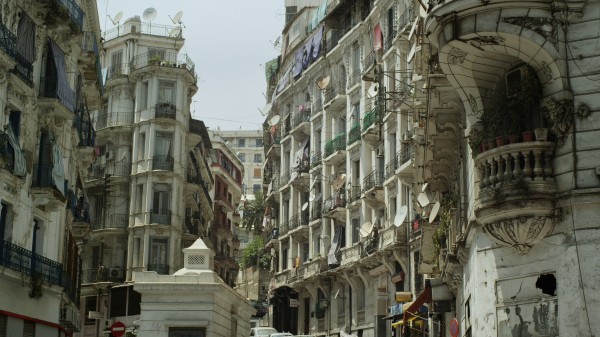
Algiers, from Perret in France and Algeria (2012)
The modernist architect Auguste Perret was born in 1874 and died in 1954. He built houses, studios, churches, and government buildings both in France and in the French colony of Algeria, then died eight months before Algeria declared its war for independence. The German filmmaker Heinz Emigholz’s new film, Perret in France and Algeria (2012), shot on trips to the two countries between March and July of 2011, shows how both sets of buildings are presently being used. In France, a largely Christian country, Perret’s churches and chapels have retained immaculate auras, placing them at a distance from everyday life; in Algeria, which became a Muslim country after winning its independence in 1962, Perret’s Cathedrale d’Oran has been converted into a public library. The air of the French concert hall Salle Cortot, maintaining a division between precisely ordered seats and the performance stage, differs from the availability of Perret’s Algerian Yacht-Club, a crumbling structure turned into a docking space for fishermen’s boats. The film makes it clear that many of Perret’s French buildings are now carefully preserved, oft-deserted performance halls, museums, and official historic sites, while many of his Algerian buildings are in constant public use.
The duality in Perret in France and Algeria—screening in New York February 15 and 16 as the opening film of the Museum of Modern Art series Documentary Fortnight—is communicated through new filmed images of the buildings and the sounds of their surroundings, without voiceover, as befits the usual style of Emigholz. He was born near Bremen in 1948, and began rendering the world artistically as a draftsman before turning to filmmaking. His early films such as Arrowplane (1974) and the Schenec-Tady trilogy (1972-1975) presented, to the tune of scores written before filming, landscapes rendered through sequences of thousands of 16mm photographs. After making a narrative, actor-driven film called The Holy Bunch (1990), he shifted his practice from filming actors in space to focusing exclusively on filming spaces themselves in a series of documentary films.
Over the past 20 years, Emigholz has made more than 80 films in the ongoing nonfiction series Photography and beyond, which uses the tools of filmmaking to present works by visual artists from other mediums, including painting, drawing, sculpture, and interior design. Perret in France and Algeria, which the filmmaker intends as one of the series’ closing films, belongs to a subcategory called Architecture as Autobiography, each of whose entries takes as its starting point the life’s work of a modernist architect or civil engineer. Each film offers a succession of individual sequences containing new images of the person’s buildings in the structures’ chronological order of completion, suggesting both how the artist’s style developed over time as well as how time has impacted his works.
A typical Architecture as Autobiography sequence begins with a title card stating an individual building’s name (e.g., Hôpital Sétif), date of completion (1934), location (Sétif, Algeria), and the date of Emigholz’s filming it (June 22, 2011). The sequence then shows the building through a series of fixed shots of individual parts of it, often taken at slightly skewed angles in keeping with how the human eye frequently looks. For instance, Sullivan’s Banks (2000), a 1995-filmed cataloguing of banks built between 1906 and 1920 by the American architect Louis Sullivan, first presents the exterior of the National Farmer’s Bank in Owatonna, Minnesota as seen from in front of a tree; the film then registers the bank from a series of vantage points along the car-filled streets outside it, glimpsing the neighboring dance school and dry cleaning shop while moving closer to the building, until an old metal sign reading “Office Entrance” appears, transitioning to an exploration of the bank’s interiors.
A similar urge to see informs a trip through Auguste Perret’s Parisian Immeuble d’Habitation de Maurice Lange, as the camera looks first up, then down during a stairwell ascent, finally arriving at a door, and then a trio of moving trees outside. The shots in almost any Architecture as Autobiography sequence link together to form small, self-contained narratives of curiosity, exploration, and discovery, with both eyes and ears taking their fill of a place. Throughout the shots the soundtracks flow richly with ambient noise from both the buildings and their surroundings, whether the dying echoes of human footfalls or the gathering whoosh of wind as it rustles through leaves.
The sound helps the viewer to imagine a greater world of which any one edifice is merely a part. “There is no point in trying to separate a building from its surrounding environment,” Emigholz says in the first scene of his architecture film Schindler’s Houses (2007), an exploration of Los Angeles homes built by the Austrian émigré Rudolph Schindler, with views of the newer curving roads and hilltop houses around them. In that Architecture as Autobiography film, as well as in others, seeing buildings within a greater contemporary urban context suggests how they continue to be relevant to it. In Perret in France and Algeria, regardless of whether the streets surrounding a Perret building are empty, as in Paris, or bustling, as they are throughout Algeria, one is always aware of people continuing to interact with a building regardless of its age, animating it and reinventing its value for the present moment.
These contemporary people include Emigholz, who has made the act of recording other peoples’ life work into his own. As his camera studies interior curving pathways that simultaneously connect and offset the clean, elegant lines of a vertical foundation, it becomes clear that his prized architects’ buildings were made to be inhabited as well as looked at. Their great beauty, his films suggest, holds practical value: it makes inhabiting them a pleasure.
How did you arrive at Perret in France and Algeria?
Between 1986 and 1990 I produced and directed a feature film called The Holy Bunch. It dealt with a group of artists, one of them dying, as well as with an elaborate set of architectures and complicated spaces, designed on a set and filmed in reality at places like at the Cologne Cathedral and La Sagrada Famila in Barcelona. I like to depict complicated, multi-layered spaces. I went broke with The Holy Bunch because I produced it myself, and was sitting with a lot of debt. So I decided to drop the actors and continue with what I liked most. I continued filming the spaces without them.
I made a list of architects and civil engineers whose work I admired: Louis Sullivan (1856-1924), Robert Maillart (1872-1940), Rudolph Schindler (1887-1953), Bruce Goff (1904-1982), Adolf Loos (1870-1933), Pier Luigi Nervi (1891-1979), and Auguste Perret, among others. In 1992 I started preparing one film, a documentary with voice-over, about these architects, their concepts of space, and my thoughts on it all. I filmed and filmed without knowing how I would edit the material. Then, around 1997, I decided to drop the overview approach.
The reason for this was that I thought cinema had lost its purpose as something that could explain the world on every level, as in a Gesamtkunstwerk [“total work of art”]. The Internet arose to provide a lot of information, so now I did not have to infest my film with that information any longer. I could spare the time and present spaces in an act of cinematography instead. Not to dramatize the material, not to put music or anything on top of it. Just to film and represent the spaces in a well-equipped screening room.
It was clear that I had too much material for one film with the works of these guys. I broke the project into several films and made a chronological order for each, a kind of catalogue of the buildings. I would edit the buildings in the order they were built so that we could see how each architect’s work developed over time. I would film the spaces, and in between the images of buildings I would include title cards with basic information: the name of the building, its location, the year it was built, and when I filmed it. My idea seemed so simple that I thought there would already exist hundreds of similar films, but I was shocked to discover that there were none. Our current historical moment’s belief that everything is available to you with the click of a button in a search machine is so utterly false. You have to make long journeys to record these spaces, and nobody had done it before.
The first three short films in the series Photography and beyond premiered at the Berlin International Film Festival in 2001. Some people said, “This is only for architects,” but I had another vision. We all have to live in some kind of building, so everybody has to think about or is confronted with what architecture is or could be, even if one doesn’t want to deal with it. I initially filmed in 35mm because of its high resolution. It was the best stock for documenting architecture. When you work in 16mm you cheat the spaces, the volume of negative space does not show – a high resolution is essential for showing it. Now we work with the RED digital camera and its high resolution, which is a relief, because we couldn’t make certain films on 35mm analogue film stock. On this recent trip we did around the world for The Airstrip, for instance, it would have been impossible to carry that equipment around. But regardless of digital versus analogue, the aim was always, from the beginning, to use the cinema space to represent architecture. This is subversive, because cinema is usually built to show something that takes place within a space, but cinema can represent spaces themselves in the best way that you can think of.
Now there are about eighty films in the series, including nine feature-length works. Perret in France and Algeria is the second-to-last film of a final group of films I call Decampment of Modernism. The first one, Parabeton – Pier Luigi Nervi and Roman Concrete (2012), premiered at Berlin last year and has not yet been released in the United States. The final one, The Airstrip, will be finished this June. Like Parabeton, which deals with both modern and ancient constructions by placing the architectures of Nervi’s modernist buildings in relation to ancient Roman structures the Perret film contains a dichotomy. The Airstrip is a compilation film, and it will sum up my endeavor with conclusions on a worldwide level.
How do you see the paths of Perret’s French and Algerian buildings diverging after Algerian independence?
I knew that Perret had built in Algeria, but I had never been there, so the trip to Algeria and the difficulties of filming there became a story in itself. The buildings there were built under French rule, then Algeria became independent, and it was moving to see what had happened to the buildings there versus those in France and how history had divided their histories into two separate tracks. I like that duality in this film very much. He built one building there, and then maybe three in France and one in Algeria. But I didn’t push their succession dramaturgically—it’s just chronological. It’s not a rhythm I created, it is created by the works themselves.
I do not say, in either case, “This is good” or “This is bad.” First, as a documentary filmmaker, I go to these spaces to record them. I don’t re-arrange furniture; I do not add artificial light; I film everything like it is. Sometimes I’m asked why so few people appear onscreen, to which I say it’s because I don’t use actors. We filmed some small streets in Paris, which were often empty. What can you do? I don’t want to make people act out living somewhere. If they feel comfortable with being in the picture, I feel comfortable with it, but either they are there or they are not. And I must say I am quite happy that they are sometimes absent, because actors can block the view of the real thing. You don’t need somebody to represent you in the picture as an onlooker—you can imagine that you are there yourself.
Perret built some artists’ studios in Paris, including one for the sculptor Chana Orloff in 1929. The Nazis destroyed her studio during WWII, and she died in Israel in 1968. Her son turned her former studio space into a kind of museum for her sculptures, which it remains today. He let us in—it’s not open to the public, but we wanted to film the building. And I was suddenly interested in her sculptures. The result is a long sequence that doesn’t deal much with architecture, because it’s a relatively simple space, but with a full sculptural population. At the end of it appears her bust of Auguste Perret’s head. I love that sequence because, no, people are not technically living there, but in a way they are—the spirits of people who once lived.
Our most populated Paris scene will be in The Airstrip. Perret designed a monument for Gustave Eiffel, who built the Eiffel Tower, which is located at the Tower’s north corner. There are a lot of people in that sequence, standing in line. But it’s generally true that in Paris there are empty streets and in Algiers there are populated streets. In Algeria, when you see the Maison de l’Agriculture, you also see hundreds and hundreds of people walking outside it. And then you see something like the Yacht Club in Algiers. If a yacht club by Perret would still exist in the so-called West, it would be posh. In Algiers, the Yacht Club is now a run-down space for fishermen to use. I’m not moralistic about what happens—I just want to show it. But for me that run-down place is a much nicer yacht club than its posh counterpart in the West could ever be.
It seems that some cultures use up their architecture. East Germany used up the DDR, sometimes destroying old quarters and building new ones. We don’t live in a museum. Different societies deal differently with architectural heritage. It’s not up to me to say what the Algerians do with their buildings is wrong and what the French do is right, or the other way around. But we can read. When we depict what’s there, I think we can very well read what’s going on.
What happens to modern buildings in time? The originators, the first owners, leave them. New people move in, and the buildings change. Some become so-called trophy houses, or masterworks. Many buildings by Schindler, Maillart, and Goff were originally single custom-made houses, built cheaply, but to renovate or even simply maintain them now would be very expensive. Labor was cheap when they were built, but now it is expensive in certain countries. In the case of Robert Maillart, the scaffolding for the buildings was cheap. The buildings were elegant concrete structures, and the scaffoldings were masterworks in themselves. But now you can’t just go to Home Depot to fix a Schindler building. If you would try to redo them now, you couldn’t pay for it. A lot of the buildings I have depicted are already forgotten, with only one building per architect taken to be the essence of his work. People rarely take the whole arc of his work, but I want to show how it began and how it ended.
The way I see that arc also changes over time. When Sullivan’s Banks was being made, many things in it were banal. But when I look at it now I see it as a documentary film about 1995, capturing things that don’t exist anymore. Goff in the Desert (2003) contains houses that were destroyed by Hurricane Katrina, as well as by other hurricanes and tornados in the American Midwest. These films work first as records, then later as monuments, both to the buildings and to their makers.
Some of these guys, like Bruce Goff and Rudolph Schindler, were always in the middle of controversy. The architectural community didn’t like them. Goff and Schindler were expelled from the International Style movement because their views were not presumed to be politically correct. They had a lot of problems with the building establishment, so they only built small household units. They never got into big business. When you make films like these about these neglected architects, you not only join a discussion, but you create an argument. However much people want to talk about what’s good or bad in architecture, when you’re faced with a 105-minute 35mm film of Goff’s buildings, you can’t just do like Mies van der Rohe did and say he built crap. You cannot talk it away anymore—you have to look. And in fact what I like about Bruce Goff’s work is how present it feels.
How do you prepare to film buildings?
It starts with me accidentally running into something. I ran into Schindler buildings in Los Angeles in the 1980s. I didn’t even know his name, but I remembered a certain space later. In Goff’s case, too, I went into a house by him in Los Angeles. I had no idea who he was, but I remembered the house suddenly when I decided to do an architecture film. I remembered other spaces suddenly, then started researching, then at a certain point looked at images and decided to travel to their sites. In 1991 I went into a bookshop in Venice, California, and found a book with photographs of Louis Sullivan’s banks. At that point I was thinking a lot about modernity and the ornament and the free-hanging façade, rather than a façade that carries a building. That has been possible in modern architecture since the end of the 19th century. As the façade doesn’t carry something, the possibility exists of doing free design on it. Louis Sullivan worked a lot with these new possibilities. The book addressed my own interests, and I thought, “I have to go there. I can’t rely on these photographs. I have to see it myself.”
I didn’t do a research trip before making Sullivan’s Banks. I went with the 35mm film camera for my first in-person view. Afterwards I received a shock about the procedures of architectural still photography. Sometimes I didn’t recognize a building from these photographs, because the still photographers, who have little space in their publications, use wide-angle shots to get the whole thing into their images. My films use normal lenses to give the view you have when walking through the space. The field trips are the most important part of the work, and they are very satisfying. You can’t do a scouting trip to Algeria because they don’t let you into the country beforehand, so in that case I came with a list of buildings and I found some more while I was shooting there.
I love shooting. I love making decisions all day long. My mind works very well when I am on set. I have to clear it to be ready to work, and then, when I am concentrated enough, I might be lucky enough to get what I want. I can’t write a script, like “It should rain. Rain fits that building well.” That would be ridiculous, because it might not rain for two years. So I have to react to what is there on an unforeseen day.
Preparing for this is important. But the first stage of preparing a shoot is dealing with complicated spaces and seeing the relationship between your thinking and somebody else’s in them. I felt grateful for these architects’ work. Bruce Goff’s and Adolf Loos’ buildings were sometimes hard to find because they were not well publicized, but it was always wonderful to find a building in its surroundings. The deeper I’ve gone into the series, the more important the buildings’ surroundings have become for me. Perret and his group of architects reconstructed the whole center of the city of Le Havre, so those scenes in Perret in France and Algeria feature everything. But in Algeria, many shots do not even contain a Perret building. Sequences go on for seven or eight shots before a Perret building appears because I was interested in the city life surrounding it.
How do you decide to present the environments around the buildings?
The larger documentary series in which Architecture as Autobiography is a part of is called Photography and beyond, and what I mean with this is that the series is about what your mind reads from your retina. So when, for instance, in this architecture subseries, you take a space that is already designed, you then construct your images with something that has already been constructed, which includes the natural or man-made world within and around it. My construction is a labor of love and not of criticism. I like the architects whose works I depict. They are geniuses at creating three-dimensional spaces. I couldn’t do that. I consider myself, rather, a specialist at putting three-dimensional spaces into two-dimensional imagery. My architecture films present a double-coded construction, each film creating a composition on top of someone else’s composition.
We put as much work into the film’s soundtrack as into the images. We record synch sound while shooting images, but afterwards we also record all the noises present both inside and outside the spaces. We then create the whole sequence by layering sound after the images have been edited. We don’t want to add artificial effects or music, because so much is already there. Even silence—each room has a different silence. And the off-screen space enters the image through sound.
When I first started showing these films some people said, “These are slide shows. These are silent films.” That’s total bullshit. When you look at something very deeply, you also hear it. Furthermore, you discover that there is a time-based aspect to your hearing and seeing. It’s not photography, because photography represents only a short moment, a one-hundredth of a second, while film is a container for a larger piece of time. Some people don’t see movement, but in every shot I see something moving, even if it’s only the air.
How established are your sequences before filming?
My idea about filmmaking is that each shot has to be perfect, and then we build from there. I don’t want to use shots that just fulfill the function of connecting to other shots. Every shot has to be perfect first in itself, and when I film, I care for that. The sequence is not in my mind, save for thinking about how to connect specific images to each other. There are always parts in one image that reappear in another image, so I make the connection then. But I don’t have the sequence in my head when I film. I have the whole building in my head, and at a certain point I say, “Now I’ve got it.”
I don’t know how I will go through it—whether I will go in or out or up or down. I will decide that in the editing process. But the images have to be composed. In themselves they have to be perfect, and they have to have connection possibilities to other images surrounding them. That is very different from architectural photography, which produces images that don’t connect: tableaux. When I create a film sequence I have maybe sixty shots, and I can build a complicated space with them and then connect it to others. But I will never present a sequence of stand-alone tableaux.
Furthermore, I don’t have specific shot lengths in mind when I film. The length of my gaze is intuitive. There’s no mathematical rhythm. It’s always about how long I look, and for how long I see something interesting in the picture plane. Some pictures are more complicated than others, and so they get more space and time. But I often rewatch these films—I’m a viewer myself—and I always see something that I didn’t see before.
What have been your greatest surprises in making the architecture films?
After I began shooting, when I still had the idea of doing only one film, I got into an editing block. I felt satisfied looking at how the material came out of the camera and didn’t see the necessity of editing, so I said, “I don’t want to add anything. I just want to look at it as it is.” I liked what I saw, and had to deal with it. The spaces themselves made me rethink how I wanted to present them.
All my architecture films are made with more or less the same strategy—I go to a space, I film the buildings there, and then I edit. But each film develops a different mood. When I see Loos Ornamental (2008), I get a sense of depression over how it all ended with the Third Reich in Austria after 1933. And in Schindler’s Houses, by contrast—even though the two architects basically worked at the same time, and even though I basically use the same methods to present their buildings—you get a different feel for somebody who lives in another country and is able to experiment with greater freedom. I add a certain kind of photography to the buildings, but I’ve learned that when you let these buildings speak, they will. You don’t have to do it for them.
I do have voice-over commentary in The Airstrip, but only in Duty Free areas at airports. There will be a lot of voice-over, but only when I go into surroundings that I don’t like, as in my trip to the home of the writer Gabriele D’Annunzio (1863-1937) in my earlier film D’Annunzio’s Cave (2005). When I show something I like I don’t talk anymore, because the objects speak for themselves.
As I said, The Airstrip will be the last in the series of architecture films. One reason why I am stopping is that it is getting more and more complicated to do this type of film. I wanted to make a film on the architect Luis Barragán’s (1902-1988) buildings in Mexico, but I was not allowed to do so, because the so-called picture rights to those buildings belong to the Barragán Foundation in Switzerland—owned 100 percent by the design company Vitra —and they wanted 30,000 Euros. It was shocking for us, because we thought we would do a service for his legacy. No, they want to make money. We went to Mexico City and filmed three of his public sculptures for which they don’t have the picture rights, but in general I fear that documentary films will become impossible to do as capitalist organizations invest in virtual picture rights and prevent those studies. Even some architects, who have made their buildings to be seen only from certain angles, will tell you from where you are exclusively allowed to film them.
This is a new topic, and one has to think about it. You can do millions of photographs of a three-dimensional situation, but if somebody suddenly says they have the picture rights to that situation, it makes documentation impossible. If this goes on, the world will no longer be recordable, as every clown with money can say, “I will call the police if you film this.” I want to turn around and ask, “Do they have to pay me if I don’t like their buildings and they hurt my eyes?” It’s more than disgusting, it’s active censorship perpetuated through capitalism. What happens is much worse than in Algeria, where the police didn’t bother us once we explained what we were doing. The Algerian people didn’t want money.
Which is good, because we didn’t have the money. It has been very hard to produce these films, partly because it’s hard to show them on television. We have shown some on TV, but the producers have always had problems because nobody says anything in the films, there’s just image and sound, and TV nowadays is radio. They want somebody to talk, otherwise you hurt the basics of their media.
Video recordings are very cheap now, and TV people from organizations like the History Channel can quickly pan around and ruin all prices, so that making a decent work becomes unaffordable. I was pleased to see the audience for Photography and beyond suddenly grow after about ten years—Parabeton had an eight-week run at a very good movie theater in Berlin—but it is getting harder and harder to produce these films at a sufficient level. And I don’t want to deal with crap like picture rights and TV’s subpar standards anymore.
What does Architecture as Autobiography mean?
Some people write their autobiographies, and some build them. I think the spaces themselves, if you look at them, tell you something about the way that their builders thought about space during their lifetimes, as well as what they could actually achieve. Most people think an autobiography has to be written, but it can be represented through buildings, and you can read these buildings. You have to read what you see: what did he do with that space, and why did he do that in that time
For instance, the Bauhaus guys ripped off a sentence from Louis Sullivan: “Form follows function.” To them, this meant only one form for each function, which is bullshit, because Louis Sullivan’s position was that a function allowed millions of forms. You might look at Sullivan’s buildings and discover that are they all different from each other. If there’s only one form for a function, they would all look alike, but they don’t. There are different qualities to each.
How are your architecture films autobiographical?
When I look at them and read that I was in a special place on a special day, I think that it made sense in my life to be there doing that work. It’s a kind of diary. Now there are so many films, made over 20 years, and I would like to see them all one after the other and get overwhelmed by these spaces, because after a while I forgot where I have been in my lifetime.
More information on the Photography and beyond series can be found at the website for Heinz Emigholz’s production company, Pym Films.
This interview was conducted at last year’s Toronto International Film Festival, where Perret in France and Algeria screened as part of the Wavelengths program. Thanks to Emigholz’s Canadian publicist, Stephen Lan.
]]>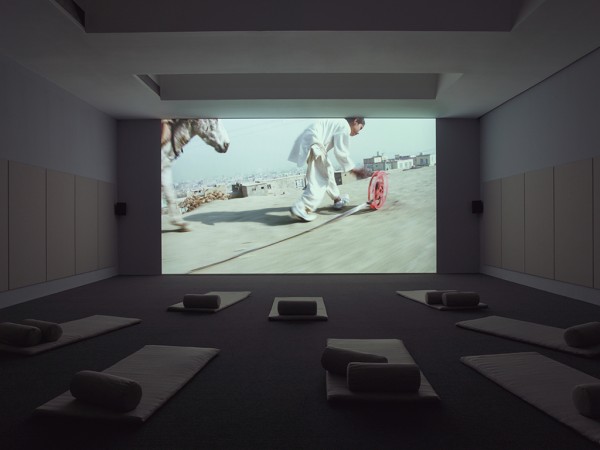
image courtesy of David Zwirner Gallery
I’ve read many thoughtful discussions of whether Zero Dark Thirty, the new Hollywood depiction of the United States government’s hunt for Osama bin Laden, endorses torture. I’ve read few discussions, period, of whether the film endorses the Afghanistan War. This tendency to question particular aspects of how the war has been fought rather than the nature and purpose of the war itself follows the greater American media’s lead. Unlike the initially stated reasons for the Iraq War, which common wisdom came to approach as lies, the goals of the Afghanistan War were always simple, clear, unchallenged, and morally unambiguous: Get al-Qaeda. Get bin Laden.
But how much damage has the longest running overseas conflict in U.S. history done in the name of these goals? Let’s assume a few things to make our estimates conservative, and then see. Let’s assume that the States did nothing to provoke the Taliban’s attacks, and ignore how the CIA’s support of the anti-Soviet group during the Cold War helped the Taliban come to power. Let’s also assume that the government was innocent on September 11th, neither collaborating with al-Qaeda to aid the attacks, as some have suggested, nor discovering signs of the attacks months in advance and neglecting to do enough to stop them, as the 9/11 Commission Report overwhelmingly shows. Let’s then look at these statistics, courtesy of Wikipedia:
Number of people killed in the September 11th, 2001 attacks: 2,977
Number of American soldiers killed in the subsequent Afghanistan War: 2,110
Number of Afghan civilians killed in the war: Between 7,300 and 13,800
The first number is self-explanatory. The second does not account for suicides, which currently outnumber combat deaths, and the third does not account for people who have died of starvation, disease, or any other non-artillery consequence of the U.S. invasion. But even if we stick just to deaths under fire—further excluding the many people who lived through September 11th while suffering permanent physical and/or psychological damage, and the many more who have suffered them as a result of the war—we still must conclude that the American government has avenged the innocents killed on 9/11 by sacrificing nearly three-quarters as many of its own people, and killing, at minimum, more than twice as many innocent Afghans.
We don’t have a more accurate count of Afghan civilian casualties for many reasons, one being—as Zero Dark Thirty briefly alludes to—that American soldiers often haven’t been around to count the bodies. The U.S. military has increasingly phased out ground combat in favor of drones whose bombs are dropped by pilots seated in military bases in front of radar screens, often thousands of miles away. As a result, horror stories abound, if one looks for them, of wedding parties blown to bits, and family members killed while lying beside each other asleep. When Zero Dark Thirty’s CIA agent Maya (played by the beautiful, appealing star Jessica Chastain) snarls that she’d like to drop a bomb on the compound potentially containing bin Laden, she—as well as anyone who shares her view—is ignoring the bulk of the people who would come to harm.
The film tells the familiar tale of the Afghanistan War as a revenge fantasy. The loner Maya devotes years of obsession to bin Laden, then weeps after seeing his corpse. She no longer has someone that she wants other people to kill for her. For some viewers, perhaps, the sight of her tears might inspire pity. But if we want to learn about how the war has actually been run, and who its greatest casualties have really been, then we should look elsewhere.
One good source of information is the new omnibus film Far from Afghanistan (showing in New York next month as part of the Museum of Modern Art’s series Documentary Fortnight), which analyzes the war’s global impact by drawing connections between the decimation of Afghanistan’s general populace and the decimation of the American middle class. Another is Malalai Joya’s 2009 book A Woman Among Warlords, in which a former Afghan Parliament member speaks out against both her country’s corrupt leaders and the American efforts to keep them in power. They both strongly counter the easy Hollywood stereotyping of Afghans as terrorists, co-conspirators, and helpless victims awaiting American rescue. So does the artist Francis Alÿs’ 20-minute video REEL—UNREEL, made in collaboration with Julien Devaux and Ajmal Maiwandi and on display through February 9 along with several Alÿs paintings at New York’s David Zwirner Gallery, as well as available for free viewing on the artist’s website.
The video was shot in November 2011 (the month after the war’s 10th anniversary) on a commission from the art exhibition dOCUMENTA, as part of a Germany-Afghanistan cultural exchange. Its stated purpose is to counter negative images of Afghans in the Western media. If this is true, then we might look to the New York exhibition space itself as evidence. The entryway’s walls contain paintings of color bars, like you might see when adjusting your television; some paintings consist entirely of bars, while others collage them with photographs of people and buildings. The artist has said “I cannot paint violence,” and these canvases can be seen as rejections of the violence that audiovisual screens so frequently show. Yet the colorful, symmetrical stripes can also be seen as adding something positive to counter negative imagery, especially in the paintings that show Afghan civilians gathered around them. When we look at a group of women seated in front of the bars, or even the bars looming over the rooftops of the city, we see people transforming the world in front of them. The rectangle ceases to transmit others’ stereotypes, and becomes a screen onto which its viewers project themselves.
Alÿs’ past work has often made entertainment out of the everyday, transforming reality through imagination. In some works the artist has even literally collapsed political and geographical boundaries by repainting national borders or carrying water from one sea to another. The 53-year-old Belgian artist forgoes direct political commentary in favor of what he has called “a sort of discursive argument composed of episodes, metaphors, or parables.” One of his most celebrated videos, Paradox of Praxis 1 (Sometimes Making Something Leads to Nothing) (1997), shows him dragging a large block of ice through the streets of Mexico City, where he has lived since 1986. At first the piece seems like a straightforward joke on the constant burden of work—a point that is sharpened by passerby ignoring the workingman—but Paradox sweetens as the ice melts into a ball small enough for the man to pick up and work transforms into play.
In many of his videos, either Alÿs or a stand-in abandons adult responsibilities for childlike game playing. Since 1999 he has worked on a video series called Children’s Games. The brief pieces, typically intended to play as loops, were inspired by the realization that children’s games were fundamentally alike across the world, coupled with the desire to record these games in urban landscapes before urban development made them disappear. Each video takes its title from a game’s chief objects. Coins (2008) sees young Mexican boys bouncing money against a wall; Saltamontes (2011), the Spanish word for “grasshoppers,” shows Venezuelan children plucking the legs off of the titular insects and throwing them into the air to see how high they can fly. The films show their objects being transformed into toys through children’s imaginations.
Alÿs has made three Children’s Games films in Afghanistan, one of which can be seen as a direct precedent to REEL—UNREEL. On his first visit to Afghanistan, the artist noticed the most popular children’s game to be rolling a hoop with a stick. The Children’s Games film Hoop and Stick shows a young boy playing the title game. The opening of REEL—UNREEL develops this image, as two young boys on the outskirts of Kabul chase their hoops while a third examines a filmstrip. Soon one of the hoops goes flying off into the canyon. The boy, in looking after its path, sees a helicopter flying above him, and frames it with his hands.
A few shots later, a boy in white rolls out not a hoop, but a bright red film reel. Another boy dressed in black soon appears rolling a cool blue one. A flock of other boys run joyfully after them. As they race along roadways and through alleys, a balloon man holding a multicolored array follows them, suggesting that films, too, are toys to be played with. The brief visual reference to the classic children’s film The Red Balloon (1956) suggests that real life might be as much fun as the movies.
Life might become even more fun, in fact, as the city around the boys gets wrapped up in their play. As celluloid spools out of the canisters, we bounce with the boys and toys down hills, absorbed in rapid motion. The sounds of panting are soon joined by those of car horns honking, motorcycles grinding, and radios playing pop music. We’re in the middle of crowded road traffic, then in the middle of a mess of human traffic, as the film cuts out to reveal a flux of movement within a market square. The boys are lost amidst men wheeling onions and driving with enormous white bags.
One of the pleasures of Alÿs’s video lies in watching quotidian Afghan life in motion. What we see in the market are simply people making it through the day. As celluloid falls from the boys’ canisters onto the ground, two women select fruit and nuts to buy, and a pair of young men stride together laughing. Other people push carts, or ride bicycles. In contrast to those whose identities have been permanently, reductively defined within film frames, everyone in the square is animated.
The boys continue rolling, taking in more of Kabul’s Old City, including other boys kicking a soccer ball, absorbed in sport just like them. Eventually they reach another mountaintop; the blue reel goes flying off the hill, like the earlier hoop, but it might not matter. The boy who’s lost it looks out and smiles at the sight of innumerable buildings below him. They form part of a culture richer than any one depiction of it.
We’ve seen small pockets of fire burning celluloid along the path back up the hill. Arabic-language title cards appearing toward the video’s end tell that on September 5, 2001, the Taliban burned thousands of reels of film on Kabul’s outskirts. The arsonists didn’t know, however, that they were primarily burning copied prints and not negatives. REEL-UNREEL lets us think about images of Afghan life being destroyed while the originals remain. We then once more watch the boys, who will soon leave this filmed vision of Afghan life to find whatever other joys their lives afford.
Note: According to a story in the January 7 issue of The New Yorker, Alÿs has recently begun work on a video of former mujahideen assembling and disassembling an AK-47. He plans to return to Afghanistan to film an American soldier performing a similar activity because, he says, “I want to understand it from the other side.”
]]>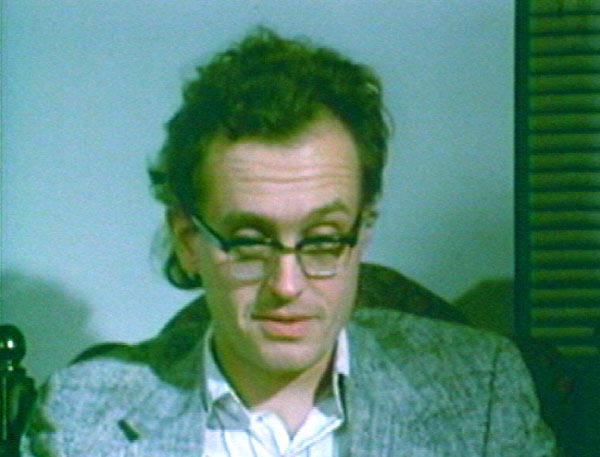
Keith Sanborn in Henry Hills’ Heretic (1995)
Idiom is proud to present Keith Sanborn’s manifesto, “Modern, all too modern,” which remains as provocative and intellectually invigorating today as it was upon its initial publication in 1988. The author has appended the text with brief notes where necessary; it is otherwise presented in its original form.
1.
Lenin to Lunacharsky: “Amongst our people you are reported to be a patron of art so you must remember that of all the arts for us the most important is cinema.”
2.
Goebbels on Potemkin: “It is a marvelously well-made film, and one which reveals incomparable cinematic artistry. Its uniquely distinctive quality is the line it takes. This is a film, which could turn anyone with no firm ideological convictions into a Bolshevik. Which means that a work of art can very well accommodate a political alignment, and that even the most obnoxious attitude can be communicated if it is expressed through the medium of an outstanding work of art.”
3.
Film is the most modern of the arts. Its powers and structure have served as a paradigm for the arts of the twentieth century, from Balla’s strolling dog to Duchamp’s descending nude. Film was fated to play a central role for modernist utopians from Lenin to Goebbels, from Eisenstein to Riefenstahl. For the first half of the twentieth century it represented something more than the degree zero of technology, it projected the fundamental myths of the new Metropolis, resolving their complexities in Chaplin’s sentimental “The End” or Vertov’s reflexive “Kinets.”1 As we have passed beyond modernism, film has become the victim of its own paradigmatic modernity.
4.
“The cinematographe is an invention without a future.” —Louis Lumière, 1895.
5.
“The cinematographe is an invention without a future.” —Hollis Frampton, 1971.
6.
In 1988, the cinematographe is not only an invention without a future, it is an invention without history. For when the cinematographe superceded its identity as a mechanical technology, history was superceded by what Frampton called “metahistory.” But in deploying “metahistory,” we must keep in mind our position in the labyrinth of etymology: just as “metaphysics” first meant “the works which follow the physics” [in the writings of Aristotle], so “metahistory” first means “the work which follows history.” In the inevitable montage of temporal successivity, metahistory will necessarily be taken as commentary on that which came before, but it should not be assumed from the outset, that its ambition is to contain its object in succeeding it. It is a question of developing a strategy for comparing the incommensurable: what comes before and what comes after.
7.
The avant-garde is dead. Long live the avant-garde.
8.
The death of the avant-garde coincides with the death of modernism. For film, that was sometime between 1973 and 1978, at the latest, though the five year span a decade earlier suggests itself as well. Unfortunately, it was only in 1987 that the voice of the critics began to register any notice.
9.
“When stupidity reaches a certain level it becomes public offense.” —Ezra Pound, before 1920
10.
Sitney’s Visionary Film constitutes a kind of dictionary of received ideas for the avant-gardiste. It is high modernist in design, nationalist if not provincial in outlook, sexist in its particular omissions, and ethnocentric in the formalist circumscription of its discourse. We are presented with the search for form as the telos of cinema. We are shown how all important, i.e. European, film historical roads lead in the post-war era to New York, though San Francisco is mentioned as a kind of exception, which proves the rule. We are told of Carolee Schneeman only that she was an actress in a Brakhage film. We are told that Joyce Weiland was alive but not what she films she made or what they might have meant. And we are told nothing about Mary Ellen Bute, Barbara Hammer, Yvonne Rainer, Barbara Rubin, Chick Strand, Germaine Dulac, Esther Shub, Gunvor Nelson or Anne Severson to name only an obvious few. St. Maya is the exception, which seems to prove an implicit rule. The few persons of color admitted to the discussion, must be able to “pass” formally. Homoeroticism is filtered exclusively through considerations of myth and form.
Visionary Film2 is the master logocentric narrative of a closed pantheon of form. In spite of its author’s denials of a project of totalization, it is essentially an extended explication of the post-war segment of the collection of the Anthology Film Archives. As a justification of the choices for the eternal pantheon of film form, it becomes a project to foreclose discourse and downplay difference. By obscuring difference along the margins of film practice, the institutionalization of Sitney’s views has retarded the recognition and to some extent even the creation of a cinema of resistance. Sitney, however, is not alone here. Even the deliberately Eurocentric, reverse colonialism of Le Grice’s formalist Abstract Cinema and Beyond—written to limit the damage of the onslaught of the Sitney-Mekas great American art machine—comes up short on the score of recognizing sexual and ethnic difference. But these are not simply the ethical and aesthetic limitations of particular individuals, they are the symptoms of an intellectual period style. Modernism, nationalism, sexism and ethnocentrism—while not related by pure synonymy—must finally be recognized as part of the same master lexicon to be resisted and overcome.
11.
Time: the late 1970s.
Brakhage: “I’m planning to give a lecture on the theme ‘No woman ever made an important work of art.’”
Frampton: “You do and I guarantee you, I will personally make certain that you’ll have Judy Chicago in your audience to dispute the point.”
The lecture was never given.
12.
History is always ironic or perhaps never so. What insight can be gained, then, from the observation that Triumph of the Will, easily the most widely known and highly praised fascist film in history, a prime vehicle for the dissemination of the century’s most evil and transparently patriarchal ideology, was made by a woman? How is it that the sterile kitschy beauty of Riefenstahl’s films has elevated her to the status of the most famous and perhaps the most respected woman ever to make films? And what of the attempt to reclaim her for the modernist pantheon of the avant-garde through a strictly formal consideration of her work when Esther Shub is ignored? Shall we call “ironic” her success at playing the game of history with the boys? How shall we evaluate her repeated and repeatedly exposed deceptions concerning her relation to the National Socialist party? One upon a time there were facts. Occasionally there are still.
13.
Now at the Metropolis: Part I of Leni Riefenstahl’s Olympia vs. James Nares’s Rome ’78. The Aryan neo-nude meets the togas of simulation! Texas Death Match Rules.
14.
During the question and answer period of a recent panel discussion in New York on the Responsibility of Representing the Other, a white male European in the audience questioned what he saw as the hyperintellectuality of Trinh T. Min-ha’s treatment of the Africans she filmed in Reassemblage. He especially objected to her voice-over commentary. He offered Leni Riefenstahl’s book on a certain African people—he couldn’t remember their name but he said it didn’t matter—as a counterexample of a more direct, accessible practice. Eye brows were raised and mouths opened by not a few members of the audience and of the panel. Min-ha with some puzzlement admitted her film could be thought of as an “art film” in the context of ethnography, but had little to say about the alterative praxis offered by the example of Riefenstahl’s book.
A differing response came from Sarah Maldoror, a Black woman born in Guadeloupe, living in France and making films in Africa. Though I cannot say with certainty that Ms. Maldoror entirely understood the remarks because she spoke only in French (her remarks were translated into English by another woman) and the question was posed in English, I can say that her response was exemplary and unexpected. Maldoror first informed her interlocutor that the people in question were the Nuba. She then continued to say that while she thought Riefenstahl detestable for her relationship to German Fascism and her stand with respect to Israel, she found her book wonderful. Michelle Wallace, a Black American writer and the moderator of the panel, queried Ms. Maldoror whether she did not find the book to be racist in its representations. Maldoror responded that she did not, saying that the matter was quite straight forward: Riefenstahl had gone to Africa and photographed these people. Maldoror explained that she found the images Riefenstahl had created quite beautiful, those of the men in particular. Queried again by Ms. Wallace, she simply responded, “The images are beautiful and I’m powerless against them.” A member of the audience who spoke “as a German woman” expressed her repulsion at the images saying they only celebrated power and violence. Clearly one Other’s Other is not another Other’s Other. Or is it?
15.
“I had to shoot him. He had too much control over my life.” —Valerie Solanas, 1968.
16.
Andy Warhol began to make films in 1963, the year Zapruder shot Kennedy on film. Warhol’s own five year plan for film was completed in 1968 when he himself was shot by a woman who had acted in his films. Warhol survived all the shooting, but he is now permanently dead.
17.
Film is not dead, He is just marvelously sick. Film is famous. Film is dead.
18.
In the mid 1970s Hollis Frampton was given a tour of Buenos Aires by the National Librarian of Argentina. Borges proceeded with an elegant and measured gait from slums to governmental palaces, noting in critical and loving detail the history and sociology of each section of the city they visited. In the course of that tour, Borges, who was already blind, on several occasions lifted his cane to draw attention to architectural details of buildings, which no longer stood. Frampton, whose passion for knowledge and whose stubbornness for being correct are well-known, made no attempt to disabuse him. For Frampton could never quite determine whether Borges was unaware of the changes, or that he chose to ignore them, or that he was constructing for the benefit of his interlocutor (i.e., Frampton) an ironic imaginary city from the convergences and divergences between the ocular evidence and the notations of his own mind’s eye.3
19.
To celebrate the death of the cinematographe and of the avant-garde, Frampton conceived his metahistory, Magellan. At first glance, the project seems to share the utopian ambitions we have come to associate with modernism. But this Utopia is not a capital of purity, of pain, of vision, of a century, or even of an art, but an invisible city at the center of a rich labyrinth of quotations—filmic and otherwise—where every street opens onto an infinity of other streets and each of those streets implies another vast imaginary city. Our loss of Frampton is irreparable as it was inevitable. And while we are the poorer for the loss of the completed cycle, its particular state of determinate incompletion only underscores its congruence with the postmodern city it resembles. For it is not fragments shorn against Frampton’s ruin, but a map of the circular ruins of our culture drawn from fragments.
20.
The “new talkie” proudly traces its paternity to Godard; in so doing it betrays its ignorance of Godard’s own questionable origins. Praise among English and American academics (e.g. Wollen) for Godard’s bourgeois Sunday-Maoist recuperation of the formal devices of Situationist film has been possible, first, because it coincides with the impostures of those academicians and, second, because Situationist film remains virtually unknown outside of Paris.
21.
The Situationist International is dead. Long live the Situationist International.
22.
Contrary to popular belief, Guy Debord was not the only member of the Situationist International, nor the only Situationist to make films. But as a central figure in the group, his case may still serve as illustration.
When the man who backed most of Debord’s films and created a special theatre for screening them was assassinated several years ago, Debord withdrew his films from distribution. In recent years, Debord has refused to allow his films to be shown in public except under conditions so extraordinary as to be impossible in practice to fulfill. He has gone to great lengths to isolate himself from those interested in his work: using a post office box in the Massif Central while he was probably living elsewhere, demanding lengthy and exacting descriptions of the screening conditions, seldom even responding to the requests. In constructing an elaborate protective maze, he has labored to preserve his films from the fate of all films as they enter the discourse of history. He has attempted to prevent recuperation by the agents of the spectacle: mannerist feature filmmakers such as Godard, advertising hacks such as Godard, the historians of the “avant-garde.” The films were made at a specific time for a specific purpose. Perhaps Debord believes that their time has simply passed as the time had passed for the Situationist International when its members chose to disband it. Perhaps his films have become films without a present and without a future. Left with the bare fact of their historicity, he chose erasure, an act of metahistory perversely reminiscent of Warhol’s withdrawal of his films.
23.
It is all too easy to attribute to Warhol purely economic motives for withdrawing his films. He took them off the market—say the dictates of the Warholian logic of commodification as they are officially and vulgarly understood—in order to make them scarce, to make more money with them later. Probably, he just got bored with them and wanted to move on without dragging so much of his personal history around with him. An act of strategic self-erasure perfectly congruent with the aesthetic of commercial anonymity of his factory system paintings and of the films themselves, performed to enable him to move on, to travel light, to accommodate the demand for the new which drives the logic of the art work as commodity. Warhol, in fact, had allowed the films to sit neglected for many years, ignoring several offers to put them back in distribution. When he finally acceded to the offer from MOMA for the entire lot, he was surely aware that this would permanently alter their commercial exploitability for the 60s underground revival and assure their embalming as film historical corpses. But then history is an expensive commodity and Andy actually managed to manufacture and sell it, as well as to collect it.4
24.
Debord, we might assume, withdrew his films from an excess of intellectual scruples, yet the effect is the same. Just as Warhol’s films have existed mainly in books for the past 20 years, the films of Debord are accessible now only in book form through his Oeuvres Cinématographiques Complètes in French, two scripts translated in the Situationist International Anthology, and two other extremely rare publications in French. Through the absence coded into their shadowy presence, Debord’s films have assumed the status of myth, the secret map to the buried origins of postmodernist film practice in France, much as Warhol’s films, in their obscurity, have held the allure of the lost Ark of the underground, the sacred treasure of the postmodern here.5
Now that Warhol has attained the perfect biological anonymity of the dead and his films are receiving their first significant exposure in twenty years, we can begin again the endless ritual of bringing their secrets to light. Unseen, they have captivated many; their position in our imaginary will be altered as they pass from the underground to the museological mausoleum. This is hardly cause for alarm, however, since necromancy and necrophilia are the filmgoers favorite vices.
For the living, concerned with the practice of everyday life, however, it is unfortunate that Debord, in protecting his own work unsuccessfully from the ravages of recuperation, has deprived his contemporaries in France and abroad as well as his historical successors of the insights his work might offer. The occultation of these films has preserved the historical integrity of the work at the ironic cost of inflating their fetishistic value as intellectual commodity. Meanwhile, Godard, in King Lear, explicitly and with unintentioned irony reveals himself to be the Woody Allen of France, Barbara Krueger recycles Situationist form as she laughs her way to the bank and the biennial (“Shop til you drop”) and Robert Longo is taken for a critic of the society of the spectacle instead of its hypostasis. But who can blame Debord? In the current cultural climate, offering one’s life work to one’s contemporaries—let alone to one’s historical successors—has all the attraction of binding and offering oneself for gang rape, vivisection and piecemeal transplantation.
25.
“Plagiarism is necessary; progress implies it. It embraces an author’s phrase, makes use of his expressions, eliminates a false idea, replaces it with a true one.” —Lautréamont, 1870.
26.
“Plagiarism is necessary; progress implies it. It embraces an author’s phrase, makes use of his expressions, eliminates a false idea, replaces it with a true one.” —Debord, 1967.
27.
Patti Astor, star of Eric Mitchell’s Underground U.S.A., founded the ephemeral and influential Fun Gallery on East 10th street in New York in the early 1980s. During the height of her influence as a dealer, she would find herself deluged with slides from unaffiliated painters from all over the country. Rene Ricard, a veteran of the Warhol scene turned critic and a co-star in the Mitchell film, summed up the situation this way in his “Pledge of Allegiance” to the Fun stable of the period: “Nobody wants artists. Artists are supposed to create a culture around themselves to be noticed, set off drumbeats in the jungle, then get a gallery. Nobody wants to see slides; they’re a pain in the ass. Open your own gallery. You can have your own fun. Start your own war.”
28.
Makers of film on the margins perform many rituals of complaint; the litany includes: lack of money for their films and other vices, lack of audiences, lack of critical attention, lack of position. The complaints are all more or less justified. I have performed them dutifully myself; they come with the territory. But the time has long passed for looking to the Sitneys, the Taubins, the Campers and the Hobermans of the world for intelligent critical response to film or anything else. Start your own magazine. Write your own reviews. Build your own audience. If there is a cinema of resistance that perseveres in the midst of the wake for modernism and the “avant-garde” then it must speak with its own voice or not at all. Because if you’re waiting for just that review that will put your career over the top, you are waiting for hell to freeze over and deserve to. The lame will walk, the blind see, the deaf hear and a critic will pass through the eye of a needle before a writer for the Village Voice will depart one word from the perpetuation of a tired official journalistic anti-decorum.6 And should that review come bearing a resemblance to your intentions, I advise you to write it off to coincidence or to Nancy Reagan’s horoscope, or to pause and reflect just where you went wrong.
29.
Deconstruction is dead. Long live deconstruction.
30.
For deconstruction: Within the few short years since his death, research has brought to light Paul De Man’s carefully concealed collaborationist past. It now seems that Heidegger was a better Nazi than previously thought. Nietzsche—betrayed by his sister and bastardized—was at least dead before his corpse was handed over to the party. Though his pathological ambiguity, sweeping generalizations and sexism continue to be his downfall, Nietzsche was outspoken against anti-semitism during his lifetime. De Man and Heidegger were very much alive when they spoke out respectively against Jews and on behalf of the party. Derrida has travelled along many of the same intellectual paths as Heidegger and De Man; he assisted in the French reanimation of Nietzsche in the 1970s. While it seems unlikely that Derrida will simply lie down and die as deconstruction enters history as a dead form of literature, one may well wonder what awaits his eventual reanimators. For history refuses to be subjugated to literature. It has a way of leaking out around the edges, trickling down the bindings onto the shelves, and staining the library floor. Someone notices sooner or later. It returns where repressed and with a vengeance.
31.
Baudrillard is dead. Long live Baudrillard.
32.
Q: How did Professor Baudrillard of the University of Nanterre spend the spring of 1968?
A: The records have not yet been uncovered, but it is important to find out now as the consequences of his passive nihilist stance come to be tested.
33.
For nearly 20 years, Baudrilliard’s idée fixe has been to discredit Debord’s analytic model of the “society of the spectacle.” So many trees have died, so many careers have been made in the art world and academia simply because the Situationists recognized Baudrillard in 1967 for the modernist he remains. He has spent his career trying to deny that relegation to the realm of dead history. While his currency as an intellectual pop star is unquestionable, his strategy of the transcendence of history through a literary eternal present is problematic at best. While few doubt that the past 20 years have departed radically from the previous 100 and many affirm that history may be a thing of the past, even the law of entropy dictates the concrete passage of time.
34.
The decentered subject, which inhabits the Baudrillard world, is allowed no distance between himself and the world. He cannot be alienated because she is “always already” alien. There is no longer an inside and an outside set at a critical distance from which to judge. With the collapse of this distance we are left with the “ecstasy of communication” and with “seduction,” the play of attractions between decentered self and other.
In exploring this relation, Baudrillard focusses his critique with an attack on the allegiance of one strain of feminist thought to the self-representing subject. Baudrillard speaks of “feminist naïveté” in analysing “feminine striptease” in advertising as a form of “prostitution.” It is just “putting on an act,” a kind of simulation. For where everyone and everything is equally alien, “alienation” can carry no meaning. But if there is no space between consciousness and the world for self-representation, precisely how can one “put on an act”? How can simulation be possible without a void between consciousness and an imaginary? But accepting this most “melancholy” of all possible worlds, we find nonetheless that some Others are still more incommensurable than others.
A methodology banal in its anti-subjectivity—American behaviorist industrial psychology—informed us long ago that an advertising message need neither be consciously registered nor remembered in order to affect our behavior at critical moments. Some circuits of power are not reversible with the turn of a phrase or the touch of a finger on the remote control. We are left with yet another attempt to recuperate the fashionable discourse of sexual difference for a master literary if not simple-mindedly logocentric narrative. Baudrillard here has performed yet another critic’s paraphrase of Rimbaud. He recycles “Je est un autre” quite directly, changing “Je veux devenir nègre” to “Je veux devenir femme.” Baudrillard’s claim of the reversibility of the terms as a facet of current socio-economic life is at best a masturbatory fantasy.
The strategy of Baudrillard’s rhetoric in presenting his world view is to collapse the dualistic oppositions of language itself (metaphor vs. metonymy or similarity vs. contiguity) to an aphasic superimposition. Similarity disorder simulates contiguity disorder. The threatened triumph of metaphor explodes into isomorphic holographic fragments placed in vertiginous atemporal contiguity. Or, to summarize the observations of Meaghan Morris: beneath the ecstasy of communication, we find the ecstasy of description, beneath the ecstasy of description, a kind of hyperrealism, and beneath this hyperrealism, a kind of hype. In the posture of a McLuhanesque nihilist, Baudrillard seems willing to take the media’s things for words about the status of the global village, while ignoring the concrete aspects of its economy, multinational capitalism. See no production, hear no production, speak no production. The third world is reserved for exotic vacations.
35.
If there are still those who persist in believing that Baudrillard’s critique may offer a solution for film to the endgame of modernism, let us consider Baudrillard’s particular sense of just what is important about film: “This collusion between images and life, between the screen and daily life, can be experienced everyday in the most ordinary manner. Especially in America, not the least charm of which is that even outside the cinemas the whole country is cinematographic. You cross the desert as if in a western; the metropolis is a continual screen of signs and formulae. Life is a travelling shot, a kinetic, cinematic, cinematographic sweep. There is as much pleasure in this as in those Dutch or Italian towns where, upon leaving the museum, you rediscover a town in the very image of the paintings, as if it had stepped out of them. It is a kind of miracle which, even in a banal American way, gives rise to a sort of aesthetic form, to an ideal confusion which transfigures life, as in a dream. Here, cinema does not take on the exceptional form of a work of art, even a brilliant one, but invests the whole of life with a mythical ambience. Here it becomes truly exciting. This is why the idolatry of stars, the cult of Hollywood idols, is not a media pathology but a glorious form of the cinema, its mythical transfiguration, perhaps the last great myth of our modernity. Precisely to the extent that the idol no longer represents anything but reveals itself as a pure, impassioned, contagious image, which effaces the difference between the real being and its assumption into the imaginary.
All these considerations are a bit wild, but that is because they correspond to the unrestrained film buff that I am and have always wished to remain—that is in a sense uncultured and fascinated. There is a kind of primal pleasure, of anthropological joy in images, a kind of brute fascination unencumbered by aesthetic, moral, social or political judgments. It is because of this that I suggest that they are immoral, and that their fundamental power lies in this immorality.” (The Evil Demon of Images, pp.26-27.)
Et tout cela sortait de ma tasse de thé. From the preceding two paragraphs it would appear that M. Baudrillard does on occasion when abroad leave his cork-lined motel room for a drive to the 7-11. The filmic variant of his project might be formulated as a combination of “Je est un touriste” and either “Je veux devenir americaine” or “Je veux devenir image.” The latter two seem nearly synonymous for him. And while the forgoing text is moderately amusing as an exercise in colonialist provocation of an Australian university film audience, it is hardly novel. In view of the fact that the Australians have considered Baudrillard much more closely and critically than most Americans, one wonders whether those words were not the occasion for the ultimate discrediting of his project there among the film community where his work seems particularly to have flourished. [See Seduced and Abandoned: the Baudrillard Scene.] It is somewhat ironic that here, at yet another arguable Antipodes from both France and Australia, the Baudrillard scene has been confined almost entirely to the realm of the so-called “visual arts.” To circle back to the text above for a final if not definitive pass: while the power of film to fascinate is undeniable, one wonders whether Professor Baudrillard would respond with the same blithely melancholic indifference to the brute leveling of the distinction between the imaginary and the real historically effected by Triumph of the Will, or Der ewige Jude. Perhaps in our era hyperbole is its own reward.
36.
Tonight on Channel 4 at 3: I Walked with a Zombie and Baudrillard visits Disneyland.
37.
We could always have an ocean ending.
38.
The pope is resting comfortably in his private offices, daydreaming about the Avignon papacy and the French Riviera, when his chief nuncio with unusually abbreviated ceremony enters. “Your Holiness, Your Holiness. I’ve got some good news and some bad news.” The Holy Father responds: “My son, my son. The Gospel means ‘good news’ so let us have the good news first.” The nuncio: “It’s the Second Coming, Holy Father and Jesus Christ, who died on the cross to take away the sins of the world, is on the phone and wants to talk to you.” The pope: “My son, my son, with such joyous and momentous news for which Christians have been waiting nearly two millennia, what could possibly be amiss?” “Well, Your Holiness,” answers the nuncio, “She’s calling from Salt Lake City.”
Keith Sanborn
May 1988
New York
- I had originally thought that the title at the end of the 16mm prints circulating during the 1970s and 1980s of Vertov’s Man with a Movie Camera (Kiнец) was a Futurist portmanteau word in Russian: Kino [cinema] + Konets [(The) End]. I had thought that the odd spelling of the word (with an “i” instead of “и”) was simply a pre-orthographic reform spelling. I was mistaken; it was simply the Ukrainian word for [The] End. Ironically, in the 5 current DVD versions of the work I have seen, this title has been replaced with a video intertitle using the Russian word “Конец.” Current practice is an historical “correction” since the work was produced by the All Ukrainian Photo-Cinema Directorate (VUFKU) Всеукраинское фотокиноуправление (ВУФКУ) and very likely bore the Ukrainian version of the word at the end, which would have been easily understandable by any literate Russian.
- Sitney has, since the writing of this text, rewritten Visionary Film several times and has significantly revised the films he has included and to some degree the logic of their inclusion. The current edition includes a significantly greater number of women than the edition in print at the time this text was written.
- A few years ago, P. Adams Sitney, my colleague at Princeton—how times change—informed me that Frampton had in fact appropriated the story from him.
- Other rumors suggested that Warhol pulled the films “off the market” because he had no model releases and thought he would be constantly hounded for money from the people who had participated in them. It is said that he had already been hounded by some of the actors when the films were in distribution.
- Several years subsequent to the writing of this text, Debord’s film were released on DVD along with his final effort Guy Debord, son art et son temps, a video made in collaboration with Brigitte Cornand and broadcast after his death in 1994 in a special Soirée Guy Debord on Canal+, during which two of his earlier films were also broadcast. Around the same time the DVD’s were released, the films also circulated in newly struck 35mm prints, poorly subtitled. There were several problems with the initial DVD release, which I pointed out in an article published in Artforum. The problems have now more or less been quietly addressed.
- At the time, I naively thought the Village Voice could not get any worse. I was so wrong, that it will be difficult for those not alive at the time of the writing of this article to believe that the Village Voice could ever have been taken seriously as even an arbiter of taste, let alone as a vehicle for cultural criticism, or that it merited any mention whatsoever.
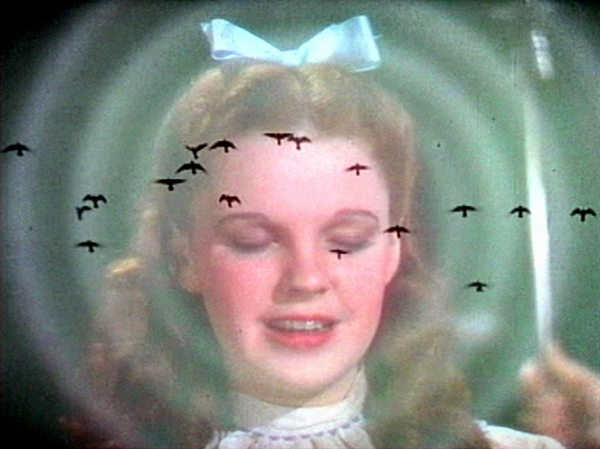
Mirror (Keith Sanborn, 1999)
In May 1989, on the occasion of the International Experimental Film Congress in Toronto, a group of filmmakers released their “Open Letter to the Experimental Film Congress,” denouncing the event and its focus on “representatives of the 60s Avant-Garde and its decaying power base.”1 Many of the most important filmmakers and programmers of the 80s and 90s, including Peggy Ahwesh, Craig Baldwin, Todd Haynes, Mark McElhatten, and Keith Sanborn, signed the letter.2
A year before, Sanborn’s manifesto, “Modern, all too modern,” appeared in the third volume of Cinematograph: A Journal of Art and Media, published by the San Francisco Cinematheque. While more expansive in its breadth, Sanborn’s manifesto presaged many of the concerns voiced in next year’s “Open Letter”. Presented as a series of numbered paragraphs of various length, “Modern, all too modern” is a wily synthesis of Sanborn’s interests and sensibilities, coupled with a D.I.Y. clarion call that would come to fruition in the 90s. Echoing William Wees’ statement in regard to the 1989 “Open Letter,” I would like to emphasize that it is not the accuracy of specific propositions that require nitpicking, but the attempt to enunciate the ambitions and situation of experimental film at the end of the 80s that deserves attention.3
In section 8, Sanborn suggests,
The death of the avant-garde coincides with the death of modernism. For film, that was sometime between 1973 and 1978, at the latest, though the five year span a decade earlier suggests itself as well. Unfortunately, it was only in 1987 that the voice of the critics began to register any notice.
The reference to “the critics” is to two twin pieces of criticism that heralded the death of a cinematic avant-garde: Fred Camper’s “The End of Avant-Garde Film,” which appeared in Millennium Film Journal, and J. Hoberman’s Village Voice review of the film and video work that appeared in the 1987 Whitney Biennial. Camper’s article protested, “[w]orks of the new generation of filmmakers for the most part lack the authentic power of the original, and often still-active masters,”4 while Hoberman observed that “the movement seems moribund.”5
Sanborn’s deflection of these melancholic critiques emphasizes their nearsightedness. It is precisely against this spirit of death and subsequent enshrinement that “Modern, all too modern” sets its sights. The production of what Camper referred to as “original masters” created an ossified, historical film avant-garde while labeling contemporary work as deviant without recognizing this new work’s rereading of, and response to, previous aesthetic strategies.
As such, it makes sense that in “Modern, all too modern” Sanborn takes aim at the shortcomings of Visionary Film, the ultimate “master narrative” of American experimental film. Yet the aim of Sanborn’s writing is not the perpetual reassessment of certain reductive critical models. It is, instead, a call to arms: “The time has long passed for looking to the Sitneys, the Taubins, the Campers and the Hobermans of the world for intelligent critical response to film or anything else,” he writes. “Start your own magazine. Write your own reviews. Build your own audience. If there is a cinema of resistance that perseveres in the midst of the wake for modernism and the ‘avant-garde’ then it must speak with its own voice or not at all.” For Sanborn, the locus of “its own voice” lies in the recovery of suppressed or mischaracterized cinemas, to challenge official, authorized histories with radical insurgency.
To that end, “Modern, all too modern” investigates two cases of filmic extinction: Andy Warhol, who pulled his films from circulation in 1968, and Guy Debord, who by 1984 had withdrawn his films from distribution following his producer’s suspicious assassination. Their resuscitation is a cornerstone of the manifesto. Surveying the potential reasons for their self-dismissal, Sanborn notes the purity in keeping these films from entering the auspices of film history. For Sanborn’s Debord, “[o]ffering one’s life work to one’s contemporaries—let alone one’s historical successors—has all the attraction of binding and offering oneself for gang rape, vivisection and piecemeal transplantation.” The potential danger lies in subjecting them to years of critical abstraction and misunderstanding, whitewashing and subordinance to aesthetic-historical causality. In their stead, Sanborn argues, the void was filled with work that failed to critique, and even played into, the spectacle.
Warhol followed a similar route. After his attempted assassination by Valerie Solanas in 1968, Warhol not only recalled his films from distribution but also moved away from film production in general. Warhol had been in a unique position to profit from his films: many of his films were rented and screened across the country throughout the 1960s, and he was even jealous of the reverberations his films had in Hollywood. In some sense, Warhol’s refusal to maintain a profitable distributive network for his films impacted filmmakers who could have followed his model. To Sanborn, in 1988, Warhol and Debord’s removals—as opposed to their potential circulation—served as their own model: models of ghostliness instead of presence. Perhaps the films, made in and for a specific historical moment, should remain restricted to abandoned time.
While Warhol’s films’ continued distribution could have provided a more profitable blueprint for experimental filmmakers than the Film Maker’s Cooperative, their successes also relied on the ability of those films to traverse spaces as diverse as movie theaters, porno houses, student organizations, and film societies.6 Films that couldn’t inhabit such disparate spaces, however, remained restricted from greater viewership. At the time of Sanborn’s writing, similar divisions could be seen in the films identified with the cinema of transgression, which exhibited frequently throughout New York City clubs.7 At that time, Sanborn’s films didn’t traffic in that kind of subversive content so much as attempt to outline strategies for experimental film at a time when previous incarnations of the avant-garde were being accepted by the academy.
Sanborn suggests that the dark spaces left by these phantasmatic films were more harmful than intended. The disappearance of Debord’s work, especially, was filled in by spurious new talkie avant-gardism, epitomized by the “bourgeois Sunday-Maoist” practice of Godard. In “Modern, all too modern,” work taken for critique instead bears no trace of it. Sanborn’s characterization of Godard (like Baudrillard, against whom the final sections of “Modern, all too modern” take aim) as an American Frechman (“the Woody Allen of France”) and practitioner of watered-down Debordian tactics is an attempt to reinsert Debord’s film work into the critical consciousness of cinematic avant-gardism, both to resist Godard’s deification and challenge Baudrillard’s refutation of Debord’s Society of the Spectacle. Aside from Godard, Sanborn aligns these tendencies with the work of 80s marquee artists Barbara Kruger and Robert Longo, who, keeping with Baudrillard’s formulation, exploited a democratized, melancholy spectacle that “invests the whole of life with a mythical ambience.”
Debord’s invisibility, per Sanborn, “has deprived his contemporaries in France and abroad as well as his historical successors of the insights his work might offer.” Here, Sanborn’s insistence on Framptonian metahistory becomes apparent not merely as the foraging of a personal aesthetic lineage, but also in its righting, utopian function. “The metahistorian of cinema,” writes Frampton, “is occupied with inventing a tradition…a coherent, wieldy set of discreet monuments, meant to inseminate resonant consistency into the growing of his art. Such works may not exist, and it is his duty to make them.”8 The self-imposed scarcity of Warhol and Debord’s films at the time makes plain their potential for metahistorical realignment.
In its attitude against contemporaneous avant-garde obituaries and reemphasis on Warhol and Debord, and also its challenge to the overwhelming sanitization of Leni Reifenstal, Sanborn’s manifesto is an explicitly metahistorical protest against received forms of avant-garde history and their future development. Its urge, above all, is that these histories are too precious to be mutilated by a few institutions and individuals: artists creating their own historiographies must perpetuate them. This, of course, concerns not only Warhol and Debord but also to Carolee Schneeman, Joyce Weiland, Chick Strand, Yvonne Rainer, Esther Shub, Anne Severson, and numerous other filmmakers expunged by modernism’s exclusionary critical logic.
Toward the end of “Modern, all too modern”, Sanborn muses, “History refuses to be subjugated to literature. It has a way of leaking out around the edges, trickling down the bindings onto the shelves, and staining the library floor. Someone notices sooner or later. It returns where repressed and with a vengeance.” Sanborn’s history not only returns but is redeemed: the proliferation of microcinema spaces throughout the 90s continues into the present, and Sanborn’s concerns and critiques of avant-garde historiography have only been amplified since his writing.
- The full letter appears in: William C. Wees. “‘Let’s Set the Record Straight’: The International Experimental Film Congress, Toronto 1989.” Canadian Journal of Film Studies/Revue Canadienne d’études cinématographiques. Vol. 9 No. 1, Spring 2000. 101-116.
- In an endnote, Wees clarifies: “The principal author of the Open Letter was Keith Sanborn, working in collaboration with Peggy Ahwesh, Leslie Thornton and Ross MacLaren.” Ibid.
- Wees: “The accuracy of its charges … is less important today that its attempt to articulate—in aggressive, manifesto rhetoric—the ambitions, priorities and allegiances of the generation of experimental filmmakers who came into their own during the 1980s.” Ibid.
- Fred Camper. “The End of Avant-Garde Film.” Millennium Film Journal, Issue No. 16/17/18 (Fall/Winter 1986-87). 99-124.
- J. Hoberman. “Fear and Trembling at the Whitney Biennial.” In Vulgar Modernism: Writing on Movies and Other Media. Philadelphia: Temple University Press, 1991.
- These are all spaces recognized by Tony Conrad in reference to his and Beverly Grant’s 1970 film Coming Attractions. For a substantive discussion of that film and further context surrounding divisions between and surrounding avant-gardes, see Branden W. Joseph, The Roh and the Cooked: Tony Conrad and Beverly Grant in Europe. Additionally, many Warhol films played in legitimate theaters, porn theaters, and college campuses.
- “On the East Coast, 80s filmmakers created exhibition spaces within the club culture of Manhattan. Spaces like ABC No Rio, Danceteria, the Pyramid, and numerous other served as temporary venues for filmmakers whose works were created outside of groups that were sometimes perceived as more traditionally cineaste.” These tensions are mentioned, among a more substantive discussion of DIY distribution during the 1990s, in Ed Halter’s “Head Space: Notes on the Recent History of a Self-Sustained Exhibition Scene for North American Underground Cinema,” in The Alternative to What? Thread Waxing Space and the 90s.
- “For a Metahistory of Film: Commonplace Notes and Hypothesis,” in On the Camera Arts and Consecutive Matters: The Writings of Hollis Frampton, Ed. Bruce Jenkins (Cambridge: The MIT Press, 2009). 131-139.
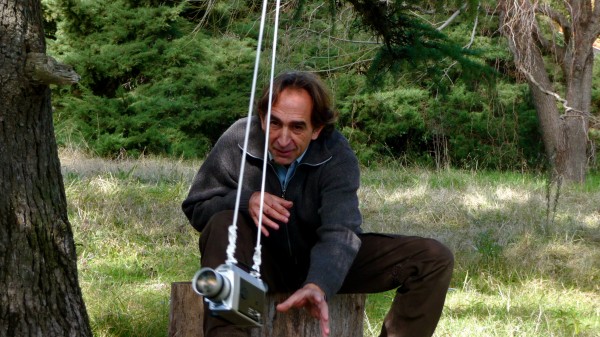
Claudio Caldini in a scene from Andrés Di Tella’s Hachazos (2011)
This interview with Andrés Di Tella was conducted during a retrospective of Di Tella’s films at last year’s edition of the Brazilian documentary festival It’s All True. All quotations from Di Tella’s book Hachazos were translated by Aaron Cutler from Spanish to English. All images courtesy of Di Tella unless otherwise noted.
***
A man brings all his work, all his life, inside a small leather bag purchased in India, on a train that goes from Moreno to General Rodriguez, by the western suburbs of Buenos Aires. They are the originals of his films, all in Super 8, an obsolete format, in danger of extinction, which does not allow the films to be copied. This bag is like the manuscript of his autobiography. It tells of Claudio Caldini, caretaker of a suburban villa, secret filmmaker.
These words open Andrés Di Tella’s 2011 book, Hachazos, which he calls “the diary of my encounters with Claudio Caldini.” The book’s subject is one of the survivors of a rich group of Argentinian experimental filmmakers who blossomed jointly in the 1970s, during the years of Argentina’s military dictatorship. (The nation resumed free elections in 1983.) Caldini’s films—twelve of which were digitally transferred and released on home video along with films by his compatriots last year through the boutique label antennae collection breathe like brilliant bursts. They are built with simple, repeated gestures, rendered in pulsating color: lit candles glide from front to back of a dark frame in Aspiraciones (1976); the bright green of leaves on branches soaks the screen as plants dissolve over each other in Cuarteto (1978). Sometimes, as in Gamelan’s (1981) fusion of a camera’s steady circular swing with a Steve Reich piece, the films are explicitly set to music. Their progressions of rhythms intensifying until reaching crescendo are always musical, regardless of whether the films have soundtracks. These are perfectly formed compositions.
Caldini’s life outside cinema has been far from one. His countryman Di Tella’s book tells—to the extent that its often closed, distant subject will allow—of how Caldini, dissatisfied aesthetically, politically, and spiritually, left Buenos Aires for the utopian ashram of Auroville in India. He ensconced himself so completely within his new community over the following six months that he was unable to readjust to Argentina upon his tourist visa-mandated return. He stayed inside his parents’ villa, then was sent to a mental institution, and closed himself within a series of walled spaces, including further trips to Auroville, throughout the 15 years that followed. The most sustained effort he made during this time—when he could make it—was filming. On his last trip to Auroville, he shot Heliografía [Blueprint] (1991), a record of a circular bicycle tour throughout which one senses the artist’s ghostly presence. Di Tella writes how, for him, the film sums up Caldini’s interest in exploring both nature and his perception of it: “The observer is part of what is observed and his gaze modifies what is seen.”
Di Tella could also be describing his own films. The half-Indian writer was born in 1958, six years after Caldini, and first met Caldini in the 1970s through his Hindu mother. Di Tella became a documentary filmmaker whose work has increasingly explored the tension he feels between himself and his very personal subjects. (Di Tella also founded Argentina’s largest film festival, BAFICI, in 1999, though he stopped working for the festival soon afterwards.) His early documentary, Montoneros, a Story (1994), a rigorous piece of journalism in which former members of Argentina’s strongest anti-dictatorship guerrilla movement recount life on the run while their faces betray both the pleasure and the exhaustion that they still feel from it, contains the filmmaker’s supportive feelings only implicitly. By contrast, his love for his subject is everywhere in the following year’s Macedonio Fernández (1995), a portrait of an Argentinian writer whose fictions inspire Di Tella’s film to create its own, including the possibility of having the author’s voice on tape. His love complicates The Television and I (2002), which begins as a search for the Argentinian television he missed while living abroad as a child, but becomes a series of discussions demonstrating his awkward relationship with his father, a television manufacturer, and a questioning of how his young son will grow up to feel about him. In Photographs (2007), Di Tella stretches himself even further. He gathers scattered documents to try to reconstruct his memory of his long-lost mother, then travels to India to meet relatives he’s never known, who tell him that they didn’t really know her either.
Di Tella interviewed Caldini for Photographs, though the footage ultimately was not used. In the decade following his last Auroville trip, Caldini moved through 36 different homes without steady work, finally settling down as the caretaker of a suburban villa. From 1998 to 2004 he served as the film and video curator at Buenos Aires’s Museum of Modern Art. He also, in time, began teaching a filmmaking seminar, found three Super-8 projectors, and transformed his art. What were once films became parts of performance pieces, with Caldini operating multiple projectors simultaneously. As part of the Hachazos project, Di Tella collaborated with him on several, performing research like transcribing interviews and reviewing photographs onstage while Caldini worked with his films. Di Tella eventually decided to make a film in collaboration with Caldini, though he knew that the work would be difficult. As he writes in Hachazos about the upcoming film:
The interesting thing about the project would be, certainly, that it would deal with two very different filmmakers, who incarnated two almost antagonistic conceptions of cinema. Narration and contemplation. Testimony and image. Figuration and abstraction. There was the conflict. It would not be a documentary about Caldini but a film made with Caldini. The record of a collaboration, a correspondence, a discussion.
Though Di Tella’s films are often both digressive and comic, his subjects determine their ultimate shapes and styles. Hachazos (2011), a companion piece to his book of the same title, is filled with long pauses and the sound of breathing, as Di Tella’s camera sits in close-up on Caldini’s face, waiting for him to speak. The film unfolds over a few days at the villa where Caldini works, as Di Tella tries to convince him to retell his story. Again and again, Caldini shrugs him off, saying that Di Tella is turning him into a fictional character. Di Tella doesn’t much disagree, and even goes so far as to enlist Caldini in staging literal reenactments of his filmmaking, with the older man once again swinging a camera from a tree and riding a bicycle in a circle.
Hachazos shows Caldini becoming a character in a story Di Tella is telling—a man whose life is incomplete without cinema. The closest we come to glimpsing this man’s inner workings is when we watch his films projected. It’s when Caldini projects pieces of Un nuevo dia (2001) —a reconstruction of a “disappeared” friend’s lost film made entirely according to his memories of the original—for Di Tella that he most fully shares his recollections of the dictatorship years. As he projects his films for his students, we glimpse the peace he has long sought.
A moment in both the Hachazos book and film shows Di Tella trying to read Caldini’s face after Caldini has described a dream he’s had. The dream is about living in a house that isn’t his; Di Tella speculates whether “the work of any artist, in any circumstance, is anything other than an inventory of his or her attempts to return home.” This speculation circles back to the project’s title, which in English means “Blows of the Axe,” and refers to the 1950s practice by Argentine distributors of chopping up film prints to prevent people from stealing and illegally projecting them. Caldini’s father, an electroplater and amateur film buff, would collect these film fragments and project them for his family at home. The Hachazos project, years later, shows both Di Tella and Caldini making art to project a fragmented past.
Often in documentaries, the story is told through archival footage and talking heads appear to flesh that footage out. In your movies, though, that seems to be flipped. Often it seems you’re presenting the past through archival footage, but the story is really in someone’s present-day face. Why?
I hate the idea of archival footage just illustrating what somebody’s saying. Often that’s the case, and I like to work against this practice. For instance, Prohibited (1997) uses the most archival footage among my films. I used news footage and official ads from the time of the military dictatorship in Argentina, but I was adamant that the footage would always appear with the effect that you were watching the thing in its entirety, for itself and not to illustrate something else, nor to be illustrated by someone else. I would sometimes leave the rough edges at the beginning or at the end, to give the feeling that you were watching the piece in its entirety, even in cases where I had edited quite a bit on account of length.
Still, I feel now that Prohibited’s narrative rhythm possibly pays the price for this. Montoneros, a Story is a different example. That film was originally made for TV in two 45-minute segments. It was a reaction against the format of the documentaries that I had been making for PBS, which were very, very anonymous and conventional, falling in line with archival footage of people talking and a narrator explaining everything. Here, we managed to give the few short pieces of stock footage that we had—it’s very difficult to get ahold of Argentinian stock footage in Argentina, and impossible to even think of buying international material—a narrative role in the film. They’re telling part of the story themselves.
I have to balance the facts that I want to be included or conveyed within the story that I’m trying to tell, because I’m telling stories, ultimately. Every moment that there’s somebody in front of the camera, something has to be happening. The moment must be alive. So I have to find some kind of unstable equilibrium between the fact that I need to tell a story and the fact that each particular moment has to have some life in it. People have to be vividly evoking something for themselves. Something has to be happening in a person’s face onscreen.
What interests you about Claudio Caldini’s face?
Caldini is somebody who can remain silent and make long pauses and remain somehow composed in front of the camera, which is a challenge but also a gift to the filmmaker. He is somebody who withholds a lot. This could be a disadvantage, and sometimes it is if you’re trying to make him tell a story and he won’t or can’t. But the fact that he will stop in the middle makes for a great documentary character, because at that point it invites the viewer in. One of the things you’re always looking for in documentaries is a way to allow the viewer in, not to have him just listen to a lecture. I tried to give Caldini a certain mystery as a way of providing doors through which viewers could enter. The less you give away about a character, the more the viewer has to imagine. And how does the viewer imagine the character? Through his or her own emotions and personal associations. I think that the viewer can thus try to imagine what is going on in Caldini behind his face.
How did you decide you would show his films?
Hachazos is not just a film but also a larger project, which includes a book. The project actually started as a piece of writing, with a strong biographical strand. Only subsequently did it develop as a film, which is far less biographical in its content. In between the book and the film, we jointly staged a series of performance pieces, with some theatrics, where I evoked different phases of the documentary process—reading documents, listening and transcribing interviews, reviewing photographs. And Caldini, on stage, would screen some of his material by operating multiple projectors. It was an odd kind of “live documentary,” made in the physical presence of its subject.
For somebody who’s only going to see the film, however, who’s never heard of Caldini or seen his work–and that´s the vast majority of the intended audience—the film has to work on its own terms, as a story. This film is not meant for experimental film buffs. The fact that Caldini is an experimental filmmaker, outside the conventional idea of what a filmmaker is about, is of course essential to the story. But in a way it is also almost incidental. He’s a filmmaker. He’s an artist. That´s what matters, as well as how, in a way, he’s a mirror for me.
But still, I had to show some of the work he has done. At one point I was thinking that it was impossible to include clips of his films, because I felt that the real experience of watching a Caldini film is actually in Super-8 projection, and even more so when it’s projected as he does in his performances, with three or four simultaneous projectors—he’s there, and the film gets stuck in the gate, and he has to cut it, and he’s sweating his head off. And that’s really where the magic lies.
So I knew that I would never be able to convey within my film the power that Caldini’s films have for me. But somehow, I needed them, because otherwise people might think that he was just a gardener. But I think that the film ultimately conveys Caldini´s uncompromising personality in such a manner as to convince the audience that what he’s doing is dead serious, however little you are allowed to see of it. What I did was to place his films within the context of an improvised screening that he was doing on a blanket inside his house for a small audience. We don´t see film clips, we witness a live screening. It’s just another scene within the film. It’s much more intimate. And it’s part of the story.
There’s a moment when you’re filming him during the last projection of his films and he’s blocking the middle of the frame.
Yes, because it’s a performance. And he’s part of the performance.
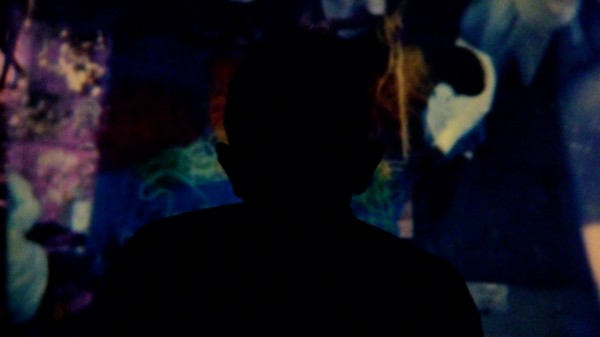
Claudio Caldini projecting his film, Tamil Nadu View (2010), May 2010. Photograph by Andrés Di Tella.
Hachazos’s most prominent sound effect is the whirring of a film projector. Why?
Partly because we were watching films all the time, and it was there. But there’s something nostalgic about its presence, too. Caldini is a fetishist about the materials of film stock and celluloid. I’ve never been—for years I’ve been shooting on tape, and then cards, or whatever it is that we shoot on now—but I do see something precious about the lost film world. Caldini is just the tip of that iceberg. He always considered himself a filmmaker, and never considered himself a visual artist, but 99 percent of Argentinian filmmakers today would not consider what Caldini does to be film. They would be happy if he said, “No, I’m doing art.” To me, though, connecting the identity of a filmmaker to the physical material of film is very moving.
Although I don’t partake in craving the material sense of celluloid, I do find that the loss of the experience of seeing films projected in a communal setting has impacted my life. Most of the films I see nowadays are on my computer or on TV. I hate for people to see my films in these contexts—I always thought that they were meant for the cinema, in the dark where you can concentrate and let your emotions work, whereas TV is the remote control. And yet the small screens are certainly where most people see my films. So you can be religious and say, “No, film must only be seen on film,” so Caldini’s films should only be seen in Super-8 projection in the dark, with Caldini himself projecting. And yet some of his films are on YouTube, and they have been released on Blu-Ray in the United States, and though he’s not entirely happy about this development, people get to see them. Some might be indifferent to what he’s doing, and some might say, “Wow.” And there’s hope in that.
How did you understand your own character’s role in the Hachazos story?
I say at one point that Caldini was the first filmmaker I saw in action. So he has always had this important symbolic dimension for me. I was still at school and he was shooting a performance by Marta Minujín, an important Argentinian pop artist who happened to be a friend of my mother’s. Minujín’s performance, called Autogeografía [Autogeography], consisted of symbolically burying herself alive. This was quite strong stuff in Argentina in 1976, when the anonymous corpses of victims of clandestine military repression were being buried by the hundreds. Caldini was shooting on Super 8 and I was throwing dirt on Minujín. This Super-8 footage appears toward the beginning of the film Hachazos.
In the rest of my film, Caldini is Caldini, the real person, but he’s also a bigger-than-life character in this story that I’m telling, and I wanted to make it explicit that I’m creating a character. To tell a story, you need a character, and a nonfiction character will always be a reduction or a magnification of a real person. I think that there’s a two-way phenomenon always happening with documentary characters. On the one hand, you’re inevitably reducing people, cutting out hours of footage, not to mention all that you’ve never even been witness to. So, in this sense, we’re a little bit like head-shrinkers. On the other hand, you’re paying so much attention to the slightest movement of a face, or to wordless breathing, and you’re working on the edit for months, striving to convey significance to each moment, that the character takes on a kind of monumentality. Suddenly it’s like you’re on Mount Rushmore! Making a documentary is always about navigating this mixture of head-shrinking and Mount-Rushmorization. The construction of this Caldini character, as with all documentary characters, is a work in process.
That’s why the discussion we have in the film over the symbolic nature of Caldini’s bag becomes so important. I saw that he had brought along all his films inside an old leather bag. You must remember these are all films shot on reversible Super 8, so that there are no negatives or extra copies, just the original prints. So I wanted to shoot a scene of the bag on the train. It seemed an appropriate symbol, both of his itinerant life and of the fragility of the artist and his work. But he refuses to play along. I saw the bag with the films. But he says that that only happened once. Does the fact that it only happened once make it untrue? Is it not representative, therefore not real?
Including the conflict over the bag was a way of pointing to the conflict in all documentaries between storytelling and reality, fact and fiction. Caldini himself says at one point: “This is fiction. This isn’t something that I would do. I don’t feel comfortable doing that.” There are other points where he says, “I don’t think this conversation is going anywhere,” or “It’s not organized properly.” I value comic timing very much, and I think it’s welcome in documentaries, especially this quirky thing where sometimes you don’t know if it’s supposed to be funny or not. So, on a basic level, the scenes are funny. But I really put those moments of disagreement in to show a tension between the real person and the character in a story. Like the bag, the Caldini of my film is torn between the man and the symbol.
My own character—the “filmmaker”—has an important function as a stand-in for the spectator. In a way, the question of the film becomes: why am I interested in this man? My character is looking for something and possibly finds in Caldini something other than what he was looking for. There is no pretense at objectivity. Often in documentaries the relationship between the people making the film and the people being filmed is hidden. And sometimes this raises an ethical concern, which is why is that relationship hidden? I wouldn’t go so far as to say the stuff behind the scenes is the most interesting—it has to be in homeopathic doses, because it can be too much of a good thing—but what’s really happening in a documentary is the development of a relationship between the filmmaker and the subject.
As a result, there’s always a little bit of “meta” in my films. I must confess that I am always curious for making-of stories. I often prefer books about how a certain book was written over the original book itself. For instance, I recently bought Boswell’s Life of Johnson, and I had a hard time plowing through it. Then a friend said, “You have to read the book about Boswell, which is much better.” It’s a wonderful book about the making of The Life of Johnson, and it helped me. I have this unhealthy appetite for the how it was made, both in other people’s work and in my own. Hachazos is autobiographical, as is Photographs (2007), both of which are films that are reflexive about the filmmaking process, even to the point of using outtakes. There’s one moment that I particularly like in Photographs that happened because the cameraman Victor Gonzalez had either forgotten to turn the camera off or accidentally turned it back on. He was cleaning the camera lens and complaining about the fact that I was late. We’re on a shoot in India and the director is late! You only catch half of what he’s saying, because the camera’s out of control. And that scene, to me, conveys my situation of being in India, trying to make a film about my family, feeling jetlagged and in a feverish state, unable to organize a film around what I wanted to do, more than anything else that we shot. The moment was a mistake, something that should have been thrown on the cutting room floor, and yet it was alive, and it was saying a lot about what was happening.
So I never use this background making-of material just for its own sake. It’s always telling part of the story. These discussions between Caldini and me over how he’s being represented in Hachazos go to show you that it’s not just his story. It’s also my story, as well as ours.
How did the collaboration between you and Caldini work? How did you shape the film together?
That’s a very good question, but it’s not easy to answer. Part of the process went simply as it does in any documentary. You propose something and the other person accepts it or turns it down, or he may propose something that you are interested in or not. Sometimes, even if you don’t like the person’s idea, you film it in the interest of placating him or her, and it may surprise you. In this case, I suggested we reconstruct how he shot his old films because I basically didn’t know what we were going to shoot besides his work as a gardener! But I suspected that something might come of it.
What Caldini does, when he’s making a film, would not be recognized by most filmmakers as pertaining to the same activities that they pursue. That’s why I thought it would be interesting to see him hanging a camera from a tree or swinging it over his head like a lasso or shooting from a moving bicycle. At one point he had been painting Super-8 frames in ink and I wanted to show him washing his hands afterwards. But he refused to let that be included because of the calamitously messy state of his bathroom. To me, the bathroom was evidence of how he didn’t care about material success, but to him it was possibly humiliating. In general, he was very happy for us to be there making a film about him, but he was not happy to be portrayed as the caretaker of a villa. He wanted to be seen as a filmmaker. But he was both things.
He had some other objections to the film of Hachazos, like the sequences not respecting the order of the seasons or there being too many cuts—points that conflicted with his own ideas about filmmaking. But I think that one of the major things that he didn’t like was that the film was showing something that he wanted to hide, even though he had let us in. In my experience, people have very strange ideas about what a film is going to do, what it’s going to show and what’s it going to tell. They always imagine something, but it’s a secret, like a secret desire that often remains hidden even to themselves. And it’s rarely the same thing that you have in mind, no matter how much you’ve explained your aims. I think that documentary subjects believe that they will be able to control the film much more than they can. I mean, I can’t control the film that much myself, even though I spend months trying to make it mean one thing and not another. But I am also learning to let go, to let the film tell me what I have to do.
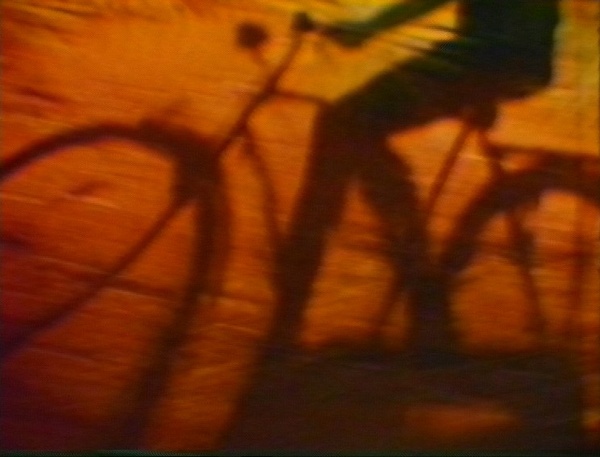
Image from Claudio Caldini’s Heliografía (1991) (Image courtesy of Centre de Cultura Contemporània de Barcelona)
With all that said, I worked with a lot of trust, which came from the investment in hours and hours of being with this guy and talking and writing, and so Caldini wasn’t nervous. For me, trust is basic. But even within that trust, the other guy could be thinking that you don’t know what you will end up doing, and you could be feeling the story dictating certain decisions that you can’t go against, even if you know that he might not like them. For instance, I found the last shot of the film, a close-up of Caldini as he leaves the villa on the back of a truck, pretty powerful. As we said, his face has a wonderful quality that allows you to project onto it, but at the same time it retains this opacity that prevents you from really knowing what is going on inside his head. And he hated that shot, because he said he looked sad—he would have closed with a previous, slightly wider shot, where he seems to be in better spirits. But to me the film had to end on a close-up, because it’s a portrait. I couldn’t take it away, despite what he said.
How did you find the film’s structure leading up to that?
I think that the story structure of Hachazos came partly out of the experience of shooting it. There’s this idea that film characters must turn in a way, undergo some kind of transformation, make some kind of change. It was so difficult to get Caldini to reveal himself that the film became predicated on how, at a certain point, we fail. I almost give up. Until I come across an idea. He made this film about this other experimental filmmaker—he actually never finished it, but he made the attempt. So I thought, let him tell this other story and maybe that way I can get to his.
I had been interested in the film that Caldini couldn’t make, but I hadn’t previously thought that it would become a turning point. In truth, I discovered this turning point in the editing room. Editing was tough. We made this film for about $40,000—not much money at all for a film—so I edited myself for a long time. I had an editor who is also a filmmaker, Felipe Guerrero, come in for a month to reedit my cut. I had some more time with the film by myself and then he came in again for two more weeks and that was that. The way it is with an editor, sometimes you stay away for a few days while he works and then he shows you something. You want somebody to help you. Not just that—you want to lose power, you want somebody else to make the decisions. Felipe made me throw out an entire subplot. He was very good, because he had ideas that were contrary to mine, and he fought for them. That´s the most you can ask of an editor, to fight for his own ideas.
What was Caldini’s role in the editing room?
None. I showed him a pretty advanced cut. He had previously read several manuscripts of the book, and he had seen some of the film material because we had created the performances. (We did some before making the film and some after the film’s release.) Still, he compiled a long list of suggestions and objections, mostly formal. I could take care of two or three out of the list. But this is essentially because we are two very different filmmakers. To put it starkly, I believe in stories and he doesn’t. He’s a poet, and I’m a prose writer.
He later wrote to me, though, that he had become reconciled with the portrait of himself in Hachazos, and that he had never seen anything resembling my film, which coming from him was the highest form of compliment. I think he was happy with the general result of the film, and of course it generated a lot of interest in his work. In his long filmmaking career, he never had so much press! But what he thought he was going to convey through the film, what I thought I was going to convey, and what the film actually conveys are three different things. On the other hand, he loved the book and had very little to say about it.
How is the book Hachazos different from the film Hachazos?
Well, it’s writing as opposed to sound and images. And this is obvious, but even a talkative film, as most of mine are, likely won’t have as many words as the front page of a newspaper. The book, which is not very long—about 120 pages—still has enough words that you can explain in some detail a lot of circumstances that in the film may be simply assumed or alluded to at most. And the basic difference is that images allow for much more interpretation.
The book also has pictures to go with the words, to which all the reviews said, “Sebald.” Which is great, because I love Sebald, although I wasn’t thinking about him. But some of the major influences in my work are books rather than films. V.S. Naipaul’s mix of history and crossed destinies, his notion of the wrong man in the wrong place meeting another wrong man, was deeply influential in my work—or maybe my life—as is the emotional rawness in his writing about India and about his Indian family. I appreciate a lot of work in this memoir/nonfiction vein, and read all of what in Spanish we call auto-ficción. It’s a strange term. It’s not autobiography—it is autobiographical, but it doesn’t have to be the full truth. Ricardo Piglia is an Argentinian author who is constantly introducing mistruths into what he has written. We made a film together called Macedonio Fernández about the writer that Borges considered his master—some people think that Borges invented Fernández, and in a way he did. Piglia had an idea that I think is related to Caldini’s bag, which is that he had received a tape recorder from somebody that had a recording of Fernández’s voice on it. At that point I was uneasy about introducing a straight-out lie in what was otherwise a documentary, but I did it, because of the symbolic dimension it created and because it allowed us to introduce the idea of the mystery of a voice. Where does it come from?
There’s something interesting about the Argentinian attitude toward this kind of thing. I was recently talking to a young Argentine author named Patricio Pron who lives in Spain, and who wrote a book about his parents called El espíritu de mis padres sigue subiendo en la lluvia [The spirit of my parents keeps rising in the rain]. It’s quite a nice book. He said that in Spain everybody took it literally, as an autobiography. By contrast, in Argentina I asked him, “Is everything true?” And he said, “Everybody in Argentina asks me this.” We’re pretty skeptical. I don’t know why.
Does it have to do with politics? You say in The Television and I that “[a]s an Argentinian, it’s impossible not to talk about politics.” Politics seems to be everywhere in your films. And you end up addressing politics in this film through the effect that censorship had on the Argentinian avant-garde.
Not quite censorship, but rather simply living under dictatorship. I’ve lived in England and in the United States, and I think a lot of people in First World countries don’t really have a notion that their lives are changed or shaped or diverted by politics. Whereas in South America everybody knows that this is the case. It’s very hard to live here without awareness of one’s political circumstances. Claudio Caldini is a perfect example of somebody who was never even remotely interested in politics, and yet whose life was changed by it.
I really like stories with an epic feel, and I think that that feeling usually comes from the intermingling of an individual’s private life with the winds of history and of political change. This intermingling is often tragic—you imagine something completely romantic, your expectations are dashed as it becomes a dictatorship instead of a socialist utopia, you end up in a dungeon and you have to survive. That´s the narrative of Montoneros, a Story. I discuss in the book Hachazos how Caldini went from Argentina to Auroville, which is meant to be a utopian place in India. In my own life I’ve traveled as well. My parents left Argentina for England in 1966 because of the dictatorship, and I myself went to study abroad in 1976 on account of a new military coup. Even though I wasn’t a political exile, I can still identify with Caldini. You couldn’t breathe in Argentina. It was a numbing and oppressive atmosphere, even if you weren’t part of the guerrillas or being actively persecuted. It wasn’t just that they persecuted political opponents—they cut out all the sex scenes out of the movies!
At the same time, as Beatriz Sarlo, a prominent Argentinian writer who edited an underground magazine back then, says in Prohibited, “Some of the happiest moments in my life happened during the dictatorship.” The intensity of what was at stake made simply editing a little literary magazine that hardly anybody would read into something epic. It was an act of resistance, deliberately and consciously so. Caldini’s Super-8 films were, too. The stuff that he was making, both the films and the screenings he held of them, offered a resistance to the dictatorship. Making films that people couldn’t understand was subversive. And of course Caldini was a utopian, because he imagined that someday everyone would be able to see and understand them.

An image of Andrés Di Tella’s notebook, taken from Hachazos (2011)
Text 1: In 6 minutes of film he synthesized 6 years
Text 2: The three screens
Text 3: To make films the same way we live/To live the same way we make films
At the end of the film Hachazos, you say that the next film you make will be different. What does this mean?
It’s a way of acknowledging the transformation that I’ve been through. I am a different filmmaker from the one that began the film. Hopefully it will somehow echo the experience of the viewer. But is also something I feel whenever I’m finishing a film. Making a documentary is often tantamount to digging yourself into a hole in order to try to dig your way back out. It’s a way of swearing that I will never make the same mistake again. But it’s also a variation on Beckett’s famous words: “Ever tried. Ever failed. No matter. Try again. Fail again. Fail better.”
Postscript: Both Caldini and Di Tella have premiered new film works since the Hachazos project’s completion.
]]>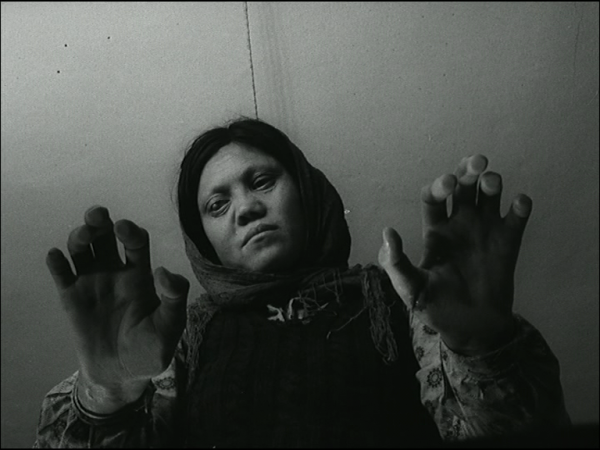
The House Is Black (Forough Farrokhzad, 1963)
Extreme affliction, which means physical pain, distress of soul, and social degradation, all at the same time, is a nail whose point is applied to the very center of the soul… He whose soul remains ever turned towards God though the nail pierces it, finds himself nailed to the very center of the universe.
– Simone Weil
The House Is Black opens with a zoom and ends with a retreat. At first we can’t see a thing—we need to be prepared. “On this screen will appear an image of ugliness,” a male narrator tells us, “a vision of pain no caring human being should ignore.” After a moment of silence and darkness, a woman’s face appears, or something like a face. We flinch; the camera doesn’t. It zooms in, holds, and holds some more, urging us to look. Twenty-two minutes later, the camera recedes, this time away from a large crowd. A gate clanks shut in its wake bearing two hastily scrawled words, less a name than a warning: “Leper Colony.”
Forough Farrokhzad made The House Is Black in 1963, during a twelve-day stay in the Baba Baghi Leprosarium. It is, or was, a small outpost on the outskirts of Tabriz, in the East Azerbaijan province of Iraq’s mountainous far north. As shown in The House Is Black, Baba Baghi is a place of dust and brick; the walls are whitewashed, the trees dead. Scattered leaves float in pools of standing water. In the streets people dance, laugh, play games, scuffle. Kids run around and hurry to school. We almost forget their flaking skin, their missing hands and feet, their drooping lips. We never really forget, though: their suffering is too close, too visible, too present. Here, affliction touches everything.
***
Three voices make themselves heard in The House Is Black. The first is a man’s, careful, steady, precise. He tells us what leprosy is, that it’s chronic and contagious; that it eats away at the body, blinds, deafens, invades. What kind of world this is in which leprosy exists, what these men and women did to deserve their affliction, doesn’t interest him, at least not directly. Two thoughts guide him: that suffering exists, and that we ought to stop it. “To wipe out this ugliness and to relieve its victims,” he tells us before the film’s first shot, “is the motive of this film, and the hope of its makers.”
“Leprosy goes with poverty,” we’re told. It destroys the body, but it also sections off its sufferers from the social world, crosses them out from the books. They aren’t just afflicted, they’re ignored. Simone Weil, in her essay “Forms of the Implicit Love of God,” imagined the marginalization of the poor and afflicted as a steady process of de-humanization, the sole thing capable of reducing a human being to “the state of an inert and passive thing.” True charity is to return the afflicted their humanity, their claim to justice, even their very existence; it is also, conversely, an act of self-sacrifice, a conscious choice to take up “a share in the inert matter which is [theirs].” Before she even had a chance at dignifying her subjects, Farrokhzad had to risk sharing quite literally in their affliction: leprosy is contagious, and it’s hard to watch The House Is Black without thinking how great a risk it took just to keep the camera rolling inside those walls.
That risk taken, Farrokhzad found herself with another challenge: how to film the afflicted so that they inspire not just pity or respect, but affection. It’s easy to consider these lepers as noble, painted icons of suffering. It’s harder to see them as people with whom one might converse, argue, or crack jokes. Those of us who make it through the first shot of The House Is Black will have acknowledged these lepers’ presence; now we must recognize their humanity.
Farrokhzad’s first step was to have the afflicted speak for themselves. Their collective voice, the second of the film’s three, might come from many speakers, but it has a common theme. Toward the end of that first shot, we hear a young, pockmarked boy praying out loud. “I thank you, God…” he reads. “I thank you for creating me.”
Once we give these lepers our attention, we might expect them to protest their lot, to demand attention from a society that’s long ignored them, to say to all who might listen, we don’t deserve this. Some of us might even want them not to stop at their fellow men: why not go to the ultimate source of their affliction, bring their complaint to the feet of God? That, having been given a platform from which to speak, they choose instead to supplicate themselves before God, demanding nothing and accepting everything—and with gratitude, no less—is beyond comprehension. Was Farrokhzad, in giving these lepers the right to demand justice, really giving them the opportunity to renounce that right all over again, this time of their own free will.
If there’s one lesson to be gleaned from The House Is Black, it’s that the afflicted don’t always think or act as we expect them to—that they often refuse to play the role of the dignified victim. Theirs is a community forged by affliction, but not necessarily defined by it. To respect the inhabitants of Baba Baghi as free agents like ourselves, not just lumps of pitiable flesh, means to honor their intentions even when they seem voluntarily to shrug off the very rights Farrokhzad has been trying to win for them. What if they don’t care for rights, claims, or complaints? What if they don’t even care for justice as we might define it—or, still more bafflingly, what if they find their situation just? Charity is quick to point fingers in favor of its charge; it takes a very different sort of empathy to grasp that life, seen through the eyes of the afflicted, might be something to receive not with indignation, but with gratitude.
“I thank you for giving me eyes to see the marvels of this world,” prays one young boy, squinting through drooping eyelids. Farrokhzad gives us a tall order: to see in the dusty alleys and ramshackle streets of Baba Baghi what that boy sees, to trade our way of looking, and feeling, for his. The House Is Black does more than challenge us; it overrides us, beats us down. It can never do so fully, of course, and that failure on the part of the film to make us see anew is really a failure, inevitable but disappointing, on our part—a failure to see these lepers as they see themselves, as defined by something apart from their affliction. It is, ultimately, a failure of empathy. Still, there are occasional breakthroughs: in one late-film scene, we dart with Farrokhzad breathlessly from team to team in a children’s soccer game, hooking, diving, hopping, bouncing around. Maybe at that instant we’re capable of forgetting the kids’ affliction, or at the very least of letting it slip off to the background, replaced by the arc of a soccer ball in mid-air, the rush of bodies through space, the fall of light on hair and skin.
There are limits to identification. We want to demand relief for the meek and afflicted–all the more so if, out of their unconditional love of life, they never demand relief for themselves. The more these lepers consider themselves blessed, the more inclined we are to take count of their blessings and find them lacking. The House Is Black, then, is a film torn between two diverging desires: the desire to identify with the afflicted so completely as to take on their way of seeing, and the desire to defend them from the balcony, to argue their cause to the world. Both find an uneasy balance in the film’s third voice, Farrokhzad’s own. That’s her in an early scene, looking on at a schoolroom of leprous children knee-deep in prayer, asking a question that is really a challenge: “Who is this in Hell praising you, O Lord?” In other words: Who in Hell would praise you? Or perhaps: Why would those who praise you be in Hell?
The voice belongs to Farrokhzad, but who’s speaking? Sometimes first-person, sometimes third, neither internal monologue nor outsider testimony, at once collective and personal, this third voice seems to float from speaker to speaker, subject to subject, soul to soul. It’s the voice of a community, but also of its defenders, including those behind the camera. It tends to appear over footage of nature, perhaps recalling Christ’s prediction that if his disciples fall silent, “the stones themselves will cry out”; though if they cry now, it’s likely more out of sorrow than joy. Late in the film, an aging, one-legged man hobbles toward the camera, framed by rows of trees, backed by the setting sun. Meanwhile, Farrokhzad reads a few verses, derived from one of Isaiah’s especially pained laments:
Alas, for the days are fading,
the evening shadows are stretching.
Our being, like a cage full of birds,
is filled with moans of captivity.
And none among us knows how long he will last.
Like doves we cry for justice…
and there is none.
We wait for light, and darkness reigns.
There’s not much anger here, and what little there is, it’s muted by a sorrow so profound and so total that it doesn’t allow for righteous indignation. But it’s a sorrow suffused with hope, and made still more acute for it; in the high-contrast, black-and-white world of The House Is Black, patches of shadow look all the darker next to comparatively blinding streams of light. The two seem often at odds, sometimes ill matched: in this instance, that one-legged man marches toward the camera until his body engulfs the frame in dark. For a few seconds, we hear only the repeated clanks of his walking stick. Then, a child’s voice, reading aloud: “Sometimes at twilight we see a bright star.” For most of The House Is Black, light and dark are present onscreen in equal measure, vying for control, but perhaps the lepers’ condition can best be expressed by light’s absence, or at least its deferral—by light as something not yet attained, but longed for, glimpsed, and expected.
Near the end of the film, a child sitting in class is asked to name a few beautiful things—the moon, the sun, flowers, playtime—and another a few ugly things. “Hand,” he replies, giggling, “foot, head.” A third has to come up to the blackboard and use the word “house” in a sentence. He hesitates, turns, and slowly writes out, the house is black.
There are many films in which the beautiful and ugly coexist, and many that propose some way of easing the resulting tension, whether by giving one the last word, or (less frequently) by reconciling the two. The House Is Black doesn’t propose a thing. It’s a film not about striving, ascending, or transcending, but about waiting—sometimes patiently, sometimes fitfully. There is beauty, but not enough to compensate for affliction; hope, but no sign of its fulfillment. No sign even of an object on which hope could settle, any potential source of grace.
Well, maybe one. If in watching The House Is Black we witness and even briefly participate in the giving back of humanity to the afflicted, if it was by filming these lepers that Farrokhzad managed to return them their dignity, if not their health, then perhaps The House Is Black is in some meager and incomplete way its own source of grace. For twenty-two minutes, these men and women have the chance to see their shattered bodies re-written in light—if only on a screen, by the flickering glow of a projector. They haven’t been healed, but they’ve seen their present sufferings reproduced in a new, immaterial substance, one untouched by bodily affliction. It isn’t a solution, but it might at least be a promise.
]]>